Physical Address
304 North Cardinal St.
Dorchester Center, MA 02124
The use of image-guided interventional procedures has become ubiquitous in every hospital in the world. Although diagnostic imaging has improved the diagnosis of many disease processes and facilitated the implementation of patient treatment, interventional procedures have truly revolutionized the treatment paradigm. The treatment process can be initiated only after a definitive diagnosis is confirmed and the biopsy procedures provide the obligatory histopathologic diagnosis. With reported experience in the field, the specific roles of fine-needle aspiration (FNA) and core biopsies have been defined to permit optimal diagnosis of pathology and anomalies with very high levels of safety. Image-guided interventions have evolved into definitive treatment procedures such as fluid drainages and tumor treatment and ablation.
Nonvascular image-guided interventions have continued to increase in recognition, frequency, complexity, and success rates and have finally gained their appropriate role in radiology practice. Although other subspecialties (vascular surgery, cardiology) have captured major portions of the vascular field, nonvascular image-guided interventions can remain part of the radiology field if radiologists incorporate them into their practice as an adjunct to diagnostic imaging; superior diagnostic skills are obligatory for superior image-guided interventions.
In our opinion, image-guided interventions are the key for preservation of the radiology field as a subspecialty. Imaging advances such as multidetector computed tomography (MDCT), three-dimensional (3D) reconstructions, and computer-assisted diagnosis facilitate visualization of normal anatomy and enhance the diagnosis of disease for radiologists and nonradiologists alike, but radiologists are familiar with the subtleties of image interpretation required for high-quality interventions.
The future of image-guided interventions is bright, but excellence must be fostered to protect the field of radiology. Although for the foreseeable future procedures will be performed manually, it is clear from initial robotic experiences that some type of robotic guidance will be forthcoming ( Fig. 67-1 ). Magnetic resonance imaging (MRI) and ultrasound (US) devices continue to be refined and are likely to become more efficient and accurate for image-guided interventions. Future hybrid machines will combine digital images based on topographic images and 3D reconstructions to facilitate placement and confirmation of instrument location ( Fig. 67-2 ). Radiologists must be in the forefront of such developments and applications.
In earlier editions of this book, it was challenging to find data and references to support our perspective on procedures, but now the challenge is to be selective among the many reports that are available in the field. Vast amounts of new information have been generated and published on all aspects of image-guided interventional procedures. We are pleased that the accumulated knowledge validates many of the principles we and others have espoused over the years. Although many of the techniques have not changed, their clinical applications have expanded so that now, instead of using the histologic samples simply to diagnose a problem, chemical assays and biomarkers are being measured. These biomarkers permit better prognostication, predetermine the sensitivity of selective chemotherapeutic regimens (e.g., estrogen markers, human epidermal growth factor receptor markers, tyrosine kinase growth factor receptor sites), and permit DNA clonality when appropriate. The National Institutes of Health (NIH) is facilitating further application of biomarkers measured from biopsy samples by encouraging the routine use of image-guided large-needle biopsies for biomarker assay by many new initiatives. It is hoped that special stains and tissue biomarkers will open the field of personalized patient care, which is contingent on earlier specific molecular or genetic diagnosis.
Equipment and devices have become more refined and user-friendly, facilitating the performance and positive results of most procedures. To simplify the acquisition of such samples and lessen the inconsistency of manual needle techniques, a wide array of automated needles are available in the marketplace. Relative to cutting needles in general, a survey by Mayoral and Lewis showed that 95% of liver biopsies were performed by cutting needle “guns.”
Some radiologists have looked at image-guided interventional procedures as time-consuming and not an important part of their practice. Financial considerations have been the driving principle for the bias not to use “scanner time” for such procedures. From a financial perspective, it is true that multiple diagnostic scans can be performed during the same time as several procedures, but this need not be the case if patient flow is organized. It is likely that interventional procedures will provide a mainstay for a radiologic practice.
Time efficiency for performance of procedures can be improved by many factors, including experience, designated interventional individuals, support personnel, and defined and refined processes. Clearly the more experience one gains, the quicker the entire process occurs. If only a few individuals are designated as interventionalists, their judgment, skill, and operational efficiency increase. Selecting and training the appropriate support personnel, such as technicians, nurses, and physician assistants, improves efficiency remarkably. With appropriate assistance, these support personnel can assume responsibility for patient selection, performing the patient interview, obtaining informed consent, performing laboratory studies, obtaining a pertinent medical and drug history, and writing preprocedure and postprocedure orders. When a well-qualified assistant is selected and properly trained, such an individual can even begin a procedure and save considerable time by selecting the patient position on the table, selecting and preparing the skin site, and administering the initial local anesthesia.
Although performance of interventional procedures may not increase referrals at all sites, these procedures can assist in maintaining referral bases. Most referring physicians appreciate how diagnostic biopsies facilitate patient care by providing a definitive diagnosis that permits initiation of treatment or an alternative therapy option in certain disease processes. Assisting in patient care improves the general reputation of radiologists among referring physicians and patients. The lack of such procedures in such a practice may erode the current referral pattern and result in referrals to other radiology groups or other competitive clinical groups. With computer-assisted diagnosis on the horizon, skillful image-guided interventional procedures require a higher level of interpretation than can be provided by a computer or other clinical groups, which in the future may entertain the possibility of image interpretation. Radiologists who are competent in image-guided interventions add unique value to the patient care process.
Although the cost is greater than for other examinations, the cost savings of a CT biopsy compared with alternative costs of surgery, hospitalization, or both are remarkable. Mitty and colleagues calculated a savings for CT-guided pancreatic biopsies of more than $3000 per case. Similarly, Silverman and coworkers found a savings of $3149 per case. Considering that more than half of all such biopsies are performed on an outpatient basis, the savings is actually more than that amount. By comparison, US is much cheaper, and MRI is much more expensive.
The senior author has performed CT procedures for more than 40 years ( Fig. 67-3 ), encompassing about 30,000+ procedures, and has observed many changes in the field. With the refinement and expansion of the imaging field, all modalities, including CT, US, MRI, and traditional fluoroscopy, are used for interventional procedures. The roles of the various modalities have changed and will change in the future as new developments and refinements occur. Although it is true that the choice of image-guided procedures typically follows the radiologist's own interest, expertise, and psychomotor skills sets, imagers should be familiar with the various modalities to enable the use of the best guidance modality for procedure success. This chapter imparts our extensive experience to radiologists who wish or need to be more proficient with CT procedures.
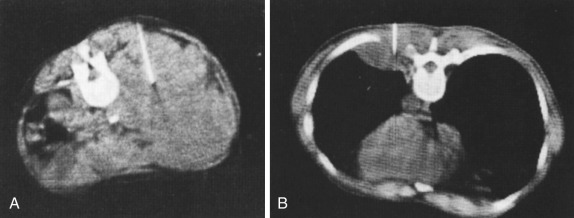
The information and insights we provide are based on extensive long-term research and decades of clinical experience. We originated and have helped refine many of today's CT-guided procedures and drainages (see Fig. 67-3 ). We are flattered that the official history of radiology by the American College of Radiology acknowledges that we innovated CT-guided biopsies, drainages, and treatments, and that such experts as former Surgeon-in-Chief at Massachusetts General Hospital Claude Welch noted our origination of CT-guided abscess drainages in the New England Journal of Medicine . Other contributions have included image-guided large-needle biopsies, radiation dose reduction for diagnostic and image-guided interventions, CT-guided radioactive seed placement, gas injection to move structures, percutaneous cecostomy, CT longitudinal scan (e.g., topogram, scanogram), CT-guided nerve blocks, and fibrinolytics to facilitate abscess drainage.
Reviewing the historical perspective of interventional procedures can be confusing if one takes a narrow viewpoint and assumes that their evolution in the past 50 years has been along a single pathway. If one takes an objective global viewpoint, however, one can see that the development of percutaneous procedures has been varied and has involved four separate disciplines: (1) image guidance methods, (2) instrument development, (3) clinical procedure techniques, and (4) pathologic and cytopathologic techniques. Incremental advances in these four areas have occurred concurrently and at times separately. For individuals who have a limited personal experience or take a cursory review of the literature, it is difficult to appreciate the overall perspective.
Many of the controversies related to needle sizes and types have been resolved in the intervening years since we first discussed them. The historical context we previously used to “defend” or encourage use of the biopsy instruments and drainage techniques is no longer necessary. Some discussion is still appropriate, however, because those who do not know history are condemned to repeat it, or some academicians may resurrect all concepts to build their careers until the concepts are disproved again.
When biopsies were first performed in the 1930s through the 1960s, they were performed at the bedside by clinicians without imaging. At that time, the selected organ, usually liver or lung, was located by physical examination. Entrance sites were chosen using palpation and auscultation with a stethoscope. The skin was prepared with antiseptic, but local anesthesia was not always used. The biopsy was performed quickly during a single breath hold, the theory being that if the needle was inserted and withdrawn quickly enough the patient would not feel it or would not move. Laboratory measurements of hematocrit and coagulation studies were not used frequently. Complications were frequent.
It is almost amusing in retrospect to reflect on two of the most important historical advances for unguided liver biopsies. First, it was discovered that the lateral intercostal approach was found safer than the anterior subcostal approach. With the clear knowledge of anatomy today, one reflects why they did not realize that the other contiguous organs, such as the stomach, gallbladder, colon, duodenum, and pancreas, could potentially be damaged by this path. Imaging guidance precludes this possibility. Second, the liver biopsy was proved safer when performed while the patient suspended respiration and motion. One eminent physician of the time, Menghini, gained great notoriety because he had the patient suspend respiration, and the needle was thrust in and out during 1 second. This practice prevented motion of the diaphragm and reduced the number of complications. His other great innovation was having a single physician apply suction with a syringe while inserting the needle; previously, one person applied suction by means of an attached tubing while the other inserted the needle. It is very strange to note that some physicians today are proposing the “old Menghini” two-person technique of the 1940s where two people perform a biopsy. One person does the needle work and the second provides vacuum with an attached plastic tube. (To each his own!)
Relative to guided procedures, Lundquist was the first to show the usefulness of “guided” biopsies using US and FNA; the sample was cytologic. The US for guidance was the B mode (before real time), which was used to mark the skin surface; no direct visualization of the needle was possible.
Lundquist's reported experience showed conclusively that this method was superior to “blind” procedures. He also reported the use of the 18-gauge Menghini needle (end-hole cutting needle compared with the side cutting needles of today) for selection of the needle entrance site. In a series of 1000 biopsies with the Menghini needle and 2611 procedures with the “skinny” needle, there was a very low complication rate; one hematoma occurred with the skinny needle. For perspective, one should realize that in the 1970s, the imaging technology was such that only extremely large and numerous lesions could be visualized and even considered for biopsy.
From today's perspective, it seems inconceivable that any controversy about the effectiveness or specific benefit of FNA versus core cutting needles existed, but at the major meetings of the 1980s and 1990s, debates about skinny needles versus large cutting needles were extremely controversial and charged with emotion. Proponents of skinny needles used references from the unguided biopsies of the antiquated days of the 1950s and 1960s to counter the benefits of larger needle samples.
With the unguided biopsies, a variety of core biopsy needles were designed and evaluated; a brief summary is important because invariably vendors reintroduce different permutations of these needles periodically using a different name. A prospective series in 1978 by Perrault and associates showed no complication difference among the Vim-Silverman, Menghini, and Tru-Cut needles. The comparison by Bateson and colleagues in 1980 of the Tru-Cut needle and the Menghini needle (end cutting needle) showed no diagnostic or other complications, although the physical integrity of the sample was more consistently intact with the Tru-Cut needle, especially with cirrhotic livers. Large cutting needles were not used routinely in imaging until the 1980s, when our group published numerous articles about the basic characteristics of needles, the diagnostic yield of larger needles, and the comparison of outcomes with skinny and cutting needles. In the 1980s, we were accused of “malpractice” for using such needles because of the “reputed” dangerous complications they posed for patients, and yet today we believe some physicians may overuse cutting needles and do not follow the guidelines similar to ours, which ensures a low complication rate. It is ironic, looking back at the early days of interventional procedures, that it took 2 intense years of reviews and negotiations to get our first paper on lung biopsies and cutting needles by Goralnik and coworkers published, and now such procedures are commonplace and perhaps overused (see “ Lungs and Mediastinum ” under the heading “ Selection of Cutting Needle Type and Caliber ,” later). We initially proposed the routine use of such needles in 1979.
Since the 1990s, the superiority of cutting needles has been repeatedly documented and confirmed. Such large needles are used preferentially in all organ systems, with excellent results and acceptable complication rates. Having championed their usage, we remain enthusiastic, but we believe that careful choice of patients, lesions, anatomic approaches, and use of contrast material is important to balance the benefit and risk for each patient. With proper techniques, the diagnostic yield approaches 95% and the complication rate is less than 1%. Some physicians use cutting needles without appropriate patient selection and precautions (see later sections).
There was a period of about 25 years (1950-1975) when traditional x-ray fluoroscopy was used for aspiration biopsies and fluid aspiration procedures, but these procedures have for the most part fallen into disuse. In the 1970s, US and CT were introduced as guidance modalities. US was introduced as a biopsy guidance system by Holm and colleagues in 1975. CT guidance was introduced by Haaga and Alfidi in 1976. MRI procedures were pioneered by numerous authors, most notably Lewin of our group, who reported many animal studies and human trials ( Fig. 67-4 ).
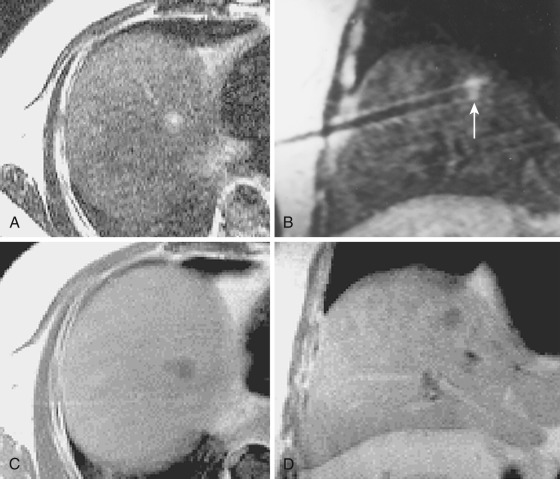
This chapter provides insights and details for CT procedures. The reader is referred to other texts and articles for more details regarding US or MRI procedures. The experienced imager should be familiar with all major imaging systems and should have at least passing familiarity of the various techniques and preferably hands-on experience for procedures. One should strive to become expert with any modality used for procedures.
The major general tenets for choice of guidance modality are as follows:
Act on the behalf of the patient and use the modality best suited to achieve favorable results.
Choose the modality for the right reason—improved visualization of the lesion or equipment—not because it is the “easiest” or most convenient for other reasons.
Minimize risk in all circumstances.
Never let ego determine the course of the procedure; never hesitate to terminate a procedure if things are not going well.
If the patient has significant comorbidities, do not push the limits unless it is critical for the patient's survival; adverse events may occur from a comorbidity, and if it occurs, the procedure might be inappropriately blamed.
If general anesthesia is needed or the lesion is unsuitable, cancellation is better than a complication.
It is reasonable to combine the advantages of several imaging systems for procedures, as has occurred with diagnostic equipment. If an operator is more comfortable with US than CT or vice versa, he or she may wish to combine the two as appropriate. US can show real-time placement of an instrument conveniently, whereas CT is unparalleled in documenting precise needle placement. Combinations with MRI and US and CT and positron emission tomography (PET) are likely for procedures.
CT uses a beam of radiation to penetrate virtually all natural and artificial materials within the human body. Information concerning attenuation of these substances can be measured and an image can be reconstructed. Because of the wide latitude of imaging capabilities, an extremely low-density material (e.g., gas) can be imaged, as can high-density materials such as metal, bone, or synthetic catheters ( Fig. 67-5 ). In addition, CT is sensitive enough to detect subtle abnormalities such as fluid densities, cysts, or gas-containing small pockets or fistulas ( Fig. 67-6 ).
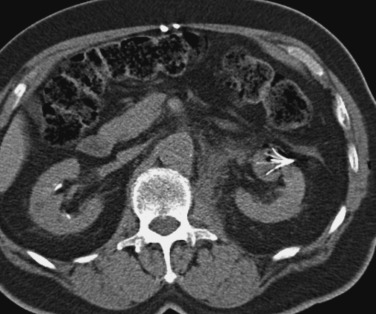
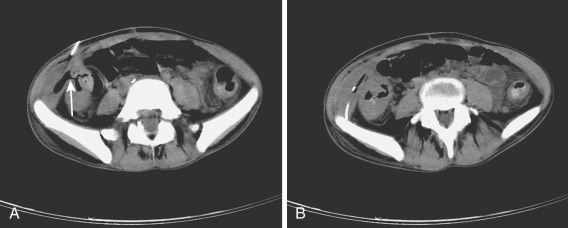
The ability to image high-density material accurately offers wide versatility so that any type of instrument (i.e., needle, drainage tube, or other device) may be used in a procedure. Contrast material can be injected when vascularity, an anatomic space, or an abnormal cavity needs further delineation. An abscess can have unpredictable serpiginous tracts or communicating channels that can be difficult to perceive unless contrast material is used ( Fig. 67-7 ).
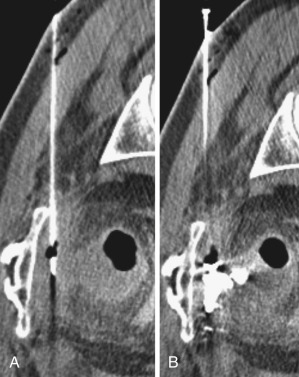
Because the CT unit uses an air interface, it consistently provides detailed and complete image even in patients with skin issues. In patients who have draining sinuses, wounds, ileostomies, scars, or other unusual surface problems, the examination can be performed without difficulty. Another advantage is that the longitudinal scan (e.g., Topogram, Scoutview) that we originated is now available on all CT scanners, making it possible to obtain conventional radiographs of the anatomy and to visualize instruments or catheters during insertion or manipulation.
Finally, real-time CT fluoroscopy can be used for cases of very small mobile masses or abnormalities. With the evolution of patient referral, lesions sent for biopsy have become smaller and smaller, testing the skills of even the most experienced radiologist.
The potential accuracy of the CT-guided method can best be appreciated by examining a schematic drawing of a cross-sectional image (see Fig. 67-1 ). If the instrument is placed within an anatomic area and the CT scan shows the needle in that area, the needle must lie within the 10-mm section of the abdomen corresponding to the CT section. Location of an instrument in this plane is limited by the section thickness, which is 10 mm; the resolution in the z axis is +5 mm. If one uses narrower slices, such as 5 mm, the accuracy in the y-z plane is +2.5 mm. Resolution of the CT system in the x-y plane is less than 1 mm with modern scanners. The precision required to determine the position of such an instrument is less limited by the resolution of imaging equipment than it is by the degree of the operator's accuracy, as determined by manual dexterity and by the degree of accuracy of the guidance system, rather than by the imaging equipment. Because of the increased detection of smaller lesions, incidental findings must be managed, and a definitive biopsy would be the best alternative; robotic assistance that positions the device during real-time fluoroscopy would be required.
The ability to localize the needle tip consistently and accurately in an axial plane is a distinct advantage of CT over fluoroscopy or US. Although fluoroscopy can provide multiplanar visualization of a needle or instrument, it is incapable of directly visualizing soft tissue abnormalities except in the chest. Fluoroscopic localization of instruments depends on indirect information obtained from displacement of contrast-filled structures (e.g., bowel, biliary).
The special advantage of CT guidance is that visualization of the needle is a foregone conclusion, and special technical approaches or concerted efforts are not required to visualize the needle. CT is not as sensitive for subtle lesions, however, and occasionally the combination of MRI and CT guidance can prove worthwhile ( Fig. 67-8 ).
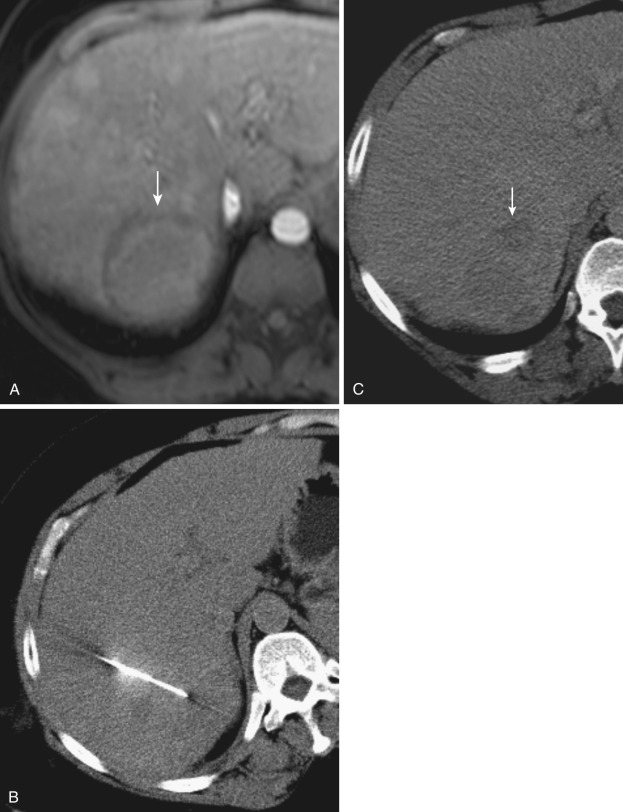
Versatility is still one of the most valuable advantages of CT-guided procedures. There is significant versatility in selecting the entry point for the biopsies because of the completeness of the CT image: a full 360-degree view of the patient is provided. All organs, including the bowel, are visualized so that a variety of needle pathways can be chosen. It is possible to choose appropriate pathways to avoid specific organs or the bowel if clinically indicated. Changing the body position of the patient may be advantageous for opening windows for instruments because of organ shifting or patient comfort (changing positions creates no adverse effect on image quality). Finally, a wide variety of instruments can be used, ranging in size from a 23-gauge Chiba needle to a 14-gauge Tru-Cut needle. Of all of the advantages of CT procedures, versatility is the one that is least recognized.
Varying the patient position is useful for patient comfort or for planning and execution of the procedure ( Figs. 67-9 to 67-11 ). As noted in the subsequent clinical sections, three major benefits are derived. First, if patients are going to cooperate during a procedure, it is crucial that they are comfortable on the table. Patients with back pain or localized discomfort in the flank can be induced to remain still during a procedure if they can become comfortable by shifting their position. Permitting the patient to lie in a prone, lateral, or oblique position can go a long way toward improving patient comfort and cooperation and success of the procedure.
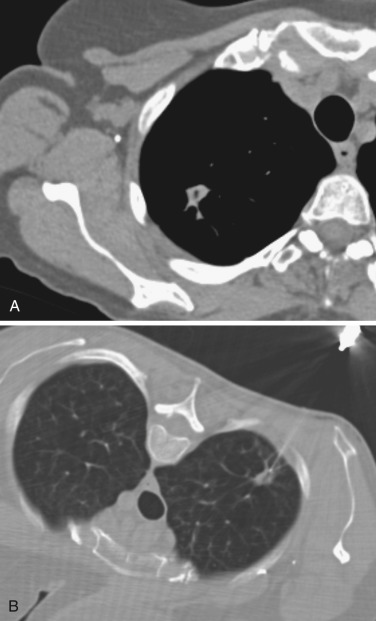
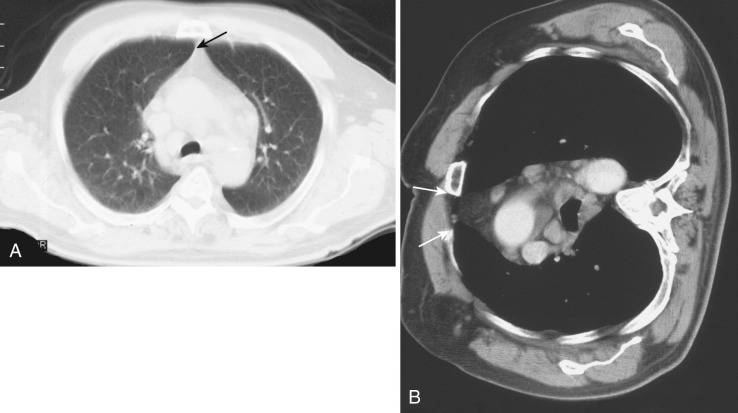
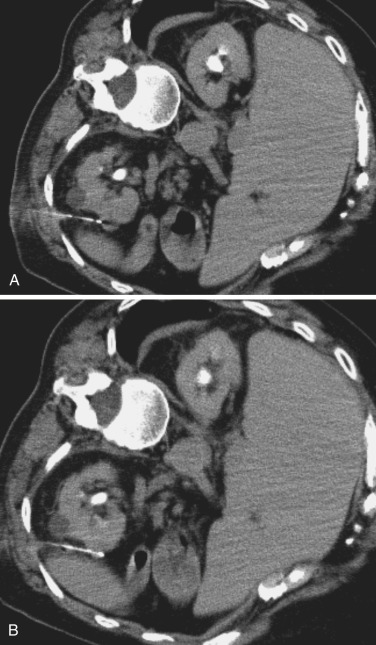
The second benefit of moving patients into different positions is that the internal or external anatomy shifts accordingly and permits better and safer trajectory planning and execution. For chest procedures, such movement may permit displacement of the scapula, making a posterolateral approach easier (see Fig. 67-9 ). Within the chest, lesions in the anterior mediastinum can be sampled more safely because positioning patients on their side may shift the anterior junction line sufficiently to permit a pathway avoiding the lung parenchyma (see Fig. 67-10 ). In the abdomen, bowel and organs shift sufficiently to permit a safer sampling procedure.
Third, in some cases when a patient has difficulty taking reproducible breaths and the lesion is mobile, placing the patient in a lateral or oblique position can help in limiting the movement of the lesion. When the ipsilateral side of the patient is dependent, the weight of the viscera partially immobilizes the diaphragm and limits movement of the lesion (see Fig. 67-11 ) even when it is in various precarious sites, such as adjacent to the spleen.
It is perplexing that some radiologists do not change the patient position or trajectory of the needle to avoid uninvolved structures. By varying the patient position slightly, it may be possible to produce movement of a loop of bowel, permitting an anterior biopsy without traversing bowel ( Fig. 67-12 ). In other cases, one can approach retroperitoneal lesions posteriorly through the flank instead of traversing bowel or other structures by using an anterior approach. Although traversing bowel is seldom a problem, in selected cases, secondary infection may develop from a microcontamination ( Fig. 67-13 ).
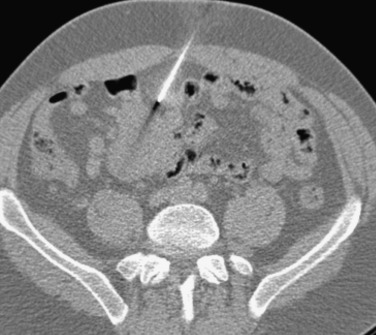
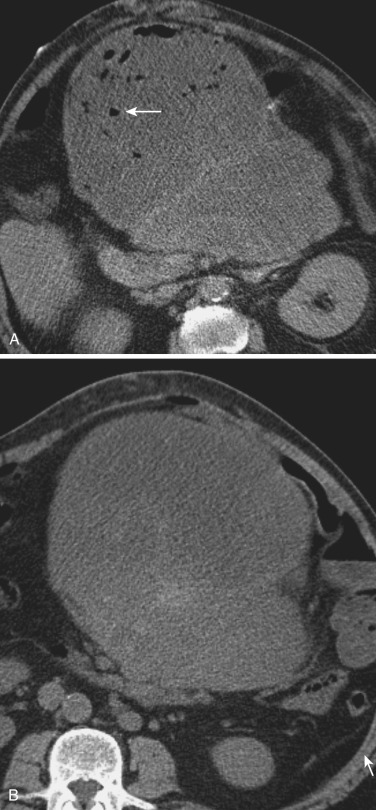
Occasionally it is beneficial with simple and complex procedures to perform 3D imaging with axial, coronal, or variable planes. For unusual biopsy procedures or ablations, it may be beneficial to determine the exact location of a cutting needle before acquiring the tissue sample ( Fig. 67-14 ). In complex drainages, such as rectal drainages ( Fig. 67-15 ), 3D imaging is well suited because it is difficult to ascertain the precise trajectory of the needle when the approach is made through the rectum. Also, the precise placement of the catheter in the abscess cavity can be confirmed.
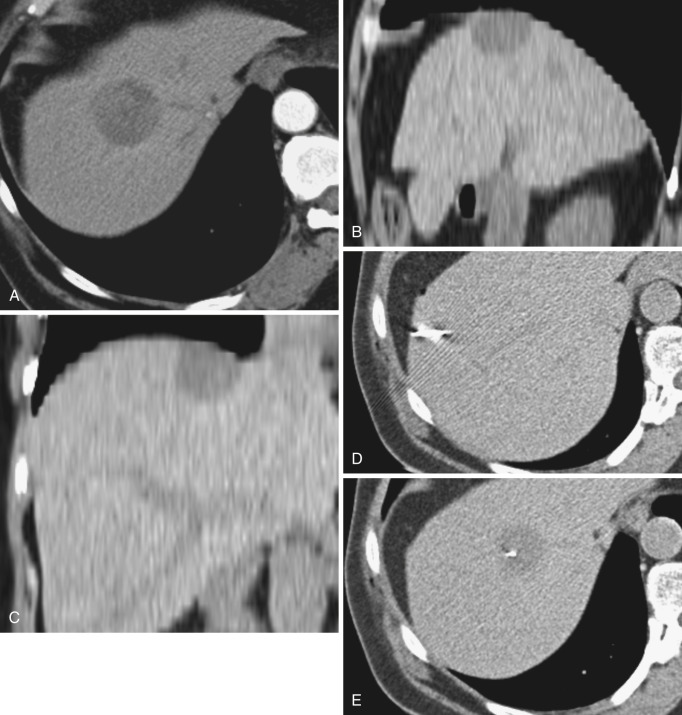
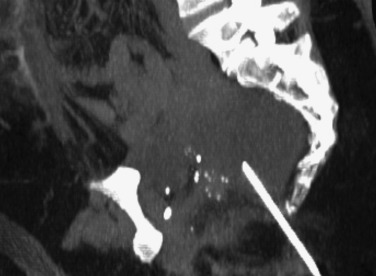
For the new ablation treatments, 3D rendering is especially important because accurate planning and execution of a treatment plan is crucial for consistently successful procedures. Accurate placement is necessary to ensure that all portions of the tumor are treated and there is adequate overlap of the treatment areas. It is of further benefit to confirm that no adjacent uninvolved anatomy is being damaged ( Fig. 67-16 ).
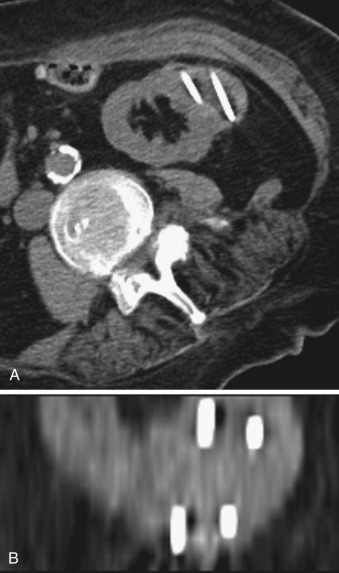
CT guidance has three disadvantages that must be considered when planning image-guided procedures: (1) use of radiation, (2) less sensitivity for imaging primary liver tumors, and (3) less sensitivity for imaging musculoskeletal tumors.
The CT scan uses radiation for generation of the scans, but the dose delivered to the patient is much less than with other specialized studies, such as angiography. With modern MDCT scanning devices, the detector systems are remarkably efficient, using almost 100% of the dose. Although excessive doses should be avoided in all circumstances, a single scan has a sufficiently low level that in cases of acute illness that may jeopardize a patient (e.g., appendicitis) a CT scan and procedure may be justified. In the more recent generation of scanning devices, as a result of increased awareness about radiation safety, vendors are producing “photo-timed” CT scanners. The detector systems are being used in conjunction with the computers to measure the dosage “on the fly” so that optimization of dosage occurs even within the context of a specific scan. I cannot avoid the opportunity to say, “I told you so and it's about time,” noting that this was proposed many years ago in our second edition of the textbook, after our first article on CT dose reduction in 1981 and subsequent recommendations to use the lowest possible dosage for image-guided procedures.
There is a definite lower detectability rate of tumors in the liver and muscle tissues. Because primary tumors of the liver are sometimes difficult to see, one should perform procedures in conjunction with real-time US or reference an available MRI scan (see Fig. 67-8 ).
One significant advantage of US is that the sound waves used are not dangerous to living tissues in the amount and wavelength used. Repetitive examinations are not an issue. The overuse of CT scanners for diagnosis has raised radiation dose issues for radiologists, who must be cognizant of the radiation issue related to repetitive scans, 3D reconstructions, and the tendency to overuse MDCT scanners.
US has gone through several periods of great enthusiasm as technology has improved. In the early years of interventions, the metal instruments were difficult to visualize because the needle completely reflected the US beam, preventing sufficient return of echoes to permit visualization. The sensitivity of new US equipment is so great that it is easy to visualize the tip and pathway of needles in the range of 20 to 18 gauge ( Figs. 67-17 and 67-18 ). The very slight motion of the needle during insertion is well visualized, permitting the “trail” of the needle to be seen clearly. Alterations in the “surface” characteristics of the needle sides and the tip show the end of the needle well. Any tiny gas bubble that is adherent to the end is displayed well.
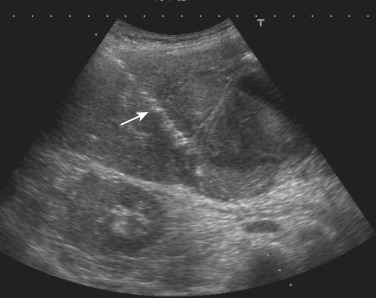
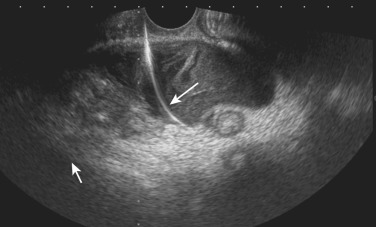
There still remains significant difficulty in special circumstances when bone or gas is present either before or during a procedure. Although US may be used for single or small instrument placement for radiofrequency ablation (RFA) or cryoablation, it is limited when numerous probes must be inserted and localized. Assessing treatment in such cases is difficult because the iceball or gas generated may not be completely assessed or imaged.
MRI advantages relate to its great sensitivity for displaying subtle changes in tissue characteristics, permitting instrumentation. This sensitivity enables visualization of subtle abnormalities not seen as clearly on CT or US (see Fig. 67-8 ); this is frequent with primary liver mass lesions and some cystic tumors of the pancreas.
MRI can survey such nodules and determine which are most suspicious for change to neoplasm. Differentiation of dysplastic nodules compared with hepatocellular carcinomas usually can be made by quantitating T2 differences (see Chapter 43 ). Also, when ablative procedures are performed, the “real-time” damage or change to tumor tissue can be determined by change in the signal. Another example of superior diagnostic sensitivity is in pancreatic tumors (see Chapter 46 ). MRI is remarkably superior to CT for the detection of subtle islet cell tumors and the details of some cystic tumors of the pancreas.
Because of these qualities, MRI is well suited in selected cases to follow the progress of the treatment procedures. It has been well documented that MRI is the most accurate modality for displaying the tissue changes from RF treatment, as noted by Lewin and coworkers and Merkle and colleagues in numerous reports ( Fig. 67-19 ). Experimentally, MRI has been able to display characteristics correlating with absolute tissue temperature. With the current emphasis on treatment, it also may be possible with higher-field magnets having broadband capabilities to visualize drugs in situ as they circulate within the tissues and the target molecules. It is not illogical to assume that in the future, these qualities will be exploited by interventional strategies, most likely therapeutic approaches, if issues related to accurate and convenient instrument placement can be resolved.
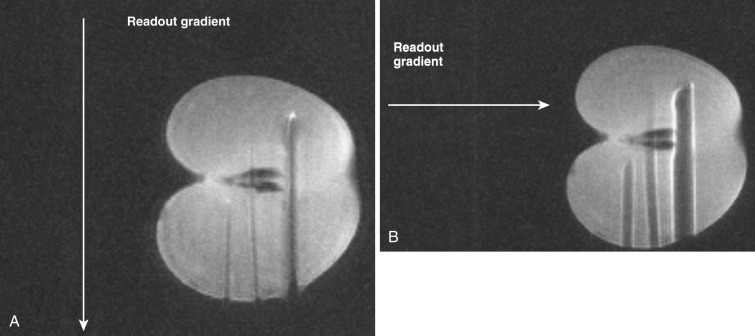
Another advantage of MRI is its ability to image blood vessels and to assess vascularity as it relates to general blood flow. MRI during standard pulsing sequences shows vessels even without contrast material. Moderate-sized vessels are clearly seen as a flow void. Although the anatomic spatial resolution of MRI is less than that of CT, it can also display specific blood flow characteristics, as one might see in hemangiomas, using gadolinium-enhanced dynamic contrast enhancement (DCE). An indirect advantage is that gadolinium has a much lower idiosyncratic rate than iodinated contrast material, so that patients who are allergic to traditional contrast material used with CT can be imaged and evaluated by MRI flow studies.
Because of the proven efficacy of MRI-guided procedures, we have included a complete chapter on the topic in this sixth edition. Chapter 66 —“MRI-Guided Interventions” by Dr. Sherif Nour—provides an excellent comprehensive review, and the subject will not be discussed further in this chapter.
Because of the ability of PET to image actively growing tumor, it is extremely valuable for targeting viable tumor for biopsy. Generally, any tumor that is “avid” for glucose appears hot and can be localized on associated CT images. The avidity of glucose is due to the hypermetabolism and increased level of glucose transport molecules. PET is of great benefit for visualizing virtually all viable tumor masses, and with the ubiquitous nature of PET, it is likely that most patients coming for biopsy will have such a study.
The exceptional value of PET is threefold: (1) to provide overall assessment of disease extent to identify suitable targets for biopsy ( Fig. 67-20A ), (2) to differentiate viable versus nonviable tumor and central necrosis, which does not contain diagnostic tissue and should be avoided (see Fig. 67-20B ), and (3) to perform postablation assessment of tumors. PET has proven to be the modality of choice for follow-up of lung ablation lesions and to be of great importance for liver ablations (see later under “General Techniques for Tumor Ablation”).
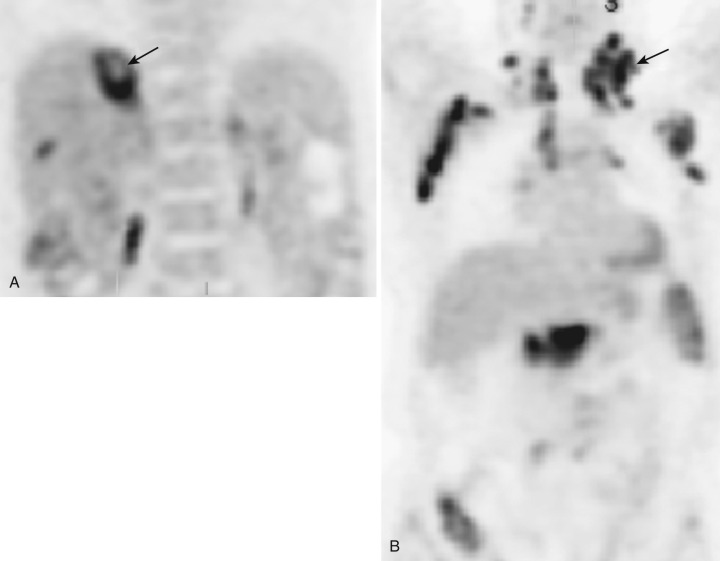
Several organ sites and categories may be problematic, related to the nature of the primary tumor, tumor metabolism, and inflammatory sites. Primary tumors of the liver and kidney are variable and may not consistently be avid for fluorodeoxyglucose (FDG).
A problem with PET is that it is occasionally difficult to differentiate inflammatory sites from tumor unless special techniques are used. The literature indicates that inflammatory tissue is avid for glucose in a similar fashion as cancer because of the enhanced blood flow due to dilated inflamed vessels and elevation of the glucose transporter molecules. There are two methods to differentiate inflammatory sites from neoplastic sites; the delayed scanning technique is described in Chapter 53 , and the second is a new method that we have devised but not yet published. The first method reported consistently in the literature is to take delayed image acquisitions 2 to 3 hours after the injection of FDG. Tumors typically retain their increased high uptake, whereas inflammatory sites reduce their uptake.
The second method is a new method to temporarily reduce the inflammatory vascularity by administering an over-the-counter (OTC) U.S. Food and Drug Administration (FDA)-approved oral decongestant before injecting FDG. Although this is not an FDA usage of an approved drug, this technique is legal using the guidelines under the Belmont report, which appears on the FDA official website. We devised this new technique to reduce the incidence of false-positive PET scans sent for biopsy. In a group of nine patients with positive PET studies who presented for biopsy, we altered the appearance of the CT scan as follows. Recognizing that inflammatory sites respond to oral decongestants, we administered a single oral dose of an OTC FDA-approved decongestant 30 minutes before injection of the FDG. The medication we used was either pseudoephedrine or phenylephrine in the recommended OTC dose. Uptake of the FDG was sufficiently reduced to dispel the concern about malignancy, and the procedures were deferred ( Figs. 67-21 and 67-22 ).
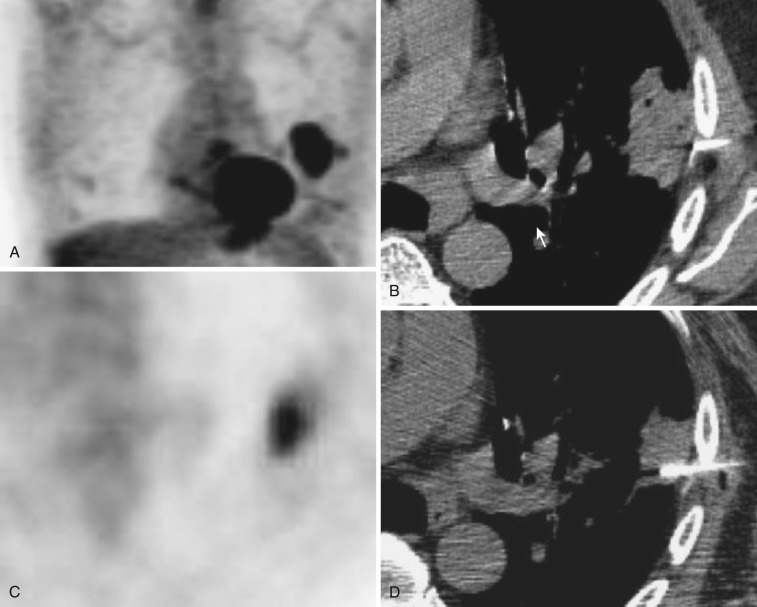
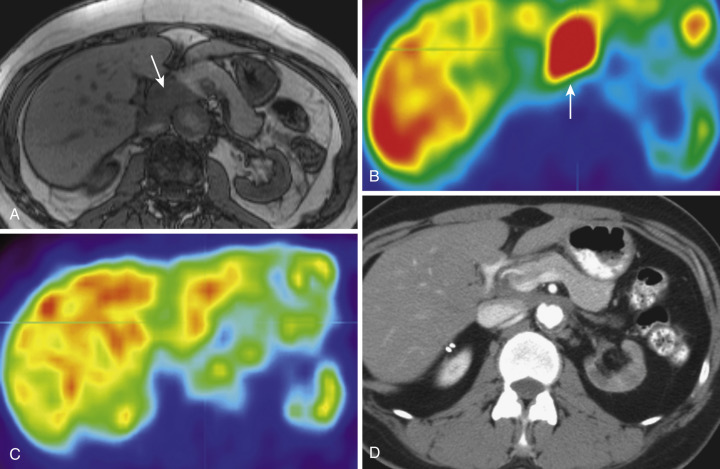
We found that this technique worked in four of nine cases, eliminating the false positives from inflammation without changing the positivity of the cancers scanned. Further studies are required, but this seems to be a worthwhile technique for the future. Although this technique is not approved by the FDA as yet, the patents have been filed for the method, and we are hopeful that a company will partner with us to bring this new technique to the marketplace and general usage.
In recent years, devices that combine PET and CT within the same piece of hardware have been built. As one might expect, these devices offer great potential for enhancement of interventional procedures. The functional aspects of PET permit better visualization of viable tumor within mass lesions to permit more accurate and reproducible biopsies and treatments.
Health care will become more personalized with the standardization of biomarkers, made possible from the development of new ligands related to reporter genes, proteomics, enzymatic metabolic pathways, and cellular processes. Specific traces will permit assessment and treatment of disease processes, eliminating the need for some diagnostic biopsies, but it is likely that sometime during the course of such evaluations and treatments, biopsy to recurrent target tissues will still be needed. It also is very likely that image-guided procedures will be used for delivery of treatment agents (i.e., chemicals, antibodies, or modulators).
The indications for CT-guided procedures vary from institution to institution, depending on the expertise of the radiologists and the available imaging modalities. Generally the important factors to consider are the visibility of the lesion on CT compared with other modalities, the type of pathologic sample required, and location of the lesion.
Considering that the prime function of the guidance modality is to direct the needle to the lesion, visibility of the lesion is the most obvious factor. If one cannot see the lesion, one cannot biopsy the lesion. If a lesion is seen only on CT or much better on CT, CT is the modality of choice. Conversely, if a lesion is seen only on US or MRI, those modalities would be the preferred guidance methods.
When an aspiration biopsy is clinically indicated, various factors should be considered. The simplest modality that satisfactorily shows the abnormality, the pathway of the instrument, and adjacent anatomic information should be used. In most instances, anatomic areas such as the porta hepatis, pancreas, retroperitoneum, and pelvis are best suited for CT guidance. Specific considerations of each anatomic area are discussed later.
When lesions are small (3-5 cm) and located in critical areas, CT is the preferred modality ( Figs. 67-23 to 67-25 ). CT puncture is best performed to assess abnormalities in critical areas such as adjacent to major vessels, the hilum of the spleen, and the mediastinum. Visualization of such small lesions may be attempted first using other modalities, but most authors agree that successful punctures on the first attempt are more likely with CT guidance. Any procedure that fails with other modalities should be attempted using CT.
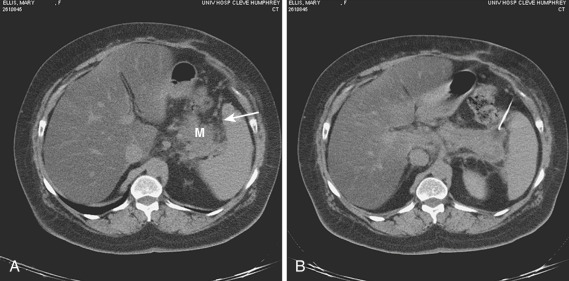
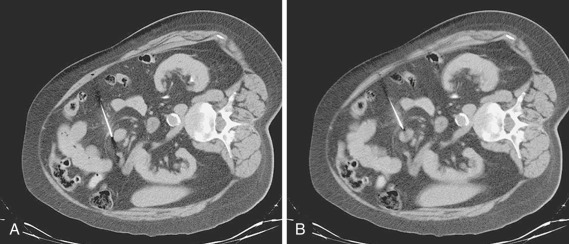
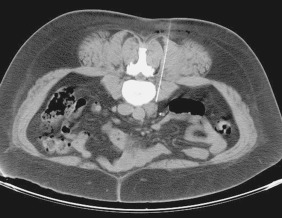
CT should be used when avoidance of intestinal loops or vascular structures is important (see Figs. 67-24 and 67-25 ). We believe such avoidance is advisable in most patients but especially in several situations. In immunologically compromised patients, CT procedures should be used to avoid penetration of the bowel and possible contamination (even with the skinny needle). Even in immunocompetent patients, if the abnormality to be punctured is a fluid density, penetration of the bowel should be avoided if possible, to prevent pyogenic contamination. Although the incidence of clinical infection after microcontamination occurs is rare, it does occur (see Fig. 67-13 ). Three approaches can be used to move bowel: variation of patient position; manual compression of the abdomen; and injection of carbon dioxide, air, or fluid such as saline (see later under “ Intentional Organ Movement or Tissue Retraction ”).
When a large cutting needle biopsy is clinically indicated, CT and US are the modalities of choice because of the clarity of needle visualization and the accuracy of real-time monitoring with US. State-of-the-art CT permits optimal visualization of the needle, assessment of vascularity with dynamic bolus scanning, and real-time CT fluoroscopy when needed. Virtually all authors accept dynamic bolus scanning as being highly accurate for assessment of vascularity, whether in the liver or other areas. These bolus scans can detect excessively vascular lesions, which may have a propensity to bleed if biopsied. Occasionally, remarkable unexpected vascular anomalies are detected, which can avoid catastrophic accidents ( Fig. 67-26 ). CT also may be the modality of choice when some type of contrast agent, such as urographic contrast material or air, is to be injected. Such contrast can provide additional information about cysts, abscesses, pseudocysts, or dissemination of medication.
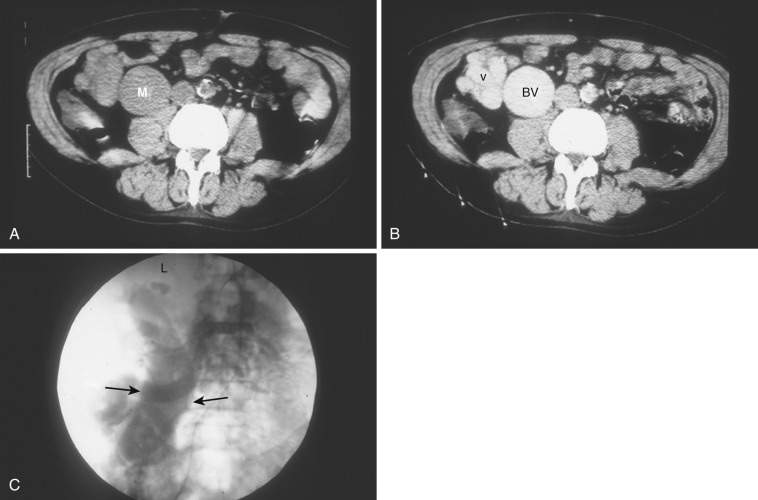
The main indications for US are the clear visualization of the abnormality on US and the need for real-time guidance of the procedure. Although US is not as accurate for visualization of the needle, it is effective for real-time monitoring of needle placement. This is a judgment call by the radiologist, who must consider the proximity of crucial structures, the need for precise visualization of the needle, and vascular enhancement issues. Knowing that the skill level at different institutions varies, when there is a high level of experience, US may be used almost interchangeably with CT when the aforementioned factors are not critical.
Greater personal experience translates into better results regardless of the imaging modality or technique used. The outcome and complication rate are better for an experienced operator than for an inexperienced operator, regardless of whether biopsies or ablations are performed. This is true for different ablation methods, needles, and organ systems. Also, if one looks at the reports in the literature, one usually finds an improvement in the authors' results as their reported experience accumulates. The improvement of diagnostic accuracy with experience was documented by Evander, Zornoza, and Hopper and their colleagues. Similarly, with ablations, Poon and coworkers documented that after experience has been gained, the ablation success rate increases and complication rate decreases.
Because of the importance of experience, it is prudent for departments to designate a limited number of individuals who perform procedures so that greater expertise can be developed. This practice benefits all parties involved, including patients, physicians, and administrators.
Some complications are specific to the various organ systems, but some general concepts are relevant to all areas. The use of CT-guided procedures has significantly reduced the possibility of complications. Assuming that the correct CT technique has been selected, the major causes of complications are limited to poor technique, lack of patient cooperation, undetected coagulopathy, or undiagnosed obstructive or diffuse interstitial processes in the lung.
Before discussing in detail how one can avoid certain problems, several comments are warranted concerning complications as they relate to the two major categories of instruments: the aspirating, or skinny, needles and the large cutting needles. Contrary to the opinions of some, severe complications may occur with any needle (including skinny needles, manual cutting needles, and automated biopsy guns) unless one employs caution, common sense, and meticulous technique.
There is no question that the skinny needle is the safest instrument available, but even this needle can produce complications when proper patient selection and techniques are not used. In a careful review of reports of skinny needle biopsies of the pancreas, one can find instances of pancreatitis, pancreatic fistula, cholangitis, needle-tract seeding, significant hemorrhage, abscess formation, and fatal pancreatitis. Such complications were usually the result of incorrect patient selection or choice of anatomic pathway and an excessive number of needle passes. Each organ system has specific issues, as noted and explored subsequently under each of the organ system sections below, but general factors can be mentioned.
Improper patient selection and evaluation of anatomy and vascular properties have produced numerous hemorrhagic complications and deaths. Reported fatalities from liver and adrenal hemorrhage occurred with vascular hemangiomas, hemangiosarcoma, severe coagulopathy, and pheochromocytoma. One can see in reviewing the literature that most complications have occurred in cases with four or five needle passes.
The impact of numerous needle passes with skinny needles on complications was reported by Smith of the University of Massachusetts. Smith reported a survey sent to 100 university hospitals and every fifth hospital in the United States, which solicited information about complications and risks from FNA biopsies. In this report, he noted the occurrence of 4 deaths, 27 cases of hemorrhage, 3 occurrences of needle-tract seeding, and 16 cases of generalized infections (nonfatal). Smith stated, “It is logical to assume that the number of complications should be related to the number of needle passes made during the biopsy procedure. However, serious and even fatal complications, although rare, can and do occur and it is important to be aware of the possibility and take all the appropriate precautions in order to reduce their incidence.”
Even with extensive experience and caution, hemorrhage may occur with FNA aspirations ( Fig. 67-27 ). In most instances, such events are rare if proper methods are used.
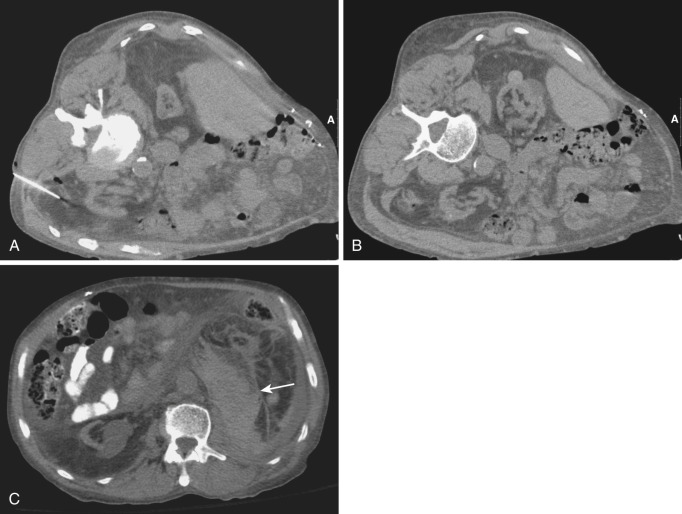
One has a greater probability of incurring possible complications with large needles because a large “hole” is being produced. With proper patient selection, proper target and trajectory choice, and meticulous technique, however, the potential risks of these needles can be offset, and very low complication rates can be achieved. Considering the previous controversies in the field about using large needles, we have some concern that such needles are used too frequently by some groups. One can use very large needles safely with good results, but one must pay careful attention to meticulous technique, or serious and fatal complications can result.
The new automated cutting devices are no safer than the standard “manual” Tru-Cut needle that has been used for many years. Some authors have asserted that the rapid speed of the cutting action may lessen local damage, but this concept is nonsensical. In the first report on the biopsy gun, the authors described a serious hemorrhagic complication after a liver biopsy. Potential problems are minimized by CT guidance and a careful, meticulous technique such as I have described. These measures can eliminate many potential causes of complications (e.g., hemorrhage or inadvertent penetration of an uninvolved organ) and can result in excellent accuracy with few problems.
If one uses a large-core biopsy needle with an automated mechanism, it is best to avoid the single-action devices and use instead double-action devices. Double-action devices permit confirmation of the cutting gap in the anatomy before tissue cutting occurs. Critical biopsies can be performed safely because the device cuts only where the “gap” is seen on the scan. If a patient wiggles or moves slightly, the location of the needle and the cutting action are not altered. Single-action devices “cut” the tissue with a single action by the operator; if a patient moves, the anatomy may move a vital structure into the cutting site, and catastrophe may result (see “ Lung and Mediastinum ” for an example of a patient in another institution who died because the patient moved slightly in such a case).
A major cause of complications is penetration of uninvolved structures. With the spectacular imaging characteristic of CT and US, intentional penetration of adjacent structures is inexcusable if other clear pathways are readily available. We differ from other authors who proselytize routinely using a trajectory through an adjacent uninvolved structure such as the pancreas or liver during an adrenal biopsy, the bowel during pancreas biopsy, the aorta or vena cava during pancreas biopsy, the spleen during pancreas biopsy, and the pleura during abdominal biopsy. Such approaches are likely to result in higher complication rates if used routinely.
Complications are statistically more likely to occur if a less optimal approach or technique is used frequently. The fewer times one penetrates an avoidable uninvolved structure, the lower the probability of a related complication. If one chooses to penetrate the aorta or venous structure during a celiac nerve block, there is a finite rate of complications even if it has yet to be defined. The fewer times one uses the suboptimal approach, the less likely it is that one would have such a bad outcome. At least if one attempts to avoid and not target such structures with a suboptimal trajectory, it would take many more occasions for complications to occur.
Complications may occur even if no error was made ( Fig. 67-28 ). This was the subject of the article published by Yohann and our group called “Complications of No Biopsy.” In this report, we noted the spontaneous occurrence of three events that would have been interpreted as complications even though there was no association with the procedure. The most remarkable case was a life-threatening spontaneous bleed, which occurred even though the scheduled procedure was canceled and never performed.
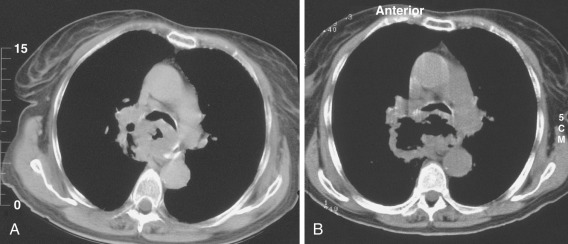
We emphasize this principle for two reasons. First, any physician who has had a complication despite his or her best efforts and good techniques can be consoled. Second, if the reader is ever involved in contentious case or lawsuit, he or she can use this as a reference to support the unintended complication.
Although the complication rate is typically low and acceptable with proper needle selection and technique, numerous individuals did early work to minimize or prevent any issues related to hemostasis. Among investigators who have contributed in this area are Chuang and associates (injection of absorbable gelatin sponge [Gelfoam] with coaxial system), Allison and Adam (angiographic coil through coaxial system), Gazelle and Haaga (occlusive protein sheath), and Haaga and Nakamoto (local injection of blood products).
The most likely potential risk during any biopsy procedure is the occurrence of bleeding. The vascularity of the pathologic lesion and the anatomy, occurrence rate, and risk of bleeding are specific for each organ system; these factors are discussed in relation to each organ system. Highly vascular lesions of the liver (e.g., hepatomas, sarcomas, hemangiomas) potentially have a high incidence of serious hemorrhage unless meticulous methods are used. Some lesions should be avoided if they are too vascular on dynamic bolus scan unless one is prepared to perform a hemostatic method (see Fig. 67-32 ).
Assessment for a coagulopathy is essential to avoid hemorrhagic complications. In contrast to some radiologists who do not require preprocedure laboratory studies, we believe that measurement of laboratory values is important to ensure that no significant deviation from the norm is present, and we make appropriate arrangements if coagulation studies are abnormal. Although the literature is unclear about what level of laboratory values is required, there is little question that bleeding is directly related to abnormal states. Several animal studies by our group evaluated the effect of needle caliber, type, prothrombin time, and platelet counts. In these studies, platelet function seemed to be an even more important factor than prothrombin time. With either abnormal platelets or prothrombin time, studies showed that there was a considerable difference between needles smaller than 16 gauge and needles larger than 16 gauge. We prefer that the international normalized ratio (INR) be less than 1.3, with the partial prothrombin time within 25% of normal, and the platelet count be greater than 50,000/µL. In some critical clinical circumstances, exceptions can be made, but with such variances the potential risk is greater, and one is obliged to consider using one of the hemostatic methods described subsequently.
Contamination of sterile areas is possible from either a cutaneous source or, if a loop of bowel is penetrated, an enteric source. Cutaneous contamination is improbable if povidone-iodine (Betadine) is used for preparation of the skin. Contamination from bowel or normal flora of the liver or kidney can occur, depending on the immune status of the patient, nature of the abnormality, size of the pyogenic inoculum, and virulence of the pathogens. Numerous secondary infections have occurred and been reported in the literature. One reported case of peritonitis occurred in an elderly woman after penetration of the colon by a skinny needle during a lymph node biopsy. In his survey, Smith accumulated 16 cases of generalized bacteremia occurring from aspiration biopsy that were treated by antibiotics. Although traversing a loop of bowel during the course of a procedure uncommonly produces a clinical infection, statistically the possibility exists; we prefer to avoid such events if possible.
Although an immunocompetent patient can tolerate spillage of a small amount of bacteria within the peritoneum, the clearance of bacteria is impaired in certain circumstances. If bacteria are introduced into a fluid space, experimental data show that the effectiveness of bacterial “killing” is impaired because (1) opsonization of pyogens by antibodies and complement is less efficient in a fluid space, and (2) phagocyte-clearing activity is impaired in a fluid space based on physical spatial considerations and the probabilities of random particle encounters.
An immunologically compromised patient is at greater risk from pyogenic organisms because of the reduced number or function of immunologic cells. Special precautions should be taken as noted subsequently.
If a patient has a normal immune system, we attempt to avoid a trajectory crossing bowel, but if no other pathway is feasible, we accept a trajectory crossing the stomach or small bowel (not the colon). In normal patients, any small inoculum of bacteria is easily eradicated by the normal immune system (practically speaking, it is difficult to penetrate bowel unless one tries, because it moves away from the needle). Even in normal patients, if the lesion being sampled is cystic, we insist on avoidance of bowel for the reasons stated earlier (see Fig. 67-13 ) because the phagocytes cannot clear bacteria as easily. Passage through bowel also would be counterproductive for the culture of cystic masses because of possible spurious results from contamination.
If the patient is known to be immunocompromised, we avoid traversing the colon or small bowel in all cases. The potential risk to the patient exceeds the benefit, and it is advisable to cancel the procedure rather than put the patient at risk.
Avoidance of the bowel in either scenario usually can be achieved by changing the patient position on the table, which typically changes the location of the bowel. Although one cannot be completely sure how the bowel will shift, the air in the bowel will rise and the “floating” action will move it. If a chosen position does not open up the potential pathway, changing the patient position in an opposite fashion (usually one lateral or the other) may open clear pathways for needle insertion. In other cases, injection of saline, air, or carbon dioxide may be used to move bowel loops (see later under “ Intentional Organ Movement or Tissue Retraction ”).
The vasovagal reaction is a sudden discharge of the parasympathetic vagal nerve, resulting in bradycardia, vasodilation, and hypotension. Vasovagal responses must be dealt with properly and expeditiously to prevent severe sequelae or inappropriate iatrogenic intervention. Patients appear pale and ashen gray and may be partially responsive or unresponsive. The appearance is similar to that of a patient who has had a cardiopulmonary arrest. Close inspection of the patient shows the presence of bradycardia, diaphoresis, dilated pupils, and hypotension.
Treatment of this event should be tailored to the severity of the situation. The patient first should be put in Trendelenburg position (raising the patient's legs while he/she lies flat) to enhance venous return to the heart and cerebral blood flow. The patient should not be seated upright—this worsens the hypotension. If the patient improves with Trendelenburg positioning within 1 to 2 minutes, no other action needs to be taken.
If the patient does not improve quickly, oxygen should be administered by nasal cannula to preserve oxygenation, and an appropriate dose of atropine, either intramuscularly or intravenously, should be administered. Before administration of the drug, a quick review of the patient's clinical notes is appropriate; patients with cardiac arrhythmias may be sensitive to the drug. A single intravenous (IV) or intramuscular (IM) dose of 0.5 or 1 mg usually restores the normal heart rate. If the patient's condition persists (i.e., if atropine does not improve the situation), urgent consultation with a resuscitation team is appropriate. Such patients, especially elderly patients, can develop a complete heart block, vascular collapse, and cardiac arrest if not properly treated.
The other event, which is more spectacular but less dangerous, is a hysterical reaction. These patients appear agitated—hyperventilating, tremulous, and possibly crying. Close inspection of the patient may reveal tachycardia and systolic hypertension. The pupils are of normal size or smaller. Patients may be breathing fast and complain of subjective shortness of breath.
If hyperventilation seems to be occurring, the patient complains of tingling of the lips and being lightheaded. After auscultation of the chest confirms good air exchange, the best treatment is to have patients breathe into their hands or into a bag, if available, to prevent compensatory changes in the cerebral blood flow and subsequent fainting.
The next step is to give the patient gentle but firm reassurance; if there is no response, the patient should be removed from the biopsy suite. Before any repeat attempt, the patient should receive an appropriate sedative. Careful assessment of all biopsy patients during the informed consent period usually indicates those who need sedation, preventing any such hysterical reactions.
We have seen two cases of tumor recurrence in the needle pathway, one referred from another hospital ( Fig. 67-29 ) and one from a liver biopsy. Although the exact reason why tumor implants occur is unknown, there are two main factors affecting the outcome: type of tumor and the implant site milieu.
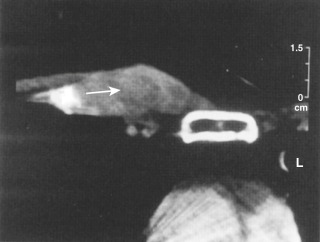
Mechanisms and pathophysiology of tumor seeding have been studied. Many reports have been performed in animal models assessing the seeding of tumor cells in tissues during and after needle biopsy. Ryd and colleagues showed that 10,000 to 100,000 cells may be deposited in the tissues. Most such cells do not survive or produce local tumor growth. Why a selected number of sites develop tumor is unknown, but according to Mahalingam and coworkers, platelet aggregation and fibrin are important for tumor growth to occur.
The best human information on this topic is related to breast cancer. Diaz and colleagues and Stolier and associates have reported on the frequency of tumor cell displacement occurring in tissues after large-needle biopsies and have provided significant insights into tumor seeding. Diaz and colleagues studied a series of 352 cases and looked at the occurrence of tumor cell displacement in specimens that were resected. These authors found that a greater number of tumor cells were present in a short period after the biopsies than at a later time. This finding suggests that tumor cells do not survive displacement in usual circumstances in the breast. In the group that underwent resection in less than 15 days, 42% had displaced tumor cells present. In the group that underwent resection more than 28 days, only 15% had displaced tumor cells. The reason a few residual cells may survive to cause low seeding or recurrence likely depends on the type of tumor, general differentiation, immune system of the individual, antigenicity of the tumor, and local milieu (e.g., vascular characteristics).
We once speculated that with the expansion of image-guided biopsies, it was likely that more cases of tumor implantation in the needle track would be observed and reported, and this has occurred. Tumor implants at needle sites have been increasingly reported. We discuss some of the more common sites of needle-associated tumor implants with pertinent comments. When studied, the residual tumor implants from surgical procedures are many times greater than needle procedures.
The incidence of implants in the lung is well defined, but most investigators express the opinion that their use is crucial for optimal, expeditious clinical care. Considering the thousands of such procedures performed, the incidence, as noted by Wolinsky and Lischner, is very low. More recent data from a surgically resected group, however, indicate that although needle track recurrence is low, patients who have had a needle biopsy before surgical resection have a higher incidence of recurrence in the pleura than do patients without needle biopsy. Matsuguma and coworkers reported that pleural recurrence or needle track implantation was observed for 8.6% of the patients who underwent a needle biopsy, whereas the rate was 0.9% for patients who were examined using other diagnostic modalities ( P = .0009). There are no specific details about the technique used, so there is no way to determine if that represented a factor related to the increased occurrence. Pleural mesotheliomas are recognized as having a very high incidence of tumor seeding in the needle track (see “ Lungs and Mediastinum ” and Chapter 39 ). According to Agarwal and associates, although the incidence of seeding at the needle site is 4% for image-guided procedures, the incidence after surgical biopsy is 22%.
Concerning the liver, there have been numerous reports in the literature of tumor recurrence after needle biopsy and ablation. In recent years, numerous incidental cases of tumor seeding have occurred in patients with hepatocellular carcinoma. Studies led by Soyer, Llovet, Sato, and Kim have reported tumor seeding in relation to needle biopsy, tumor ablation, biliary drainage, and laparoscopic procedures. The increase in reports is undoubtedly due to the increased frequency of image-guided microsurgery and minimally invasive surgery and the nature of hepatocellular carcinoma.
Needle tracking of renal tumors is infrequent with aspiration biopsies, but it may occur rarely with cutting-type needles. Dr. David Wood at the annual meeting of the American Urologic Society in Orlando, Florida, in June 2008 reported the incidence of tumor seeding at less than 0.01%. Von Schreeb and associates reported a controlled series of about 150 cases of proven renal cell carcinoma used to study the impact of needle aspiration. Half of these cases were aspirated and half were not. There were no instances of needle track seeding.
The pancreas has had a frequent rate of tumor seeding compared with other organ systems. Johnson and coworkers studied the effect of skinny needle aspiration in 41 patients who went to surgery for curative intent. There were no instances of tumor seeding. Peritoneal washings were positive in 18% of patients who had needle biopsy, and 20% of a small group without needle biopsy had positive peritoneal washings. Tumor seeding in most patients with pancreatic cancer does not seem to be a significant issue because few patients are surgical candidates, so a minimally invasive method of diagnosing the disease is crucial.
For patient care, the literature is replete with reports about the benefit of percutaneous procedures for early diagnosis, confirmation of recurrence, and image-guided treatments. There are no proponents for reducing the use of these procedures, but rather recommendations that techniques be refined to minimize the occurrence of such events.
It seems that the issues related to tumor seeding in the needle track can be easily avoided by using a coaxial system. The two recommendations we previously made (i.e., using a pathway through normal liver and using a coaxial system) have been validated. Several authors have reported that tumor tracking can be avoided if such techniques are used. The factors that seem to prevent tumor seeding are an approach through an adjacent loop of normal tissue and a coaxial system.
Before the procedure and administration of any medication, it is important to review the pertinent medical and drug history and to discuss the procedure in depth with the patient. From the history, it is important to ensure that the proper procedure has been chosen and that necessary preparatory laboratory studies and arrangements have been made. With the fast pace of medical care today, it is common for the referring physician to have delegated the order and coordination of the procedure to a nurse, receptionist, or physician assistant. Frequently the patient's history provided by the paperwork is incomplete or incorrect. Depending on the purpose of the procedure, one has to ensure that the proper pathologic analysis is being ordered (i.e., flow cytometry, electron microscopy, biomarkers). If the patient is chronically ill or fragile, special arrangements such as anesthesia or hospital admission might be appropriate.
During this time, one should inquire about any medication that may alter coagulation or platelet function. The latter is especially important because platelet inhibitors are widely used and not described to patients as “blood thinners.” Routine coagulation studies do not detect the presence or activity of platelet inhibitors. Laboratory work performed by our group has confirmed the serious alteration and risk of the coagulation status in patients taking aspirin-like compounds.
Two of the most troublesome situations are patients who are being treated with low-molecular-weight heparin and patients with systemic lupus erythematosus. Use of low-molecular-weight heparin is widespread because it has a much lower incidence of overanticoagulation than traditional heparin. The problem with this agent from the perspective of interventional procedures is that the methods for assessing the degree of anticoagulation are not readily available at many hospitals. Few clinicians are aware of the required test, which is an assessment of factor X inhibitor. Within our community, several catastrophic events have occurred in association with this new agent.
With systemic lupus erythematosus, there is a high incidence of patients who have spuriously elevated coagulation tests owing to unknown circulating antibodies. The dilemma that arises is that when such tests are positive, one cannot be sure if the patient would clot normally. Frequently we are asked to perform biopsy in such patients, and clinical physicians typically assert that there are few risks.
Both of these situations are fraught with difficulty because the attending radiologist, not the referring clinician, bears the brunt of the legal consequences if bleeding occurs. The best approach in these situations or others that might arise is to rely on a more clinical coagulation study—the bleeding test—when available. This test evaluates the time required for a standard puncture site to stop bleeding; it takes into account all factors, including the intrinsic, extrinsic, and capillary properties. A substitute for this test for the interventionalist is to observe carefully a small stab wound made at the entrance site for the procedure, as noted later under “Bedside Assessment of Bleeding Diathesis.”
During the interview process and informed consent, all details, including the rationale, medical alternatives, method of the procedure, sensations to be felt by the patient, and postprocedure routine, should be mentioned. After this discussion, the patient may sign the informed consent form and help confer about the need for any sedation.
One cause of complications common to all procedures is lack of patient cooperation. If a patient moves or cannot suspend respiration at the appropriate time, difficulties may arise. The most critical factor to enhance patient cooperation is adequate local anesthesia in the area of the biopsy, the goal being “pain-free anesthesia” as noted subsequently. If local anesthesia is not administered correctly throughout the pathway, including the serosal surface of the organ (e.g., pleura, capsule), the patient may jerk at the time of instrument insertion and produce a tear, bleed, or pneumothorax.
The other factor that has been alluded to and is critical is patient comfort on the table. The patient should be positioned in whatever position is the most comfortable within the context of the anatomic trajectory. This position must be specific to the patient and may include pillows under the knees or shoulders. If patients must lie immobile, they may fidget if they are uncomfortable.
For patients who are emotionally upset, administration of an appropriate hypnotic or sedative can be helpful. Because of the powerful but effective sedative and analgesic agents now available, one must be conversant with basic life-support resuscitation and the sedation protocols of the home institution. Most institutions now require some type of basic proficiency for sedation administration, so the operators must ensure that they comply with institutional, state, and federal guidelines and certification.
Two types of medication may be given to patients: one for sedation and anxiety and another for analgesia. For anxiety, a mild sedative such as midazolam (Versed) should be given. In most average-sized adult patients, 1 mg intravenously can be given at the onset and then titrated to the needs of the patient during the procedure. It is probably better to err on the side of giving medication, but if there is no apparent need by the history or from clinical observations of the patient, one should withhold the drugs.
For routine aspiration and cutting needle procedures, we request a complete blood cell count (CBC), partial thromboplastin time, INR, and platelet count. In view of the greater context of the litigious society and multiple layers of administrative oversight, such studies are of minimal cost and effort to prevent even a rare catastrophic event.
The CBC is important to ensure that the patient has sufficient hematocrit reserve to cope with a hemorrhage. The hematocrit should be at least adequate; the exact value is relative, but I prefer a level greater than 33% for routine cases. If there is any question about the patient's reserve capacity, a type and crossmatch of blood products should be made available if needed. We prefer the platelet count to be greater than 50,000/µL and the INR less than 1.3. Although it is difficult to find a definitive recommendation for the INR value in the literature, we derived this value from an NIH study formulated by the Transfusion Medicine/Hemostasis Clinical Trials Network, a subsidiary of the New England Research Institutes. In this proposal formulated for the Study of Hemostasis and Invasive Procedures, a consensus opinion by the participants recommended an INR level of 1.3 or greater for replacement therapy. In cases in which patients have an altered coagulation status, the laboratory values, clinical factors, remedial corrective steps, attendant risks, and associated precautions should be understood by all involved (patient and physicians), and appropriate contingencies should be prepared for.
When laboratory values are unavailable for an emergency procedure or other reason, we have developed great confidence in the use of a simple bedside method for evaluating bleeding diathesis. The “bleeding time” is a very old laboratory method of evaluating the entire coagulation cascade by making a small stab wound in the arm. The test is performed by observing how long it takes for a bleeding wound to stop bleeding. This test is superior because it assesses in vivo the function of all components in the coagulation pathway, including platelets, blood proteins, capillary fragility, and circulating inhibitors or antibodies. While we do not order this test, we use a different permutation at the bedside that we believe is helpful for avoiding possible catastrophe.
After the skin is prepared, we always make a small stab wound at the entrance site of the needle. Observation of this wound provides a “bleeding test.” Although we do not time the event, we pay careful attention to the clotting of blood from this site. If bleeding continues to “stream” from the site despite several minutes and “blotting” with gauze, we become concerned about an inaccurate history of anticoagulative medication (i.e., aspirin) or an unknown bleeding diathesis.
During the course of our practice, we have identified patients who have had incorrect laboratory values, inappropriate administration of anticoagulants, or other issues. In questionable cases we would rather postpone a procedure than cause a complication. In such cases, the laboratory tests and history are reviewed before the procedure is rescheduled.
For patients with a normal coagulation state, there is little clinical indication that needle caliber is the prime determinant of hemorrhagic complications, but common sense dictates that smaller needles be used if such needles can provide sufficient tissue or sample for the intended histopathologic evaluation. The impact of anticoagulation was elucidated by two well-designed animal models from our institution. Studies led by Nakamoto (Nakamoto D: personal communication, 2006) and Gazelle reported on the effect of anticoagulation on blood loss in two organs: liver and kidney. Using aspiration and cutting needles, the investigators found that there were absolute differences in local bleeding with various calibers of needles ( Table 67-1 ). We also showed that by using an occlusive hemostatic device, the amount of bleeding was reduced to essentially normal levels.
| Target Organ | Groupings of Needle Gauges | P Value |
|---|---|---|
| Liver | ||
| No warfarin | (14) (16) (18, 20, 22) | <.01 |
| Warfarin | (14) (16) (18, 20, 22) | <.01 |
| Kidney | ||
| No warfarin | (18, 20, 22) | NS |
| Warfarin | (18, 20) (22) | <.05 |
If a coagulopathic patient has laboratory values completely restored to normal by the methods described subsequently, needles of the caliber typically used are suitable. If coagulation values remain slightly abnormal, one should use one of the described hemostatic methods.
For an abnormal INR, there are two options depending on the time issues involved. If the patient is taking a warfarin-like drug, it should be stopped. The patient can be given vitamin K, which enhances recovery of the prothrombin level to normal over several days, but the laboratory values must be rechecked until at a normal range. If correction of vitamin K is ineffective, fresh frozen plasma (FFP) may be administered intravenously before the procedure. Repeat INR values should be drawn until a normal level is reached. Some authors recommend administration of several units before performance of the procedure, without repeat measurement of the laboratory values, but we believe a repeat coagulation screen is important to ensure that factors have returned to normal.
For patients whose coagulopathy cannot be corrected by the aforementioned means, or in emergency circumstances that require early performance of the procedure, we have developed a new method to prevent hemorrhage, which involves the local injection of blood products as described later under “ Local Infusion of Blood Elements for Hemostasis .” This is not an FDA-approved technique, but it is legal under current statutes; we have used it for several years with excellent results and no bleeding complications to date in more than 50 cases.
With platelet abnormalities—either absolute count or dysfunction—several corrective approaches are possible. If the platelet impairment is simply due to drug administration, cessation of the drug and waiting an appropriate period is appropriate. If drug cessation does not work, a transfusion of platelets can be given. If the absolute count is depleted or an untreatable dysfunction exists, IV platelets should be given. For an impaired platelet function or low platelet count, three possible approaches can be taken: IV systemic platelet replacement, infusion of desmopressin, or local platelet injection in the pathway.
For impaired platelet function, especially for elevated blood urea nitrogen (BUN), desmopressin may be administered. The dosage and regimen for infusions should be obtained from the local pharmacy. Although the exact mechanism of action is unknown, it has been shown over many years that administration of this medication improves the adhesiveness of platelets and minimizes the probability of hemorrhage. The medication is typically most effective on the first administration and is less effective when later doses are administered.
In many patients, platelet impairment is produced by medications such as aspirin, other analgesics, or antiplatelet agents given for cardiovascular reasons. Administration of platelet inhibitors or aspirin has become established as the mainstay of cardiovascular treatment. The significance of this platelet impairment was well described in a laboratory model by Gazelle and colleagues, who studied the effects of aspirin. Patients with impaired platelet function on the basis of either medication such as aspirin or other inhibitors are best treated by stopping the medication and waiting the appropriate time for the effect to resolve. Although the effects of aspirin are long-lasting, we consider a 7-day period without medication as the optimal time interval before a procedure should be performed. Nonaspirin pain relievers are usually shorter acting; a waiting period of 1 day after cessation is usually adequate, but the pharmacy should be consulted for specifics of any medication.
The traditional approach for correction of coagulopathy is to administer IV platelets or FFP over the course of many hours to obtain a systemic improvement of these factors. If replacement platelets are used, the infusion should be continued until the platelet count reaches greater than 50,000/µL. Restoration of the INR to acceptable levels is accomplished by IV administration of FFP. Numerous units are given until the INR reaches 1.3, as noted earlier. Fresh plasma permits this restoration of the INR because it replenishes numerous factors such as prothrombin and factors VII, IX, and X, which are produced by the liver and are deficient when liver function is impaired.
There are several difficulties with the traditional method. The most difficult issues are related to obtaining the blood products, administering the products, rechecking the tests, and transporting the patient to the imaging site to perform the procedure. Regardless of the institution, anywhere in the world, there are always logistical problems.
If patients have cardiovascular compromise, the multiple units infused may cause cardiac overload and decompensation. In some patients, there may be antibodies or unknown reasons why such products do not correct deficiencies. If patients show a lack of response to such methods or the clinical scenario is so dire that the procedure must be performed emergently, one can opt for the new method of local infusion of platelets, as described next.
We continue to refine and study our technique for treating bleeding, the local infusion of blood products. This is not an FDA-approved use of blood products, but under current legal guidelines, a physician can act on the best behalf of a patient in unusual circumstances. If a product is approved for human usage, a licensed physician can use that product for other uses when the benefit to the patient seems to outweigh the risks. Under these guidelines, a physician can use the technique described later in this section, but he or she takes on any associated ethical or legal risks.
The innovation of this technique evolved from the treatment of a radiologist colleague who had refractory leukemia unresponsive to systemic platelet infusion. Having received many platelet infusions over the course of his treatment, he developed antibodies to platelets and hypersplenism. This condition was so severe that if he was given 10 U of platelets, his body would consume the platelets and his platelet count would never increase above “0-10.” After developing a severe spontaneous hemothorax causing compression of his heart and diaphragm, he was refused treatment by thoracic surgery and was sent to us for percutaneous treatment. We recognized the possibility of rebleeding but consented to perform the procedure for temporary relief.
At the time, we reasoned that one might be able to use platelets with local administration as an alternative method. The rationale was that blood products injected into the pathway with a small-caliber needle before the biopsy or drainage instrument would create a “seroma” of the missing product (e.g., platelets, FFP). The concentration of the blood product would be “astronomical” in the local site. If the instrument encountered a vessel in the path, the local product would form a local clot. Because there was no other alternative for our radiologist colleague, we tried the method and it worked ( Fig. 67-30A ). With drainage of hemothorax, the patient improved symptomatically and lived for 3 months afterward.
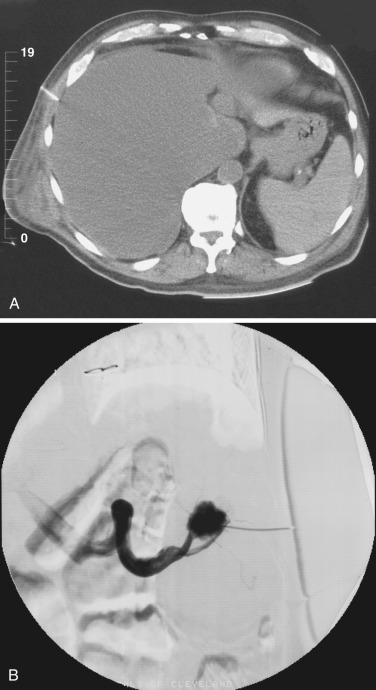
We have since used local injection of platelets and FFP in patients who have an abnormal prothrombin time or low platelet count as a partial solution to the problem. An even more extraordinary case involved a teenager with hypersplenism whose low platelet count was unresponsive to replacement. To exclude the possibility of portal hypertension secondary to portal vein stenosis, a splenoportogram was ordered by the surgeons (see Fig. 67-30B ). Platelets were injected locally into the pathway during insertion (and removal) of an 18-gauge needle, and the study was performed without incident.
The many clinical circumstances under which we feel use of this technique is justified include: (1) the patient is too ill to wait for infusion therapy and in a life-threatening situation; (2) an existing condition of patient (e.g., pulmonary embolus, failed vena cava filter, recent coronary stent placement, cerebral occlusion) requires maintenance of anticoagulation; and (3) failure of the patient to respond or recent history of failure to respond to replacement therapy (i.e., antibodies, hypersplenism).
If these factors are present, we perform the local injection of blood elements as follows. After preparation of the site with povidone-iodine, the site and pathway are prepared in two steps. The syringe containing lidocaine is mixed 50% by volume with either FFP or platelets. The pathway is anesthetized (which includes blood product) in the routine manner, ensuring that the pathway is treated from skin to the organ surface and edge. Next we make a repeat injection of approximately 5 to 10 mL of blood product into the expected trajectory of the needle, including the skin, subcutaneous tissue, and surface of the organ and target (see Fig. 67-30 ). It is crucial that the entire pathway be injected, not simply the subcutaneous tissues or the capsule of the organ; bleeding can potentially occur from any site along the pathway and can push out any localized plug of clot. When a biopsy rather than a drainage is being performed, it is prudent to use a coaxial system that includes a guidance cannula and the biopsy instrument. The appropriate samples can be taken and the needle removed, leaving the cannula.
After the biopsy, the blood product is injected in the pathway through the coaxial cannula as it is removed ( Fig. 67-31 ). If bleeding occurs, one can inject more blood product into the site to provide hemostasis (see Fig. 67-31 ) (this has not happened to date in our experience), or one can use the coaxial/coil/thrombin method if bleeding continues (see subsequent technique and Fig. 67-32 ). If a drainage is being performed, no coaxial system is used. After this step, the drainage procedure is performed in the routine fashion. Our results over the past 5 years have been very favorable.
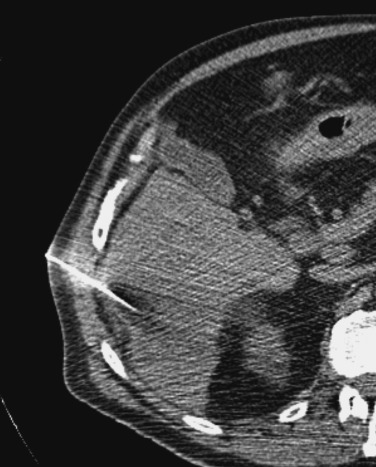
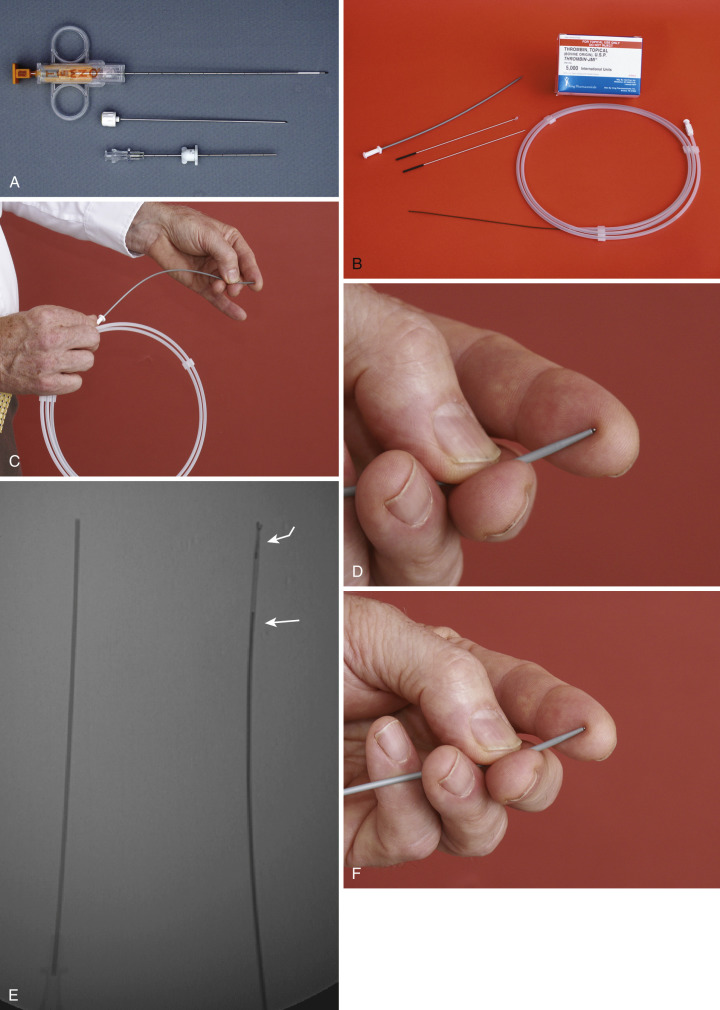
The rationale for this technique is that the local injection creates a local “seroma” of the missing product so that if any adjacent vessel is inadvertently punctured, the local elevated concentrate of the blood product provides material for an effective blood clot. With FFP the seroma concept is appropriate. With platelets, the platelets probably undergo immediate activation, which provides overabundant amounts of thromboplastin to initiate the thrombosis cascade.
From a physiologic perspective, investigators have shown that a native clot that forms at the site is superior to an injected “clot.” A clot formed after restoration of local or systemic coagulation factors is of better quality than one formed when an imbalance of coagulation factors exists. A “balanced” clot is more effective because studies have shown that the strength of a clot is due half to the platelet agglutination and half to the serum proteins.
The most consistent and practical method to prevent localized bleeding after a biopsy is placement of more solid occlusive material through a coaxial system after the biopsy has been taken and the needle has been removed. Four such materials have been used: Gelfoam, occlusive liquid “glues,” angiographic coils, and angiographic coils with thrombin.
In regards to injectable “glues,” numerous products have been evaluated in animal models and approved for clinical use, but in our experience their application is difficult. These products consist primarily of fiber material such as cellulose/Gelfoam or liquid protein material such as fibrin glue, which solidifies in the pathway after injection. A major problem of these products is that the fixation time of these materials is not predictable. When these are injected through a needle pathway, one cannot always be confident of the placement of the protein material. As the injection cannula is withdrawn, the protein plug may be pulled out. From the research data in the previous section, one appreciates that such artificial clots are not as good as natural clots.
Injection of Gelfoam through a coaxial system was reported by Chuang and colleagues. This method does not always work well because the Gelfoam is difficult to position properly and may be pulled out with the cannula, similar to the injectable materials.
Coaxial sheath with angiographic coils was reported by Allison and Adam. Although this technique has been reported as effective, we have altered it to use thrombin because angiographic coils have been changed from their original design. Until about 15 years ago, the coils had fabric on the end intended to serve as foci or anchors for clot formation. Those early coils had “wool” fibers on the coils, which was very thrombogenic, but the material was replaced with Dacron, which is not as thrombogenic. After being frustrated with the use of such coils because clot did not form quickly, we devised the coaxial/coil/thrombin method that we now prefer, which is the use of a coaxial system, angiographic coils, and thrombin.
We modified our technique to add thrombin after numerous studies. In a study of many coagulopathic animal experiments, we found that the coil with thrombin has three distinct advantages: (1) the coil is positioned precisely at the site of the biopsy “cut,” (2) the spring coil stays in place and does not “pull out” with the coaxial cannula, and (3) there is instant clot formation for the thrombin. After one becomes familiar with this technique, one easily prepares the items required for hemostasis either before a procedure or during the procedure when bleeding from the guidance cannula is noted. The coaxial cannula must always be left in place for access to insert the material. Preparation for this technique can be made before the procedure if the bolus injection shows increased vascularity or large collateral vessels. Required equipment includes two vascular dilators 6F or larger, angiographic coils, and thrombin ( Fig. 67-32A and B ).
Before the coaxial/coil/thrombin technique can be executed, the equipment must be assembled such that the dilators are loaded with the coils and thrombin so that they can be inserted as needed and noted in Figure 67-33 . The coils are loaded into the dilators and pushed carefully to the end of the dilator (see Fig. 67-32C ) and not beyond; holding the finger over the end as they are inserted prevents inadvertent deployment (see Fig. 67-32D ). The thrombin is mixed according to the instructions and injected into the dilator slowly while holding a finger loosely over the end (see Fig. 67-32F ). The idea is to permit the thrombin fluid to flow through, but not eject the coils if the injection is too forceful. Figure 67-32G shows a radiograph of a simulated biopsy, with the inner stylet of the needle inserted. Figure 67-32H shows a radiograph of the coaxial cannula after removal of the biopsy needle, and the coil with thrombin is pushed out the end of the cannula.
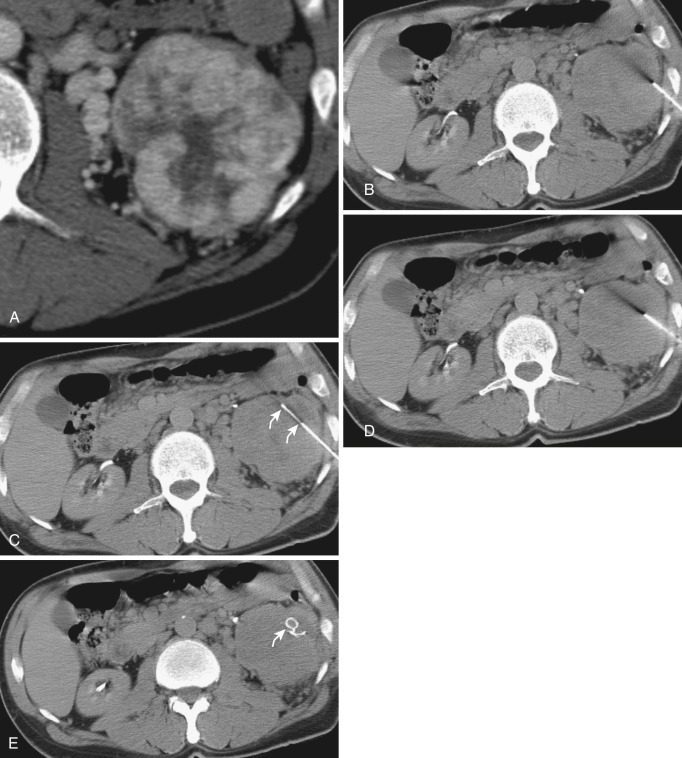
In cases in which an enhancing lesion is to be biopsied (see Fig. 67-33A ), we prepare the equipment as noted previously and inform the attending physician and the patient of the increased risk of bleeding and the method to be used to prevent bleeding. It is the prerogative of the patient and the physician to decline the procedure, but if it is decided to proceed, the routine steps are taken as noted in Figure 67-33B through D . The biopsy using the coaxial guidance system is performed in the routine fashion. The biopsy is performed through the cannula, and the tissue sample is removed with the cannula left in place (see Fig. 67-33B and C ). Through the cannula (see Fig. 67-33D ), an angiographic wire is used to push the coil through the dilator into the cannula and out the end of the cannula ( Fig. 67-33E ). After the procedure, the patient should lie quietly for 30 minutes to let a clot secure the occlusive material in place. If patients get up too quickly, the device may dislodge into the peritoneum if they happen to cough or exert themselves; there is no direct harm to the peritoneum except for possible bleeding from the site. This method may be used in the liver or other sites as needed. This coaxial method can be used with either a guided procedure of a mass or a diffuse sample of the liver.
Occasionally a unanticipated potential problem with bleeding may occur ( Fig. 67-34 ). In such cases, if excessive bleeding is observed from the hub of the cannula after biopsy of a lesion (see Fig. 67-34A and B ), one could decide to do nothing, but we prefer to proceed with this hemostatic method. If bleeding occurs, a stylet is inserted to delay the bleeding temporarily, and the equipment is prepared as noted earlier. If one has the equipment available, preparation takes only several minutes. As noted earlier, the coils are inserted through the cannula to provide hemostasis (see Fig. 67-34C through E ).
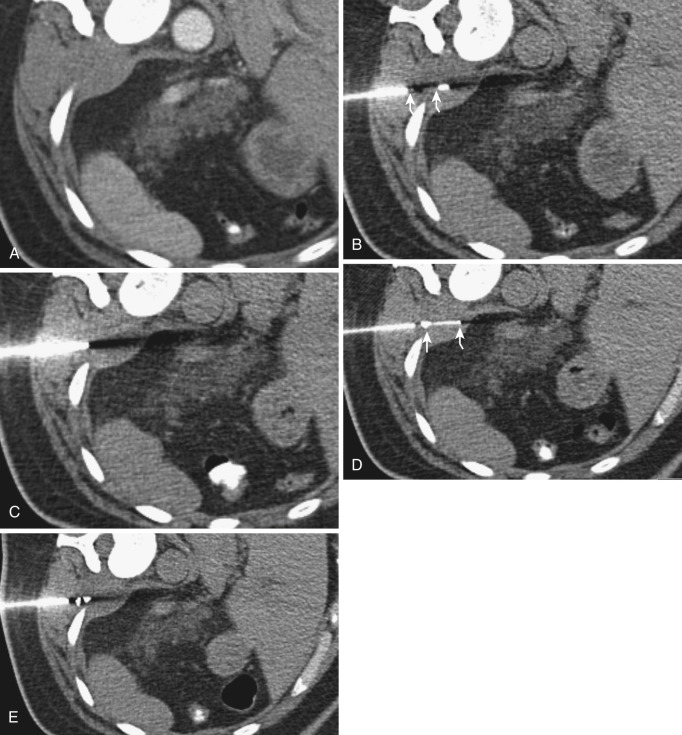
When first learning the technique, it is helpful to have fluoroscopy available because it is easier to follow the insertion of the thrombin/coil in “real time.” One can use the topogram or rapid repeat CT scans, however, to monitor the coil insertion. Such procedures can be performed at the bedside with CT or US, but this requires extensive experience because with this approach the procedure is essentially “blind.”
There are many consistent steps involved for performing all procedures. This section discusses in general the approach to be used, but for each organ system there are some variations, which are discussed in the corresponding organ sections.
For every procedure, the diagnostic imaging studies performed should be reviewed before scanning the patient, and the appropriate lesion target, the safest possible pathway, and the optimal patient position should be chosen to avoid uninvolved organs, vessels, bowel, and possible nerve sites.
Common sense dictates that potential problem areas such as arteries and veins should be avoided. Muscles can be a nuisance because they are highly vascular and can bleed locally. Also, when penetrated, muscles can be tightened purposely or unintentionally by the patient and cause difficulty with needle placement. The trajectory of a needle can be changed by a muscle contraction. If a powerful muscle group such as the spinal erector or gluteal muscles contracts, a needle can be physically bent. The most notable areas where this can be a problem are pathways through the sciatic notch and the retroperitoneum.
Patient position is decided to optimize the chosen anatomic approach. Patients may be in the supine, prone, oblique, or lateral position. Patient positioning is important for three reasons: (1) patient comfort, (2) anatomic approach for trajectory planning, and (3) producing immobility of a mass in cases where the target may be partially mobile or in patients who cannot completely cooperate. Having the patient in a comfortable position is important because patient discomfort may result in a movement at an inopportune time or increase the patient's anxiety and ability to cooperate. Increased patient anxiety generally affects the patient's ability to control his or her respirations.
Another important aspect of patient positioning is using patient position to shift internal anatomy to facilitate the biopsy; this has been discussed earlier, but it is worth repeating because of its great benefit. By having the patient lie in different positions, the anatomic access may be easier if internal anatomy shifts. Notable examples are seen in Figures 67-10 and 67-11 . As noted earlier, if a lesion being sampled seems to be mobile owing to respiratory variation, placing the ipsilateral side down can be helpful to limit the motion of the mass ( Fig. 67-35 ). In such cases, the weight of the viscera partially immobilizes the ipsilateral diaphragm and limits motion during quiet respiration (see Fig. 67-11 ).

When the entrance site has been chosen, the skin is prepared with povidone-iodine and a local anesthetic agent such as lidocaine is administered. At the time of lidocaine administration, it is important to palpate the tissue carefully to ascertain the location of the ribs, cartilages, and processes so they can be avoided. This is true especially next to ribs, the sacrum, the scapula, or other bony structures that have a tapered edge or traverse the scan obliquely. Such structures produce a partial volume error in the CT scan that results in a discrepancy between their apparent location on the scan and their actual anatomic location.
Administration of local anesthesia can be painless if it is performed properly using newer techniques instead of the traditional method. We believe the traditional method typically taught to medical students is antiquated; it was based on the use of procainamide, an older agent that had significant cardiovascular effects. The traditional teaching was that one should make multiple insertions and injections. According to the old method, one inserts the needle a small distance, pulls back on the syringe plunger to see if blood is aspirated, and then injects the anesthetic. That process was repeated numerous times until the entire pathway was infiltrated with medication. After one uses this method, one quickly realizes that every insertion of the needle is very painful because the tip extends beyond into unanesthetized tissues.
The new optimal method is as follows. The first step to permit painless local anesthesia is to modify lidocaine for injection to prevent the “burning” during injection and change the injection technique of the medication. We learned from plastic surgeons that the burning sensation produced during lidocaine injection can be eliminated by neutralizing the slight acid pH of lidocaine. To do this, one injects 5 mL of sterile injectable sodium bicarbonate into a 50-mL bottle of lidocaine. This preparation can be used in the standard manner as lidocaine. It can be used only during the 8-hour period following, however, because the sodium bicarbonate degrades the lidocaine slowly; it must be discarded, and a new bottle remixed after that time.
To lessen the discomfort during the needle insertions for the local injection, the technique is modified. The first important point is the method of injecting the lidocaine into the projected needle pathway. The skin wheal is made in the skin and subcutaneous tissues first, as always done before. During the subsequent injection of the lidocaine, the lidocaine is injected very slowly and the needle advanced slowly behind the injection. In this manner, a fringe of anesthesia precedes the needle tip, and the patient typically feels nothing but pressure—no needle sticks or burning from the medication. In effect, a small boundary of anesthesia precedes the tip of the needle as the pathway is extended.
At first consideration, this method seems to violate the concern about the possible injection of anesthetic agent into a vessel. The possibilities of this event are extremely remote; consider how difficult it is to perform a vascular puncture even when it is being intentionally done. Second, the “vascular/arrhythmia” concern arose in the early 1950s when procainamide was used as the anesthetic agent. If one reviews the literature, one cannot find any actual report about such an event. It is well recognized that lidocaine even when used as a cardiac antiarrhythmic agent is very safe, and very large doses are given; even if a microscopic injection occurred, it would be of no consequence. We have used this technique for 20 years and have never observed an adverse event.
Finally, when infiltrating local anesthetic, it is important to infiltrate the tissues down to the level of the pleura or capsule of the organ being sampled. One should completely infiltrate the pathway in two steps. In the first step, the skin, subcutaneous tissue, and superficial muscles are infiltrated. After that point is reached, the patient suspends respiration, and the local anesthetic is infiltrated down to and including the pleura, peritoneum, or the capsule of the organ (e.g., kidney or liver) (see Fig. 67-35 ). Such infiltrations should be made as the patient suspends respiration. If the capsule is not adequately anesthetized, the patient may jerk the diaphragm during the procedure.
In our opinion, inadequate administration of local anesthesia is the most common cause of poor patient cooperation. If a needle is inserted without anesthesia of the capsule, a “spinal level reflex” occurs; this moves the organ and produces a potential lacerating effect. Adequate anesthesia also is most important with anxious patients because they will not cooperate well if they feel pain.
The superior sample quality from a core cutting needle is no longer disputed. Numerous authors have reconfirmed the advantage of diagnostic accuracy with little difference in complications in most organ systems. There is no longer any controversy, and virtually all workers concur that cutting needles are superior to aspiration needles.
An aspiration needle is selected for four different reasons: (1) clinical cancer history, (2) increased vascularity of the lesion, (3) anatomic location, and (4) safety factors. If the clinical history includes a known malignancy and there is no suspicion of a second primary, an aspiration needle consistently provides confirmation of the disease. Comparison of the cytologic sample with previously obtained tissue samples provides definitive information.
Although highly vascular lesions may bleed with any type of needle and procedure, FNA does provide a lower incidence of bleeding. Certain anatomic sites are predisposed to complications or are close to critical structures. Thyroid, lung, pancreas, and spleen are sites with higher possibilities of complication, so an FNA sample would suffice. Anatomy may dictate an aspiration needle because of close proximity to structures such as vena cava, aorta, bowel, or nerves. With extensive experience, many such difficult lesions can be biopsied safely with small-core cutting needles because of the precision with CT placement.
Safety is the overriding factor that sways most operators to use the skinny needle. Reasons to stress safety and to defer to an aspiration needle include an uncooperative patient, a bleeding diathesis, or other unique factors in the patient's history.
A cutting type of needle is preferred whenever possible because it provides such a superior tissue sample. If the patient presents with unknown disease, possible change of cell type, previously failed aspiration, or suspected benign disease, a cutting needle biopsy should be performed.
A large needle can be used if clear access is available to the organ of the abnormality (i.e., no intervening uninvolved structure or close proximity of the aorta, vena cava, portal vein, or bowel). As experience is gained, skill increases, and one's safety tolerance relative to anatomy improves. Although a novice might be fearful of performing a biopsy of a node several centimeters from the aorta, an experienced individual would be comfortable biopsying some lesions that abut the aorta.
One factor we still consider important is to assess the vascularity by observing the enhancement during a stationary dynamic bolus scan over the site of the lesion. Vascularity is an important issue for prevention of bleeding complications. The importance of the basic vascularity on the incidence of biopsy complications can be appreciated by noting the incidence of complications in the liver when bolus scans are used to biopsy the liver and the series of cases where no such assessment occurs. Bret and coworkers reported a series of biopsies on hepatoma patients using 22-gauge aspiration needles and had a hemorrhagic complication rate of almost 5%. In our 32-year experience of liver biopsies using 14-gauge needles, we reported a hemorrhagic complication rate of 0.5% in a group of 200 patients (see “ Liver ” section). Some slightly vascular masses may be biopsied using the hemostatic occlusive method discussed earlier.
The selection of aspiration needles is straightforward because there is clear laboratory and clinical information that indicates the best type and caliber of FNA needle to use. These points were shown by historical articles and have been reconfirmed over the years without controversy. In the earliest laboratory study by Andriole and associates, our group showed that the best samples with the least amount of tissue artifact were obtained by the small-angle bevel needle tip (25- to 30-degree angle) and by the largest caliber needle ( Fig. 67-36 ). This was later confirmed by Dahnert and colleagues.
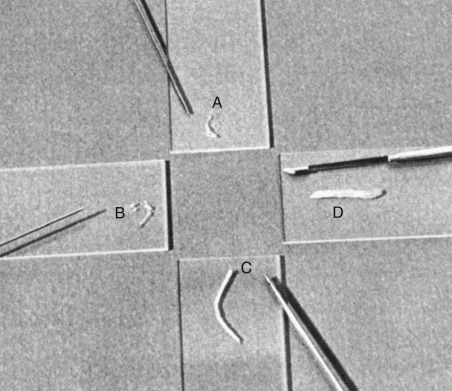
In the direct clinical comparisons, these results were reconfirmed. Pagani showed with aspiration biopsies of the liver that an 18-gauge aspiration needle was better than a 22-gauge needle. In the lung, there has been no definite benefit shown with large aspiration needles, and there was a larger incidence of hemoptysis shown by Khouri and colleagues. In the pancreas, Dickey and associates of our group showed the diagnostic return for a 20-gauge needle compared with a 22-gauge needle, with no difference in complications. Reporting on the prostate, more recently Norberg and coworkers showed increased diagnostic yield of the 0.9-mm needle (20 gauge) over the 0.8-mm (22 gauge) or 0.7-mm aspiration needles. From our experience and the numerous reports as noted earlier, we have consolidated the needle choices in our institution to use the 20-gauge FNA needle in all organs. It is suitable for lung and solid organs.
Many variations of cutting needles exist, so numerous factors should be considered in the decision making. The first question is whether to use an end cutting needle or a side cutting needle for soft tissue or bone. There seems to be little controversy from either the scientific perspective or the clinical perspective about the merits and shortcomings of these needles. Numerous authors, including Bateson and colleagues and Andriole and coworkers, have shown that the side cutting needle provides the best sample without crush artifact or fragmentation of the core. For bone, the appropriate needle is the end cutting needle unless the target is associated with soft tissue. The cylindrical end cutting needle is the strongest and does not have the risk of bending. The side cutting needle with the thin waist of the stylet can bend even if within the cannula.
The first decision to be made with cutting needles is whether to use a manual or automated type; most operators choose an automated variety. A survey by Mayoral and Lewis showed that more than 90% of radiologists doing liver biopsies use these devices; the only variables are the vendor and caliber of the needle.
Probably the most important decision to be made is whether to use a single- or double-action needle. The terminology does not refer to the action of the needle, but rather the requirement of the operator. One can understand the two-step mechanism by reviewing the images of the manual type of needle shown in Figure 67-37 . A single-action device means that the operator needs to do only one thing: “push” the button or “pull” the trigger. The double-action device requires that one insert the inner stylet with the tissue receptacle and actuate the cutting action of the outer cannula as a secondary step. When the stylet is introduced, it defines the site of the biopsy. The double-action type is safer than the single-action device when there is critical anatomy close by.
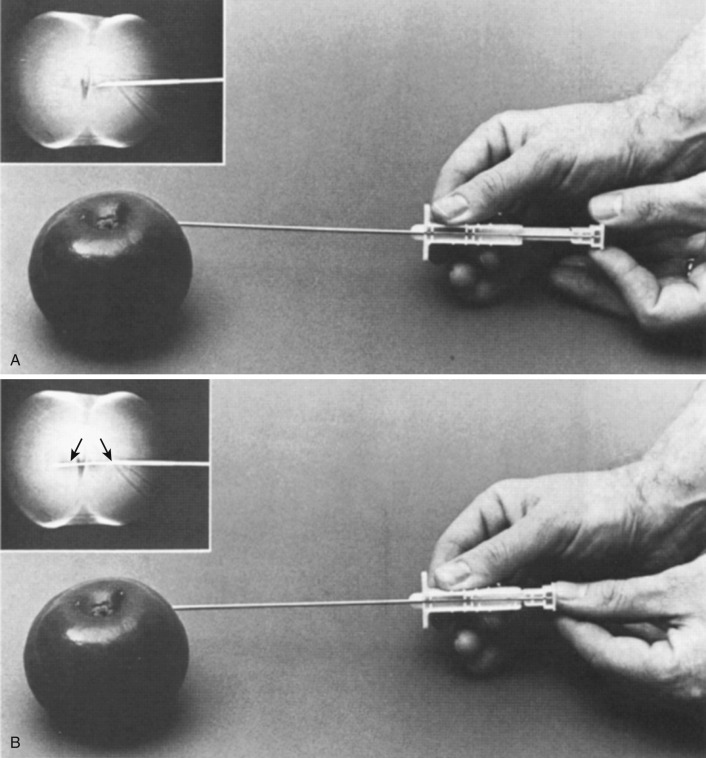
In our opinion and experience, single-action devices should be avoided ( Fig. 67-38 ) for reasons described subsequently. When a small lesion in a precarious location is being sampled, one has to be absolutely certain about where the cutting action occurs. An experienced interventionalist knows that if a patient shifts position slightly, the internal anatomy can change by numerous millimeters or centimeters. This change can happen very subtly, and if undetected, catastrophe can occur if one is using a single-action device (see Fig. 67-38 ). In a case in Ohio that was litigated, a patient died because the main pulmonary artery was biopsied inadvertently. Because a single-action needle was used, the final position of the stylet was not seen because it fired instantly before the cutting action. With the double-action needle, the stylet is inserted separately, and the exact location can be noted. The cutting action occurs precisely at that site. Hemostasis is more effective with use of a hemostatic occlusive method such as the coaxial/coil/thrombin technique.
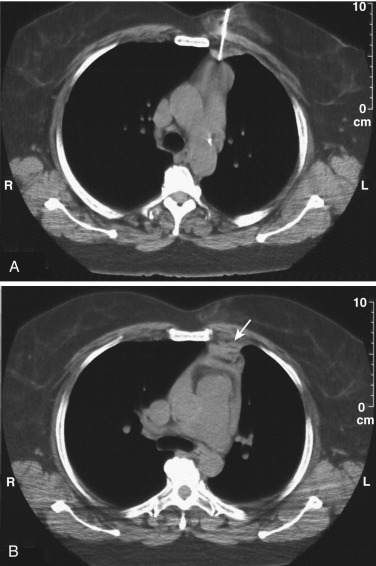
The final decision to be made is the caliber of the needle. This decision depends on the amount of tissue required for the histopathologic studies to be performed and the organ sampled. In the new era of tissue biomarkers, routine and possibly repetitive biopsies are expected to become the norm. Workers from our group have provided some insights relative to needle caliber and its relationship to bleeding and the amount of tissue acquired. Gazelle and colleagues showed that increased bleeding occurs with certain calibers of needles in the normal and coagulopathic states (see Table 67-1 ). From the work by Plecha and associates, one can determine the amount of tissue obtained with each size of needle ( Table 67-2 ). Plecha's group studied the outcome in an animal model using 20-gauge, 18-gauge, and 14-gauge needles. These authors evaluated the amount of diagnostic information compared with the amount of bleeding by weighing the amount of DNA (nuclear material) and blood in the tissue sample. They noted that the larger the amount of tissue required for the diagnostic information, the more efficient it was to use a large-caliber needle.
Equally important as obtaining adequate samples is reducing the possibility of bleeding. Recognizing that bleeding is the result of multiple factors, including the natural vascularity of the organ (spleen > kidney > liver), the specific vascularity of the tumor, and the random event of striking a vein or artery, one can choose the optimal caliber. Smaller needles require more passes, producing greater statistical chance of striking a vessel. We select the caliber of the needle according to the type of organ being biopsied, the specific type of histopathologic evaluation to be performed, and the characteristics of the organ being sampled (see discussions under each organ system).
Assessing vascularity before sampling an abnormality is especially important with a cutting-type needle. In most instances, the vascular character of the lesion is apparent from a prior contrast-enhanced study. If not, one should perform a study with a bolus of contrast material and repetitive scans at the site of the biopsy to evaluate the vascularity. Not only do cancers have increased vascularity, but unusual benign vascular abnormalities (e.g., arteriovenous malformations [AVMs], aneurysms, cavernous transformation of the veins) occur in virtually all organs; detection of such lesions by a dynamic scan prevents a bleeding complication.
From our experience and review of the literature, the vascular nature of an abnormality is a major determinant of bleeding complications. High bleeding rates occur even with 22-gauge needles when vascular tumors such as hepatomas are biopsied. In our latest series of 200 liver biopsies, the complication rate with a 14-gauge needle was 0.5% because we assessed tumor vascularity with a dynamic bolus scan over the site of the selected target. The lesions that were too vascular or close to vessels were deferred; this study was before our refinement of the coaxial/coil/thrombin technique. It is likely that we would not have deferred any biopsy because of vascularity had we had the technique during this period.
As noted earlier, with coagulopathic patients, the smallest caliber appropriate should be used depending on the “contingency” hemostatic method used—systemic blood products, local injection of blood products, or the coaxial/coil/thrombin technique (see “Coagulopathic Treatment”). The systemic replacement to normal status permits any size of needle, as does the local injection method. The coaxial/coil/thrombin technique requires a coaxial needle system of 18 gauge or larger; we defer to the 18 gauge.
Numerous clinical articles have studied the histologic information obtained from tissue samples for kidney and other organs. Hopper and colleagues showed that sufficient diagnostic tissue could be obtained from the kidney with an 18-gauge needle in pediatric patients. Haaga and associates found in a comparison of 18-gauge and 14-gauge needles that the diagnosis was equivalent for both devices. A survey of gastroenterologists and radiologists showed that most physicians use an automated side cutting needle in the range of 18 gauge.
Although the use of the 18-gauge needle is the norm in the United States, there is good reason for radiologists to begin using large-caliber needles in selected cases. In recent years, new methods developed at our institution in conjunction with the National Cancer Institute portend to enhance the development of new cancer agents and drugs by using samples from 14-gauge needles in selected cases. As reported by Dowlati and coworkers, we had a 0.5% bleeding rate with 14-gauge cutting needles in the liver in a series of 200 patients. In these trials, large needles were used to recover histologic samples, suitable for microchemical assays of molecules that were the specific target of cytolytic or modulating agents. These trials permitted more rapid drug development at lower costs. Improvements in determination of pharmacokinetics and dosage regimens occurred to the extent that a new term, the BMD (biochemical modulatory dose), was coined. In some cases, this term was substituted for the MTD (maximum tolerable dose before unacceptable complications occur).
Having innovated cutting needle biopsies using CT guidance and advocated their use for many years, it is ironic that we are now concerned that cutting needles occasionally are used too frequently by some operators. We have always been strong advocates of their use but continue to emphasize the importance of judgment when selecting them to achieve the greatest tissue yield, using proper patient selection, approach, and techniques to minimize the potential complications. We have not changed our opinion on the superiority of the tissue samples, but rather we are concerned about the cavalier attitude some operators have for minimizing the possibility for complications.
We have noted that some physicians use the cutting needle with impunity and put patients at great risk and themselves in great legal peril. Lest one misconstrue these statements as indicating that we have a high complication rate, our complication rate (according to the National Cancer Institute, which monitored all of the NIH studies and reviewed the charts) was 0.5% in a group of 200 patients (see “ Liver ” section).
Figure 67-39 presents a case that shows the exact opposite of all our recommendations. This case was performed by a community radiologist in a nonuniversity hospital and resulted in two significant life-threatening complications. The radiologist used an 18-gauge cutting needle for a deep lung lesion, which predisposed to severe hemoptysis (a 20-gauge cutting needle should be used for such deep lesions). The cutting needle was deployed with the inner stylet outside of the mass and adjacent to a vessel (see Fig. 67-39 ). The patient had a large pneumothorax and large hemorrhage in the right lung; the pathologic diagnosis was inconclusive (not a surprise, seeing that the needle was not properly positioned in the mass).
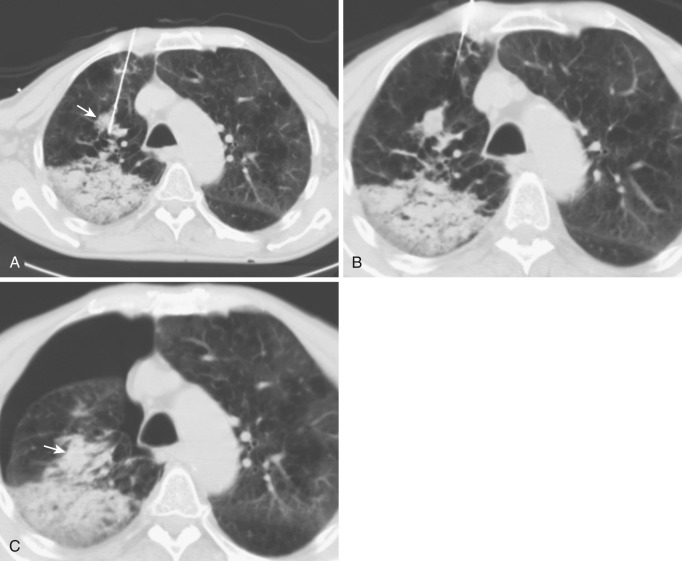
The reader is urged to take our recommendations and suggestions because we have performed these procedures for 33 years, including approximately 20,000 personal experiences. Everyone must develop their own guidelines, but it is always better to err on the safe side.
Since the prior edition, significant data have been published that confirm a higher incidence of needle track seeding than previously reported. In view of this, the single-needle technique probably should be reserved for lung lesions (hemoptysis and pneumothorax are more likely to occur with larger needles). Even mediastinal biopsies are well suited for the coaxial system because when the cannula has been carefully placed past the major vessels, repeat biopsies can be taken if needed.
The single-needle technique is simple because it uses the primary instrument as the device primarily localized. This technique is typically used when one anticipates taking only a single sample. The usual clinical scenarios differ with the aspiration needle and the cutting needle. With a Chiba needle and a lesion that is large and accessible, it is easy to perform several procedures as needed without concern about repeat positioning of the needle. With large cutting needles, a 14-gauge needle usually is used to obtain a sample; seldom are multiple samples needed in such a circumstance.
Coaxial methods offer significant advantages. In the prior editions, we made a distinction between a short cannula versus a long cannula, but in view of needle track recurrences reported, the long cannula method is the only one that should be used. There are three benefits to the coaxial cannula method:
With the cannula in place, one can take repetitive biopsies of skinny needles and larger cutting needles without requiring relocalization of the needle.
If one encounters a localized bleeding problem or question, it is simple to occlude the pathway with an angiographic coil/thrombin even if the bleeding was not anticipated.
The coaxial system prevents tumor seeding in the needle track.
Maturen showed that the coaxial method reduces the occurrence of needle track seeding because the guidance cannula prevents shedding of tumor cells in the pathway.
The standard aspiration procedure is simple and can be broken down into four individual steps: (1) localization of the needle tip in the lesion, (2) application of suction, (3) movement of the needle, and (4) delivery of the sample to the appropriate medium for evaluation. Repeat needle passes are made as appropriate.
Localization of the needle tip in the site of the mass is crucial and likely the most important step. Having the tip close to the target does not suffice. If small changes are necessary for correct placement, the needle deflection methods described subsequently may be helpful.
Application of suction is important because it enhances recovery of adequate cellular material. The amount of suction to apply has been evaluated by our group and others. In a laboratory model, we found that displacing the syringe barrel by 5 mL produced about 84% of obtainable sample, and that displacement of the barrel by 10 mL produced 94% of the obtainable sample ( Fig. 67-40 ). Kreula and associates had similar findings; there was an “apparent” slight discrepancy between our data and Kreula's data, which can be easily reconciled. Kreula's group used absolute pressures, whereas we used a clinical analogy of displacement volume of syringe during application of suction. Our curve is asymptomatic, reaching a limitation after a linear rise. Kreula and associates reported a straight-line relationship between the sample and the vacuum because they measured only the effects corresponding from 0 to 5 mL of syringe displacement.
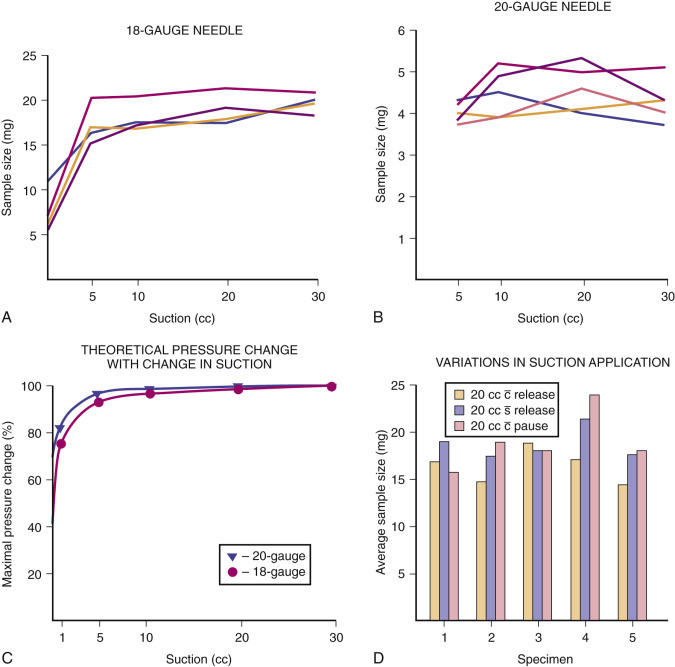
Suction can be applied by two different methods. A two-person technique can be used with one person applying suction and the second holding and moving the needle. The usual approach entails plastic connecting tubing between the needle and the syringe. This is more convenient from a personal perspective, but it actually may provide less suction because the plastic tubing is pliable: when suction is applied, it partially collapses, reducing suction. This method was first applied by Menghini in the 1950s but was later abandoned for the one-person method. The one-person method has the radiologist applying suction while at the same time stabilizing and moving the needle. One important point is to maximize the vacuum during the movement of the barrel; it is important to ensure that all of the air has been expressed from the syringe before hooking it up to the hub. Even a small amount of air dilutes the vacuum when the barrel is moved.
Historically, some groups advocated the use of no suction during the sample acquisition. This “capillary” method works with very necrotic tissue such as squamous cell tumor, but not with most tumors. Some authors have asserted that the application of suction pulls too much extraneous material, especially blood, into the needle, but a more recent study by Ha and coworkers showed that such degradation occurred in only 6% of cases ; this slight tradeoff is minimal compared with the improvement of the sample. Depending on the fixative chosen, the red blood cells can be lysed by certain additives to the fixative material, eliminating the problem.
Movement of the needle should be made to free tumor cells for the sample, with the needle tip confined to the tumor site. The movement is best performed by very small reciprocating motions of 2 to 3 mm, which enhance displacement of cells into the needle barrel. Movement of several centimeters is excessive because the needle tip moves in and out of the mass into the adjacent normal tissue. This movement introduces blood into the sample and injures the adjacent tissue. A common error by inexperienced operators is making these large movements until blood is aspirated into the syringe or plastic tubing (usually occurs with the two-person technique). During the removal of the needle, it is important to maintain the suction to retain any fragments in the lumen of the cannula. The in vitro study by Hueftle and Haaga of our group documented the definite benefit of this movement (see Fig. 67-40 ).
The diagnostic sample should be delivered on the slide and into a separate solution for washing the needle and syringe. A “perfect” sample is orange, owing to a small amount of blood and a large number of white tumor cells. After a sample has been taken, it is crucial that it be handled properly. The smear is performed quickly near the fixative to prevent drying, which can occur quickly. The syringe and needle are always flushed with fixative, and the fluid is sent for tissue cell block or cytocentrifuge, depending on the routine approach at an institution. This practice can increase the diagnostic yield by several percentage points. Kasugai and colleagues reported that heparinizing the needle and syringe is helpful, but no other authors have confirmed this. Other authors have measured the carcinoembryonic antigen in the cytologic samples and found this test useful.
Repeat needle passes (four to five passes) have been recommended by some authors to enhance diagnostic accuracy. From our experience, equivalent diagnostic accuracy can be achieved with two well-positioned, meticulously performed aspirations or a small-caliber cutting needle; this has been well documented by Smith and associates and Sargent colleagues (see “ Brief Historical Summary of Image-Guided Biopsies ”).
The emphasis on taking many needle passes has evolved incorrectly from misinterpretation of an article by Ferrucci and colleagues. These authors took a sample of 20 cases, proven positive by cytologic results, and looked at the incidence of positivity with each needle pass. At first glance, one would believe that 100% accuracy could be achieved with many needle passes, but this is not true; 100% of this group had positive results because they were selected as positive at the onset. In the same study, the total group with five needle passes had only an 82% accuracy, not the 100% of the selected group.
As noted previously, the best cutting needle for soft tissue tumor is the single-action side cutting needle, and the best cutting needle for bone or hard tissues is the end cutting needle. The side action cutting needle is based on the original manual Tru-Cut design. This manual device (see Fig. 67-37 ) is the prototype of virtually all cutting needles used today. We have retained this figure even though it has been used in numerous editions of this book because it clearly shows the mechanism used in all manual or automated side cutting needles. By understanding the basic mechanism, the various devices can be better understood, especially the significance of the single- and double-action needles.
Side cutting needle advantages are severalfold. As affirmed by numerous in vitro tests conducted by ourselves and Hopper's group, this design provides the most complete and preserved samples of all needle types. Also, because the location of the biopsy is confined to the “gap” of the needle, one can carefully localize the site of the biopsy. The action of the needle is so precisely predicted that it can be used near other structures.
Another advantage of this needle is that if a double-action needle is used, the tissue gap of the stylet can be moved or adjusted as needed without any adverse effects on the tissue. The cutting action occurs only when the outer cannula is advanced forward manually or by the power device of the automated devices. Catastrophic events as noted in Figure 67-38 can be avoided.
Automated needle use can be optimized by several approaches. These approaches improve the diagnostic yield and minimize the possibility of complication. To improve the diagnostic yield, several additional factors and steps can be taken. The gap of the stylet defines the precise site of the needle biopsy; although the sliding cannula cuts the tissue, it moves over the stylet. One can precisely determine the location of the biopsy, which optimizes tissue acquisition and minimizes collateral damage. When automated devices push the stylet forward, there is a backward recoil of the device, which may affect tissue recovery. To prevent push-back of the needle and a smaller sample, the device should be held firmly. Kellermeyer found that holding the needle firmly would improve the yield by reducing the recoil (personal communication, 1993). In his unpublished data, there was a 14% improvement of the yield. Another anecdotal factor is that one should hold the device exactly as explained in the instructions. If an operator holds such a device casually without the fingers in the correct location, the movement of the actions may be impeded and the sample less than optimal.
Several additional important comments about side cutting needles should be made relating to the stylet for acquisition and safety. First, when the cutting needle is removed from the packaging, one should inspect the stylet with the cutting gap. Occasionally it may be bent slightly forward ( Fig. 67-41A ) and should be straightened or bent slightly back. If the needle is bent forward, a smaller sample would be obtained than if the stylet were bent to the proper shape (see Fig. 67-41B ). Second, there is one word of caution about these needles relative to bending: These needles should not be used for very hard tumors or bone. The thick waist of these needles can bend if too much force is applied, even if the needle is closed ( Fig. 67-42 ).
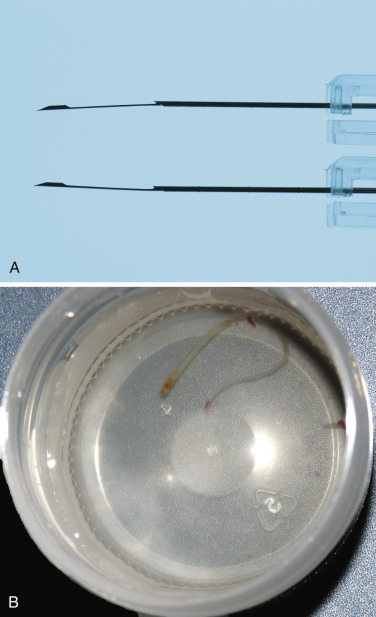
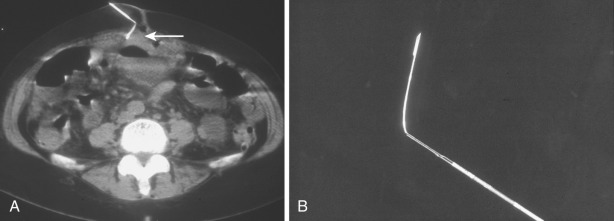
Positioning a needle in the same xy plane of an abnormality is the simplest approach if possible. In these cases, with the needle in the superficial tissues, the angle of the needle is adjusted with repetitive scans until angled correctly. When the correct angle is achieved, the device is inserted to the desired depth either with incremental adjustments and repeat scans or to a premeasured distance. Subtle adjustments of the needle can be made using the deflection principles, or cannula manipulations noted in the following sections may be used meticulously to optimize the needle position.
After insertion of the needle, one occasionally may have some difficulty in localizing the tip. Several methods can be used to solve this problem. The simplest method is to take a longitudinal scan and take an axial slice at the end; this is virtually foolproof and is the most expeditious. Another method that can be used if the angle of the needle is slight involves taking multiple scans in one direction until the end of the needle is reached ( Fig. 67-43 ). Some new scanners have a cluster scan feature consisting of three or more scans, which is well suited for this purpose. When the end of the needle is found, it appears to have a square end and may have an artifact from the end. Occasionally the end of the needle is not square but is easily appreciated by noting when the end is no longer seen on sequential scans.
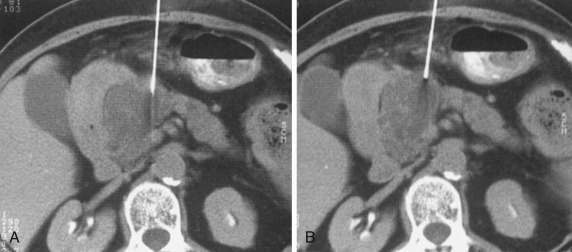
With a bevel needle, the needle either moves straight or deflects depending on the hardness of the mass, angle of the needle, and speed of insertion. A hard mass is likely to deflect the needle if the trajectory pathway is not perpendicular to the tangent of the entrance point. If a beveled needle is pushed slowly, it is more likely to move the point away from the flatter part of the needle. If a needle is pushed quickly, it tends to go straighter. For very hard masses, deflection may not be avoided unless one continuously rotates the needle during insertion or a stiff guidance cannula greater than 18 gauge is used. In moderate-density material, controlled deflection is possible.
With the intentional needle deflection method, one can change direction of a needle when it is located in a patient below the surface of the skin. Purposeful deflection can change the angle of the needle at the latest stage of adjustment before striking the mass. This deflection is best accomplished by rotating the needle so that the flat side of the bevel is facing the area one wishes to avoid, and the point is directed more toward the target direction. The skin adjacent to the needle is pulled away from the point. This changes the fulcrum of the needle so that it is more angled toward the target ( Fig. 67-44 ). The needle is then pushed slowly. By using this method, one can change the direction of the needle by 10 to 15 degrees, which can amount to a 10-mm change; this can prevent the need for a major readjustment or reinsertion of the needle ( Fig. 67-45 ). This technique works only with a needle with a single bevel at the tip and not with needles with two bevels or a central point, such as a pencil or trocar point.
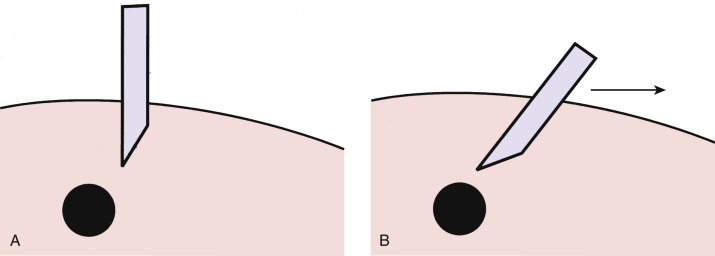
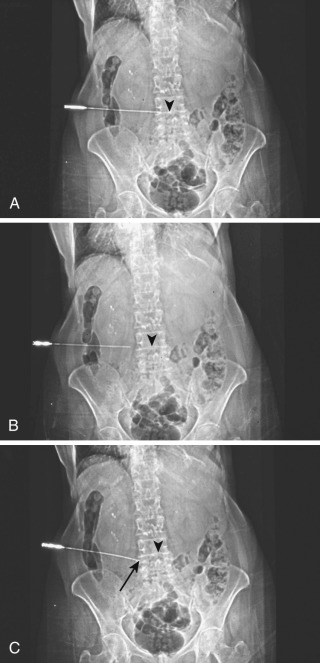
This technique also can be used with the thin stylet of a cutting needle ( Fig. 67-46 ), which permits repositioning without removing the entire needle. To achieve this repositioning with the double-action technique, the needle is positioned adjacent to the target, slight pressure is used to deflect the shaft of the needle away from the bevel, and the stylet with the bevel is pushed slowly into the target.
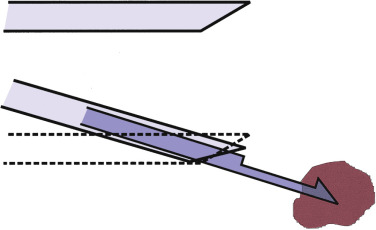
Because the coaxial approach has such benefits as described earlier, one should consider the possibilities with the guidance cannula. Because the guidance cannula is stiffer than the basic needle, it can be used to torque the needle. This is done by simply angling the cannula in the desired direction. One must be aware that such devices are stiff, and moving such a device potentially can produce shearing.
The intended deflection noted earlier can occur with a coaxial cannula. Another technique that can be used to move a needle into a difficult area combines the benefits of a Chiba needle with a cannula. For lack of a better term, we have called this a cannula slide maneuver . If one wishes to use a cutting needle beyond a vital structure, one can advance the cannula in the following fashion. Through the cannula, one pushes a bevel Chiba needle beyond the vessel. Then one advances the cannula forward over the small-caliber needle. When the cannula is distal to the vital structure, one can use the cutting needle safely. We have used this technique in the mediastinum and the pelvis (see Figs. 67-77 and 67-131 ) in lung sections.
In some cases when a biopsy is being attempted with a side cutting needle, the placement is not completely optimal because the “needle gap” misses the mass slightly. In such cases, one can increase the probability of getting an adequate sample by rotating the needle so that the gap is oriented toward the center of the mass ( Figs. 67-47 and 67-48 ).
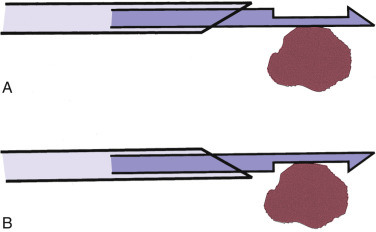
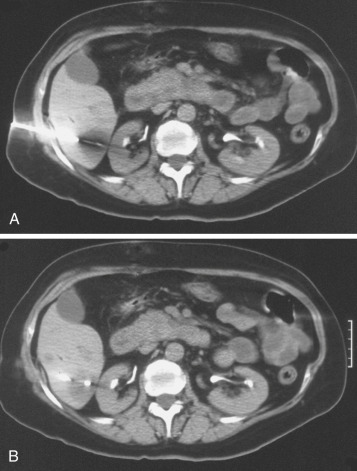
When a needle must be inserted into a lesion located at a different z axis position, different approaches must be taken, 3 of which are: (1) freehand, (2) angle estimated, or (3) device assistance (see “ CT Fluoroscopy, Guidance Devices, and Robotics ”).
With the freehand approach, it is best to consider the approach to the lesion as a 3D system. The final vector or angle of the needle to the lesion would be a combined angle consisting of the xy angle and the yz angle. When doing this, it is best to establish the xy angle in the superficial tissues of the lowest slice before attempting the z angulation. When the xy angle is proper, one can consciously hold that angle constant while moving the needle into the z axis ( Fig. 67-49 ).
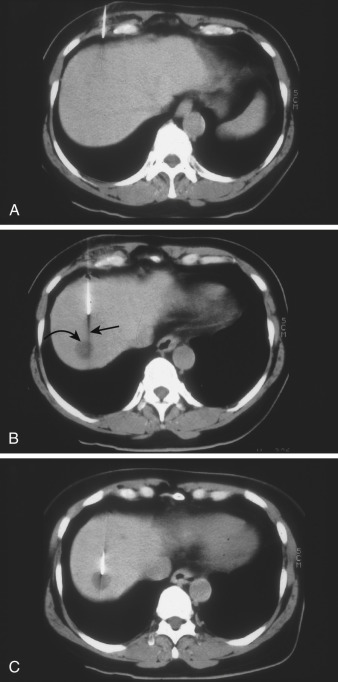
When the needle is close to the target site, numerous scans are made over the path of the needle to judge the position in 3D. If a minor adjustment needs to be made, one should use the tip deflection method described earlier under “Intentional Needle Deflection.” Using this technique after the first major angulation has been accomplished saves time and makes success more likely.
The angle-estimate method is a permutation of the freehand method, but more care is given to trying to calculate or simulate the angle more precisely. Most simply, this is done by using a calculation of the Pythagorean angle from the scans to arrive at a numerical angle in the different planes ( Fig. 67-50 ). The execution of the instrument insertion is performed by the freehand method or by using a manual angulation device.
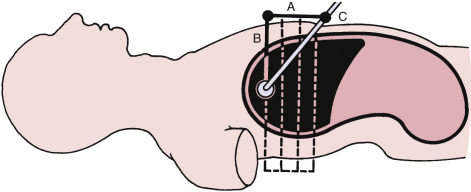
Placing the patient in lateral or oblique positions produces shift of internal anatomy so that loops of bowel or organs may move sufficiently to open a procedure trajectory pathway. In most instances, bowel shifts to “float,” and solid organs “gravitate” or “roll” depending on capsular attachments. Although one might predict such movements, trial and error may be needed. If one positional change does not work, rotation to the oblique or the opposite side might produce the desired effect.
Although one can penetrate certain loops of bowel and uninvolved organs in some circumstances, it may be advisable to avoid certain structures or to protect them from unintended damage during ablation procedures. Two methods have been used for dealing with this problem: injection of carbon dioxide and injection of saline.
We reported in 1986 that carbon dioxide insufflation or room air can be used to move structures short distances. Other authors have proposed the use of injected saline to increase the size of pathways through which one can insert a needle. This technique has been used predominantly in the chest for widening the paraspinal space, but potentially it could be used in other locations (see later under “ Lung and Mediastinum ”) ( Fig. 67-51 ). Langen and colleagues studied the efficiency of carbon dioxide and saline in an animal model to move structures from a needle trajectory pathway. With equivalent amounts of gas or saline, they found that the saline produced substantially more movement of organs than carbon dioxide. Neither fluid nor gas moved solid organs, such as kidneys.
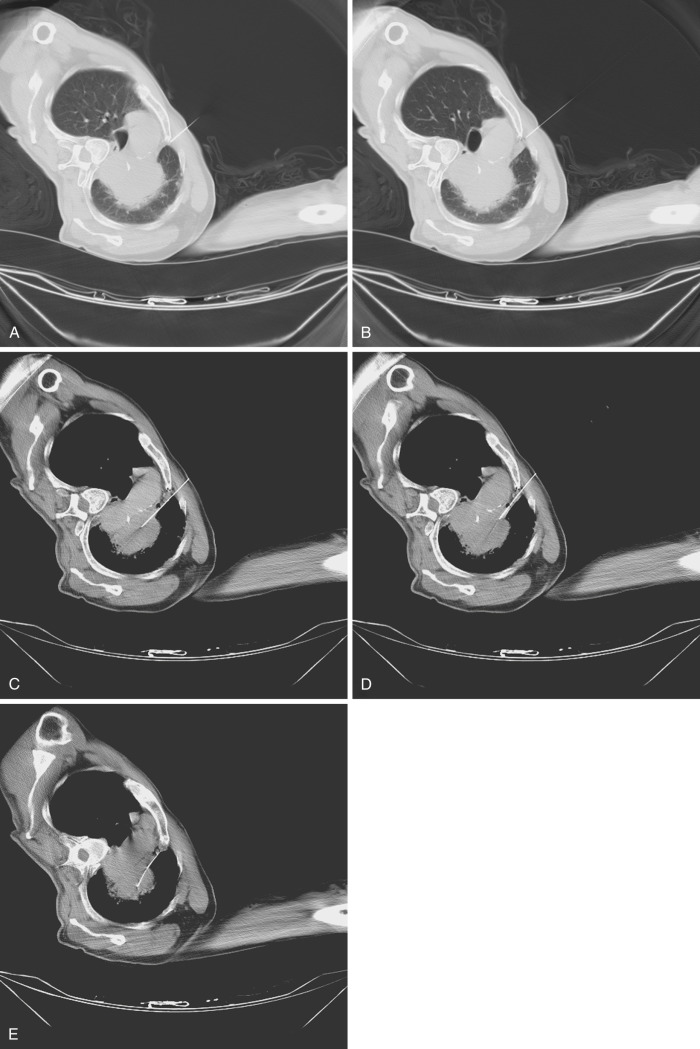
More recently, many authors have reported using such materials to prevent inadvertent damage to adjacent structures during ablation procedures. Authors have reported the use of saline or water to provide a conductive layer between the thermal ablation site and any adjacent normal structures. Laeseke and coworkers reported the use of dextrose water and saline to prevent thermal damage to adjacent uninvolved structures. In their animal model, dextrose prevented damage better than saline, permitting smaller sites of damage (perhaps because of conductivity of saline). Kariya and associates reported the use of injected carbon dioxide to produce “insulation” between the thermal site and normal structures. The maximum distance was slightly greater than 1 cm. Caveats for saline injection include patient discomfort, decrease in target lesion conspicuity, and adverse effects of absorbed fluid in patients with kidney or heart disease.
Both of these methods have a similar problem. Depending on the location of connective tissue, either the gas or the fluid may dissect cephalad or caudad and not produce substantial enlargement in the axial plane. Nevertheless, both of the methods can work in selected cases. Another caveat is the effect of severe inflammation or tumor infiltration. If either of these is present, movement or displacement may be impaired.
The procedure is performed easily. After the trajectory is planned, the operator decides from the scans the proper location of the gas or liquid. The operator inserts a needle and injects by hand 50 to 100 mL of the material ( Fig. 67-52 ). If the intended loop of structure does not move, the operator attempts to reposition the needle or repeats the injection. Depending on the length of the procedure, repetitive injections might be necessary because the material disperses gradually along fascial planes, and the displacement decreases accordingly.

In some patients, it may be possible to move an intervening loop of bowel by manual palpation through the skin. Anyone who has ever performed fluoroscopy is familiar with how mobile loops of bowel may be. Tuncali and colleagues used manual displacement of bowel to provide greater clearance between the iceball of cryoablation and adjacent bowel loops to prevent collateral damage. In a group of 14 patients, mean distance between tumor margin and closest adjacent bowel increased from 0.8 cm (range 0-2 cm) before external manual compression to 2.6 cm (range 1.6-4.1 cm) with manual displacement ( P < .01). Occasionally we have used this technique for biopsies, and it has been beneficial.
Real-time monitoring of instrument insertion by rapid CT acquisition is now possible. First conceived by Katada of Fujita Health University, Japan, the technique was implemented by Toshiba and subsequently by other vendors. This technique has been used only occasionally by radiologists; some estimate that only about 30% of radiologists use it. The reason for the low usage is unclear, but it is likely related to inexperience and the potential higher radiation dose to the patient and the operator. Logically, if radiologists are capable of high-quality effective procedures without direct exposure to themselves, they would not use CT fluoroscopy. With the growing interest in screening CT and earlier diagnosis of tumors, however, many more patients are being triaged for percutaneous needle biopsy. The issue of respiratory variation becomes much more significant with small lesions, so we believe that this tool will be used more and more for biopsy procedures.
Numerous devices have been conceived, developed, and commercialized for guidance assistance, but these have not become a part of the mainstream practice of most radiologists. More sophisticated ancillary guidance devices are being designed; these are expected to simplify the performance of CT-guided, US-guided, and MRI-guided procedures. One device introduced by Magnusson and Akerfeldt seemed to be effective, but for unknown reasons, attempts to market the device were unsuccessful.
The likely reason that these devices have not succeeded is that interventional radiologists have unique skills and are well trained. Most develop a skill set that permits them to execute such procedures almost freehand or using the simple methods described earlier.
With high-resolution MDCT scanners, 3D reconstructions, and the progress in robotic systems, there is no question that in the remote future robot-assisted procedures will become available. The robot will truly facilitate and not replace the physicians. A caring physician/radiologist will always be needed on site to use the robotic assistances, monitor the procedure, and manage the patient, but targeting lesions will be much easier. In our opinion, such procedures are not likely to be done remotely from across the country or world because caregivers must be present to manage the psychological and physical needs of the patient.
We have performed some initial testing using a standard industrial robot and have found it to be promising (see Fig. 67-1 ). The optimal device has yet to be designed, but there is little question that such a device will become available. In a swine model, we tested a robot for the execution of a celiac nerve block. The execution of the procedure was faster and more precise than we ever imagined. In contrast to manually performed procedures, during which needle adjustments are made below the skin surface to account for small errors during the insertion, the robot executed the insertion quickly without error (see Fig. 67-1 ). The final configuration and type of robot have yet to be determined, but its time will surely come.
As already stated, robots will never replace the interventionalist because patients require the physical presence of a sympathetic and skilled physician. It is likely that the final device will be an “assisting device” controlled by a physician in the room to direct the robotic hand into the radiation beam during CT fluoroscopy. With a physician nearby in the room but away from the x-ray source, the physician can serve as a failsafe in case of instrument failure.
The first experience using skinny needles with image intensification guidance in the lung was reported by Dohlgren and Nordenstrom in the 1960s. Sargent and colleagues also performed biopsies without image intensification, with good results. When image intensification became standard, many authors, including Lauby and coworkers, Lalli and associates, Westcott, and Sinner, reported their series. Many important observations were made about different factors that alter diagnostic accuracy and complications, which are discussed in the following section on lung procedures.
Although the early studies were typically small, were not designed well, and did not assess the proper variables, many different calibers of needles and techniques were used with similar results. During this time, there was an obsession with the assumption that the most important factor was the needle caliber. Regardless of the caliber of the needle used by the authors (e.g., Lalli and associates used an 18-gauge needle, and Zornoza and colleagues used a 23-gauge needle [called “skinny needles”]), the diagnostic accuracy of all reports was generally good, and the complication rate was acceptable.
Further progress for sampling the lung and mediastinum occurred with our introduction of CT lung procedures in 1976 (see Fig. 67-3B ). Although traditional fluoroscopy was previously used for well-defined peripheral lung nodules, it has receded into obscurity. US has become more frequently used for sampling some mediastinal and pleural lesions when there is no lung intervening in the path that obscures imaging.
CT has become the mainstay, probably because of its inherent advantages for accurate needle placement and avoidance of complications. Precise visualization of the needle tip permits precise localization of the needle into selected portions of a lung mass, increasing the probability of a positive histopathologic interpretive result. Trajectory selection is easier, and one can choose the shortest pathway and certain anatomic features of specific lesions to avoid complications.
The clinical situations that justify the performance of a biopsy include sampling of nodules for neoplasm or sampling of infiltrate for infectious agents. One can justify performing a biopsy of a suspected primary nodule for two reasons. First, aspiration biopsy can distinguish small cell tumors from non–small cell tumors. Many oncologists believe that small cell tumors should be treated medically rather than surgically, or at least with combination therapy. Second, Sinner stated that percutaneous biopsy can expedite surgical treatment. For metastatic or recurrent tumors, confirmation of malignancy provides tissue for palliative therapy or closure if hospice care is chosen. In planning patient management, more recent data indicate that there is a higher incidence of tumor recurrence in the pleura of the biopsy side, but coaxial needle methods have been shown to eliminate this problem.
In cases of pulmonary infiltrate when the causative organism is unknown, diagnostic aspiration can obtain material for culture. Although the results of these procedures are less accurate than for tumor, such procedures can distinguish among pyogenic, fungal, or opportunistic organisms.
CT is the modality of choice for the biopsy of most lung lesions regardless of their locations. Because the shape and angle of the ribs varies from the front to the back of the ribs, approaches for biopsying different lesions must be varied ( Fig. 67-53 ), as noted in later sections. Lesions that were problematic for fluoroscopy, such as lesions in the apices ( Fig. 67-54 ; see Fig. 67-35 ), costophrenic angles ( Fig. 67-55 ), costovertebral angles ( Fig. 67-56 ), pleurae ( Fig. 67-57 ), and hila, and lesions obscured by fluid and mediastinum, are well suited for CT. Parenchymal lesions with ill-defined edges are well seen, and one can distinguish necrotic areas or contiguous areas of infiltrate adjacent to the solid portions of a mass.
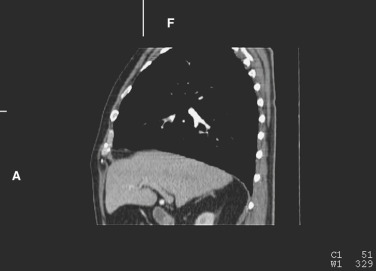
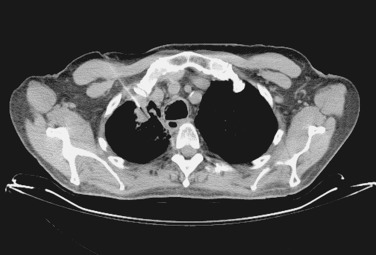
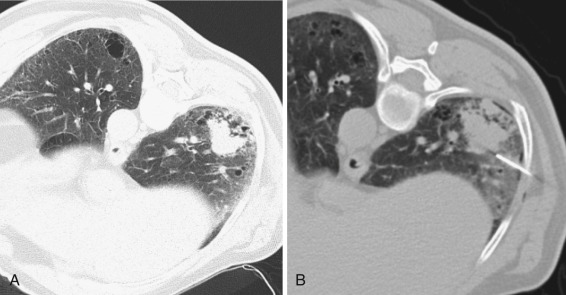
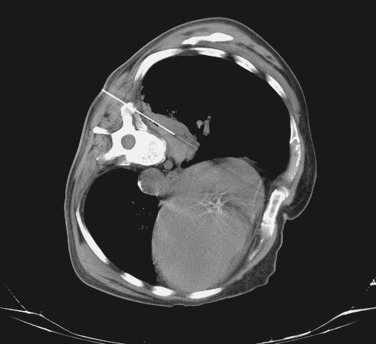
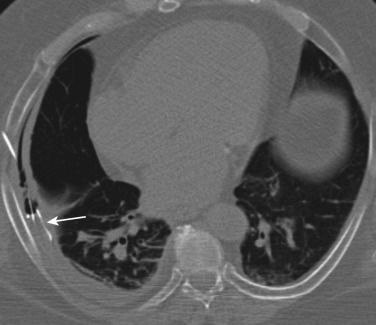
Avoidance of complications is improved because visualization of anatomy is excellent, and one can exploit anatomic detail to avoid problems in patients with parenchymal disease or vascular anomalies or blebs. In such cases, if one takes thin scan sections, one can sometimes find a pleural attachment that permits a “risk-free” access, avoiding penetration of the lung ( Fig. 67-58 ). In patients with an unknown or unexpected vascular anomaly, bolus dynamic CT scan is an important adjunct for the mediastinum and hila because major vessels can be opacified and delineated, making separation from masses in these areas easy.
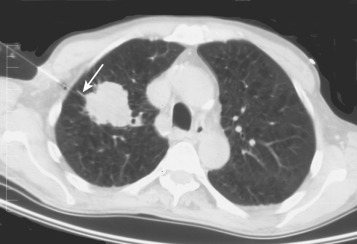
PET scanning has become a valuable tool for the diagnosis and characterization of lung masses and is commonly a prime indicator for biopsy. Cancer is hypermetabolic and consumes larger amounts of radioactive glucose than benign or noncancerous masses ( Fig. 67-59 ). In most cases, PET is unparalleled for characterizing the cancerous nature of pulmonary nodules. Its use has revolutionized the practice of medicine relative to pulmonary nodules.
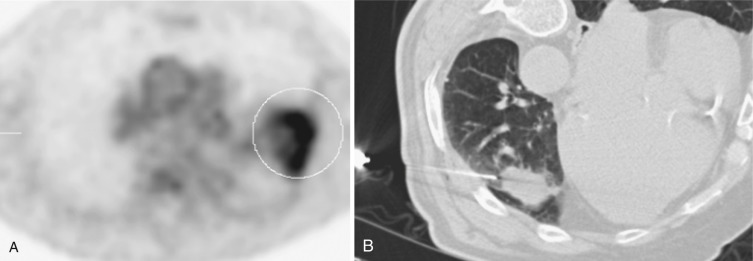
Occasionally an inflammatory site or nodules in the lung may be problematic because of associated inflammation. Although delayed scans have been used in the PET protocol to reduce the uptake and differentiate cancer from inflammation, this has not always been effective. After encountering numerous cases intended for percutaneous biopsy, we used a new technique to reduce the inflammatory reaction to eliminate the question of tumor in such cases. In nine patients referred for biopsy, we used a new technique that is not yet FDA approved. For problematic cases, this new technique can reduce the inflammatory vascularity and FDG uptake in inflammatory foci sufficiently to eliminate some false-positive findings for inflammatory pulmonary nodules ( Fig. 67-60 ).
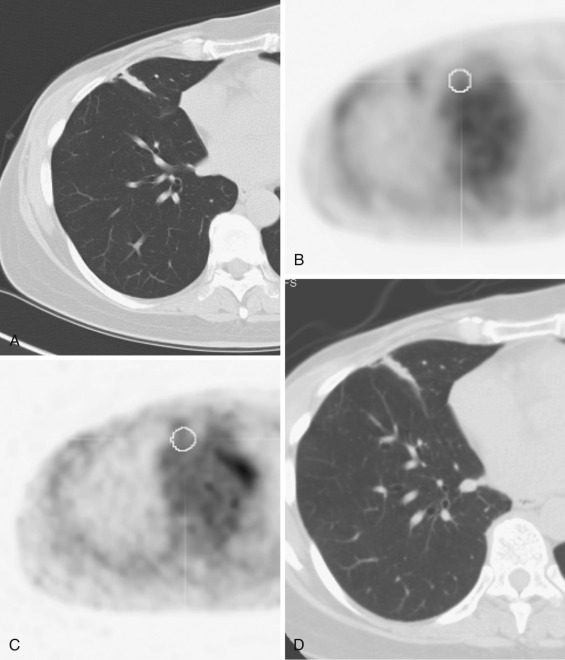
Refinement of techniques has reduced the number and significance of contraindications to image-guided biopsy of the lungs and mediastinum. Standard contraindications include very severe lung disease, congestive heart failure, severe anemia, general debilitation, or a very uncooperative patient. A patient with severe lung disease may have such pulmonary compromise from decreased compliance and air exchange that chest tube placement would not successfully re-expand the lung, making resuscitation impossible.
Patients with severe congestive heart failure are excluded for two reasons. First, having their cardiopulmonary status compromised by output failure, these patients are unlikely to be able to tolerate a significant pneumothorax. Second, because of the increased pulmonary vascularity owing to poor output function, the vessels are larger and more edematous, making severe hemoptysis more likely.
Severe anemia reduces the oxygen carrying capacity of the blood so that a pneumothorax can induce severe anoxia. Such anoxia could lead to serious metabolic issues, making resuscitation difficult.
Very uncooperative patients cannot follow instructions during such a procedure, such as staying immobile and holding their breath. Inability to comply with such instructions can increase the chance of a severe pneumothorax or hemoptysis, making resuscitation very difficult.
Absolute contraindications include uncorrectable coagulopathy, severe pulmonary hypertension, uncontrollable coughing, possible Echinococcus infection, and an uncooperative patient insufficiently controlled by anesthetics.
The levels of the coagulopathy that we find acceptable are more restrictive than for other organ sites. We insist on an INR of 1.0 and a platelet count of at least 50,000/µL. Unlike in other solid organs that are not air filled and can provide local tissue tamponade, normal values are important because the air-filled lung does not provide local tamponade for bleeding. This situation can result in serious bleeding and even intrabronchial bleeding and death. Uncontrollable coughing and a patient with an uncooperative nature are important because movement of the lung during a procedure may cause a tear of the lung by the needle, which might cause air embolism, pneumothorax, or bleeding (see “ Complications ,” later).
Review of patient history and diagnostic scans are performed, and informed consent is obtained as noted in the earlier general section. Review of patient history must include smoking, chronic lung disease, and oxygen therapy because it has been clearly shown that these are associated with increased pneumothorax rate. Any history of recent infection may suggest the possibility that the mass could be a focal inflammation. It is important to know whether the patient has been on intermittent oxygen, which gives an indication of how difficult it may be to resuscitate the patient if a pneumothorax or bleeding occurs.
Medication history is important to screen patients with coagulopathy-causing drugs. Patients frequently may self-medicate with aspirin or other analgesics, which might affect blood clotting. If such medication has been taken, it is best to defer the procedure because the lung has a greater propensity to bleed than other organs.
Review of prior scans helps preplan the procedure relative to possible approaches and patient positions; it saves time to pre-position the patient if a position other than supine is to be used. Any enhanced CT scan may show vascularity and other anatomic features. PET scan can show the metabolically active areas or necrotic areas for target planning (see Fig. 67-59 ). Laboratory values for blood count and coagulation factors should be suitable.
A diagnostic series of scans is taken in anticipation of the procedure. From the current scans, the mass referred for biopsy is reevaluated. If the lesion is stable or larger, the procedure should proceed. If the lesion is significantly smaller, one should consider deferring the procedure until a later date after follow-up scans are performed.
One selects the tentative target for biopsy and the appropriate pathway for the trajectory back to the skin surface. If the mass is large, one selects a portion of the mass that is not necrotic and a portion that is definitely solid if there is associated infiltrate or collapse. When there are questions about viability of the mass, correlation with a PET scan may be helpful.
The trajectory pathway to be used (which influences the entrance point selection) should avoid bullae or blebs, bronchi, and vessels. Penetration of bullae or blebs may cause pneumothorax. Puncture of the bronchi causes coughing, which can cause pneumothorax or possible air embolism to the vessels. If possible, one should choose the shortest pathway to the lesion, realizing that the distance through aerated lung is directly related to the pneumothorax rate (see “ Lung and Mediastinum ,” later). If there is an infiltrate or pneumonia, one should plan to traverse those areas if possible because this lessens the chance of pneumothorax. If there is a fibrous attachment or pleural thickening nearby, the trajectory should traverse them; it is likely that the fibrotic tissue anchors the visceral pleura to the parietal pleura, lessening the chance of a pneumothorax.
Bolus dynamic contrast scan over the chosen target site should be performed for numerous reasons. First, if the patient has any history of bruit on auscultation of the chest or if the scan appears to show a prominent vessel adjacent to or entering the mass, a bolus scan probably should be performed ( Figs. 67-61 and 67-62 ). The other circumstance would be in instances when there is no clear history of smoking or other risk factors for a tumor. Most importantly, bolus scanning is absolutely indicated if any consideration of a cutting needle is being made. The short time required for such a study is a small price to pay for avoiding a life-threatening catastrophe.
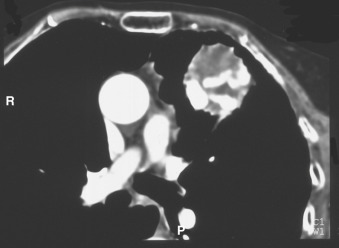
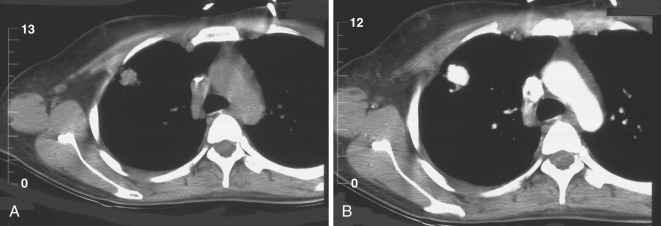
Patient position may be adjusted depending on the target site and the specific anatomy of the trajectory. In most instances, it is simplest to have the patient lie in the prone or supine position, but other positions also might be considered ( Fig. 67-63 ; see Fig. 67-35 ). In some cases, changing the patient position may “clear” the pathway for the biopsy. Specifically, the position of the scapula and the relationship of the ribs to the mass may change with an oblique position, converting an unlikely approach to a suitable one (see Fig. 67-63 ).
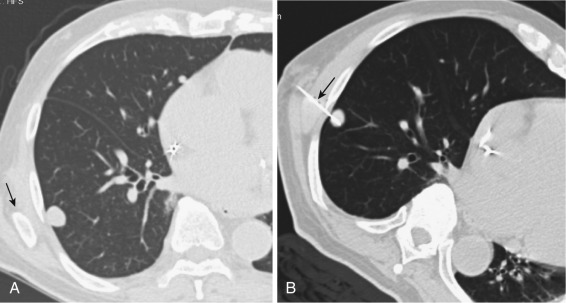
If the lesion appears mobile, which is common close to the diaphragm, the patient can be positioned with the ipsilateral side down, which may lessen motion of the diaphragm (see Fig. 67-35 ). If the lesion is small and moves with respiratory motion, it may be wise to put the patient in an ipsilateral decubitus position and insert the needle through a direct anterior or posterior approach. This position minimizes the motion of the ipsilateral diaphragm because of the weight of the abdominal organs against the diaphragm. This restriction of motion minimizes movement of the lesion and simplifies the performance of the procedure. Kinoshita and colleagues and Rozenblit and associates reported that if a biopsy can be done with the ipsilateral side dependent, the pneumothorax rate is reduced.
During the procedure, vital signs, neurologic status, and pulse oximetry should be monitored. Analgesics and sedatives can be administered as needed (see earlier under “ Patient Cooperation and Sedation ”).
Our needles of choice for lung and mediastinal biopsies, considering the diagnostic outcome and complication rates as noted in those sections, are (1) the 20-gauge FNA needle (spinal needle with 30-degree bevel is equivalent) for aspiration biopsy, (2) 20-gauge cutting needle for suitable parenchymal or pleural masses, and (3) 18-gauge or larger cutting needles for larger pleural-based masses. A single-needle method or a coaxial method can be used for a needle aspiration of the lung. With the single needle, the needle is started into the superficial tissues and a scan is obtained to verify its angulation. When the correct angle is determined, the needle is inserted to the correct depth. The coaxial method should be used for deep or small lesions. The guidance cannula is inserted into the chest wall and directed immediately adjacent to the lesion. The needle is inserted through the cannula into the mass.
When a mass is accessible and in the appropriate location, a cutting needle may be used judiciously. The most critical factor with any cutting needle procedure is that a bolus injection be performed before the procedure. Although infrequent, vascular lesions, such as AVMs or vascular sarcomas, may occur, and catastrophe can be avoided by aborting the procedure (see Figs. 67-61 and 67-62 ).
If a lesion within the parenchyma is accessible and of sufficient size, a 20-gauge cutting needle may be considered because the risk is no different than an aspiration needle (see Fig. 67-35 ). The size and location of the mass must be adequate to permit complete placement of the cutting area within the lesion ( Fig. 67-64 ). In such cases, the intervening lung has no additional trauma than an aspiration needle because there is no caliber difference or exposure of the traumatic tip to the lung.
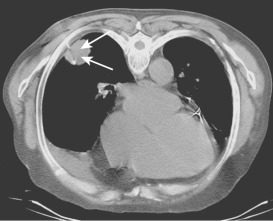
One must be prepared to compensate for deflection and bending of the needle when the stylet is inserted. Benign lesions tend to be very hard, and the surrounding lung does not provide much resistance. Such lesions may bend the stylet or deflect it to the side ( Fig. 67-65 ).

When the tentative trajectory and entrance site are chosen, a marker is placed on the skin and a repeat scan is performed to see the marker relative to the pathway. The marker may be a purchased device or a hypodermic needle in the package.
After one has selected a tentative entrance point and before the needle insertion, one should inspect the chest carefully at the entrance site for several problems. First, if there are any obvious superficial veins noted, the site should be moved accordingly. Second, one should palpate deeply for the intercostal space between the margins of the ribs. The interspace between the ribs is greater the more anterior the location and less posteriorly (see Fig. 67-53 ). The ribs become smaller as they approach the apex, making posterior approaches the most difficult in that area because of the narrow spaces and angle. Palpation of the ribs is necessary because the location of the intercostal space as seen on the CT scan is unreliable. The tapered margin of the rib and the oblique orientation of the rib as it traverses the imaging section produce considerable partial volume effect and discrepancy regarding the actual location of the intercostal space on the scan.
The problem of identifying the location of the ribs is especially relevant to the anterior chest wall where the ribs are mostly cartilaginous and fuse together in an unpredictable pattern. Although one can use a needle or a guidance cannula to “drill” through a cartilaginous rib or sternum, we do not recommend this with CT guidance because if one drills through the cartilage, the pathway of the needle is fixed, preventing corrective angulation. Also, the fixed needle cannot move with respiration, making a small tear more likely if the patient moves the lung while breathing. In the lung, as in other areas, the needle should be permitted to “swing” freely with respiration. Any time the needle is adjusted, the patient should be asked to suspend respiration temporarily during the manipulation of the needle or removal of the stylet to prevent tearing of the parenchyma or a pneumothorax.
Another structure that should be carefully noted is the scapula. When approaching a lesion from the posterior chest wall, at any location, one should carefully palpate for the scapula. Although on first consideration one might think that the scapula would not typically interfere with a procedure, the tip of the scapula is tapered in two directions such that the location of the tip of the scapula is “averaged out,” so that what is seen on the scan does not correspond to the palpable tip on the patient. In some cases, the needle is deflected without the operator's being aware of the problem. Also, in some cases, the patient moves the scapula slightly into the path of the needle and deflects it sufficiently to preclude a successful needle placement.
Careful antiseptic preparation of the skin is important. Proper administration of lidocaine to produce a “painless” procedure, as noted earlier, is important. When the area is anesthetized, it is important to infiltrate anesthetic through the subcutaneous tissues and down to and including the pleura. Adequate anesthesia of the pleura makes the procedure virtually pain free and permits insertion of the needle without the patient's moving because of pain. So important is this step of anesthetizing the pleura that as we perform the actual insertion of the needle, we stop the needle tip at the pleura to inject a small amount of anesthetic at the pleura and to check the final angle of needle insertion before entering the lung (see Fig. 67-35 ). If a rib is inadvertently hit during the initial anesthetic administration, we give a small bolus of lidocaine on the rib; this prevents any recurrence of pain if that area is struck again during the procedure.
The appropriate needle, either FNA or cutting needle, is selected using the factors discussed previously. The needle is inserted with incremental steps and adjusted until it is in place in the target site. The patient is asked to hold the breath during each movement of the needle.
With the aspiration needle, localization of the tip precisely in the chosen site is important if adequate cellular material is to be obtained (see Fig. 67-35 ). If a cutting needle is being used, one must be confident that the cutting gap of the needle would fit entirely within the mass and adjacent normal lung would not be traumatized (see Fig. 67-63 ). If this is not the case, a severe hemorrhage or pneumothorax or both may occur (see Fig. 67-39 ). During needle insertion and sample acquisition, whenever the needle is moved the patient should be asked to suspend respiration. Not doing so may cause shearing of the pleura and cause a complication.
The sample should be acquired as noted previously in the general section on technique. When the stylet of the needle is being removed to permit attachment of the syringe, patients should be asked to hold their breath so that they do not inhale and pull atmospheric air into the chest.
We routinely take only a single needle pass unless there has been an error in technique or a poor sample obtained on visual inspection. We prefer to defer a second needle pass until after the results of the first pass are known unless there has been a break in the technique. If a technical error has been made or the final position of the needle placement is unsatisfactory, a second needle pass can be made at once. If the cytologist is available for a rapid stain interpretation, the patient remains in the department until the results are known. If this service is unavailable, I still prefer to wait for the results instead of taking a second pass, because the 24-hour delay is a small tradeoff considering the high success rate.
Postprocedure care is simple and consists of observing patients for severe hemoptysis and pneumothorax. Immediately after completion of the procedure, I prefer to have the patient lie still for 5 to 10 minutes to let the puncture site seal. Moore and coworkers have shown that the incidence of pneumothorax is reduced if the patient is positioned with the puncture site down after the procedure. The pneumothorax rate for patients placed in this position was 17.9%, whereas the rate was 33.6% for patients not so positioned. Chest tube placement rate was 9.8% for patients who were positioned with the procedure side down compared with 0.4% for patients who were not.
Before removing the patient from the table, we take a repeat scan to evaluate for postprocedure problems. Although Miller and associates reported that CT and plain radiography were equivalent for pneumothorax detection, Bungay and colleagues reported that CT is more sensitive for detection of pneumothorax (radiography detected only 22 of the 35 pneumothoraces detected by CT). A small pneumothorax is of little significance, as noted later. Some bleeding in the parenchyma in the area of the needle track occurs frequently, but it is of no significance. If there is any question of the patient's stability, oxygen should be administered, and appropriate treatment should be given.
Postprocedure chest films should be taken 1 hour, 4 hours, and 8 hours after the procedure. It makes no sense to use valuable CT time for follow-up of pneumothorax; chest tube insertion is required only with larger pneumothoraces when patients are symptomatic. Perlmutt and coworkers showed that pneumothoraces could be detected in the following percentages at the noted timed delays: 89% immediately after procedure, 9% after 1 hour, and only 2% after 4 hours.
The success rate of lung biopsies has varied widely among the many reports of fluoroscopic and CT-guided procedures and with the use of aspiration and cutting needles. Before cutting needle usage, favorable results were reported for aspiration cytologic results. With increased use of cutting needles, the literature shows improved recovery of diagnostic tissues for all malignant and benign lesions.
Success rates of aspiration biopsy have ranged from 60% to 95%. Several reports by Sinner, Thornbury and colleagues, and Greene and colleagues have documented that the results of aspiration biopsies correlate well with histologic results. Greene and colleagues found the correlation to be 92.3% for adenocarcinomas, 100% for squamous cell carcinomas, 88.9% for large cell undifferentiated carcinomas, and 100% for small cell undifferentiated carcinomas. Taft and coworkers found an interobserver error to be only 6%, with 94% overall consistency. These results are exclusive of lymphoma and mesothelioma cases, which are difficult to diagnose with aspiration biopsies. Weisbrod and associates noted that in about 67% of lung cases the diagnosis of lymphoma can be suggested, but not the definitive subtype.
Goralnik and coworkers, who reported the first cutting needle biopsy in the thorax, found that the specific subtype could be diagnosed using a large cutting needle for suspected lymphoma lesions. Initial reports by numerous authors, including Kushihashi and colleagues, Laurent and colleagues, Rotte, Greif and colleagues, and Klein and Stewart, have verified the usefulness of the cutting needles but confirm the role of aspiration needles for diagnosis of malignant tissues. Klein and Stewart found little difference in the diagnosis of malignant lesions but great superiority for benign disorders. The correct diagnosis of benign lesions was 44% with aspiration needles and 100% with cutting needles. With peripheral lung nodules, Greif and colleagues reported an accuracy of 81% for benign lesions compared with 16% for aspiration needles.
More recent articles have confirmed the superior results obtained with cutting needles for unusual tumors and benign abnormalities. Bungay and associates reported 86% success rate for diagnosis of lymphoma and noncarcinomatous tumors. Lopez and coworkers reported 93% diagnosis in benign lesions. Carruthers and associates reported the usefulness of cutting needles for diagnosing Wegener's granulomatosis. Greif and colleagues reported that in the mediastinum, cutting needles could diagnose lymphoma, thymoma, and bronchogenic carcinoma accurately. Zinzani and colleagues reported on a series of 83 patients, in which the accurate diagnosis of lymphoma was achieved in 81%. Savage and coworkers reported on a total series of 836 cases; of the 95 benign diagnoses by needle biopsy, a “specific benign” diagnosis was a true negative for malignancy. Savage and coworkers reported on a series of cutting needle biopsy of benign masses; they noted that when a specific diagnosis is made, the diagnosis can be considered definitive.
Even the problematic diagnosis of mesothelioma can be made. Scott and colleagues reported diagnosing 13 of 14 cases of mesothelioma. The tumor is problematic because even with a large tissue sample, it is not always possible to distinguish a benign tumor from a malignant one. Based on our experience with about eight such cases, the diagnosis of mesothelioma can be made, but the differentiation of benign versus malignant can be determined only from its biological activity.
Precise localization of the needle into the viable portion of the tumor is important. One should avoid areas of necrosis or infiltrate. If the nodule being sampled contains a small amount of calcification, the calcified area should be avoided and the adjacent soft tissue density should be targeted. If the nodule is cavitated, appears necrotic, or is large, the central portion should be avoided in preference to the peripheral area ( Fig. 67-66 ; see Fig. 67-59 ).
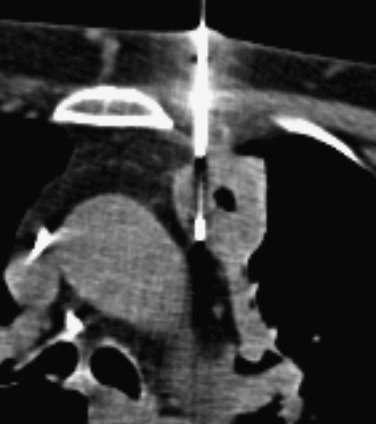
The importance of accurate localization is emphasized by the numerous reports that note that the diagnostic yield is lower and the complication rate higher with smaller lesions. The size and location of a mass affect the probability of a positive diagnostic aspiration. Bergquist and coworkers noted that the diagnostic accuracy was higher for larger lesions and for more peripheral lesions. A 1-cm nodule was successfully biopsied in 58% of cases when it was central; it was successfully biopsied in 85% of cases when it was peripheral. More recently, Li and colleagues and Miller and associates have confirmed the improved diagnostic recovery from large lesions compared with smaller ones. Localization in such lesions is more difficult, usually requiring several repositioning attempts in the parenchyma.
If using an aspiration needle, multiple needle passes increase diagnostic yield but at a cost of increasing pneumothorax rate. Early reports by Sargent and colleagues and Stevens and Jackman described the effects of increasing the number of needle passes. Stevens and Jackman reported that a second needle pass increased diagnostic yield by 10%, and a third needle pass increased yield by 1.5%. Sargent and colleagues reported that a second needle pass increased the diagnostic yield by an additional 5%, and that the third needle pass increased the diagnostic yield by another 3%. Multiple passes increase the pneumothorax rate, however.
Appropriate use of the cutting needle can improve diagnostic yield in specific cases. As noted in the discussion of the cutting needle technique, the needle caliber should be 20 gauge if the mass is not pleural based, and the cutting action of the needle should be confined to the mass, without extension into the adjacent lung parenchyma. Use of the cutting needle is justified if there has been a failed aspiration procedure or suspicion of lymphoma, mesothelioma, or thymoma.
The main complications reported for lung biopsies are pneumothorax, hemoptysis, air embolism, and intrabronchial bleeding. Pneumothorax and hemoptysis are the most common complications. The incidence of pneumothorax varies widely among the numerous clinical reports. The asymptomatic rate ranges from 17.5% to 72%. The symptomatic rate requiring chest tube is 6% to 18%. The hemoptysis rate varies for different needle sizes from 5% to 21%. The treatments for these complications are discussed at the end of this section.
Effective administration of local anesthesia through the trajectory site to the pleura helps reduce pneumothoraces. If the patient does not have the pleura adequately anesthetized, even the most cooperative patient may jerk at the instant a needle traverses the pleura, potentially tearing a small hole and producing an air leak.
Theoretically, placing a postbiopsy patient with the ipsilateral side dependent minimizes the incidence of a pneumothorax. This theory is controversial and not yet confirmed because there are conflicting reports on the topic. In a series of 262 patients, Moore and colleagues reported that the pneumothorax rate was reduced in a statistically significant manner. Collings and associates reported in a series of 423 patients that no benefit occurred.
Although early authors attributed the high pneumothorax rate to the prolonged length of the procedure, a more recent report by Ko and coworkers refutes this claim. These authors found no difference between patients with procedures with different times. Two major determinants of pneumothorax rate are the status of the lung and the number of needle passes. If a patient's lung has severe chronic obstructive pulmonary disease (COPD), more blebs are present. Decreased lung compliance in patients with interstitial disease favors collapse of the lung when a small air leak occurs.
In prior editions, we noted from our experience numerous parameters important for pathway selection, which have since been validated by reports in the literature. One can minimize the possibility of a complication by looking carefully for a safe pathway through the lung to the nodule being biopsied. In such cases, one might locate the attachment to the pleura of an area of fibrosis or thickened pleura that can be traversed by the needle. By planning the trajectory through such an area, only a minimal amount of parenchyma is traversed or the fibrosis can serve to keep the layers of the pleura attached and avoid a pneumothorax ( Fig. 67-67 ). Ko and coworkers reported that pleural thickening associated with prior surgery decreased the pneumothorax rate ( P < .05). By looking for a small amount of “fat” that may be tented at the pleura, one usually can distinguish between a mass that is simply adjacent to the pleura and one that has a fibrous extension. This type of approach is especially important in high-risk patients with pulmonary hypertension, severe restrictive disease, or other serious underlying pulmonary problems.
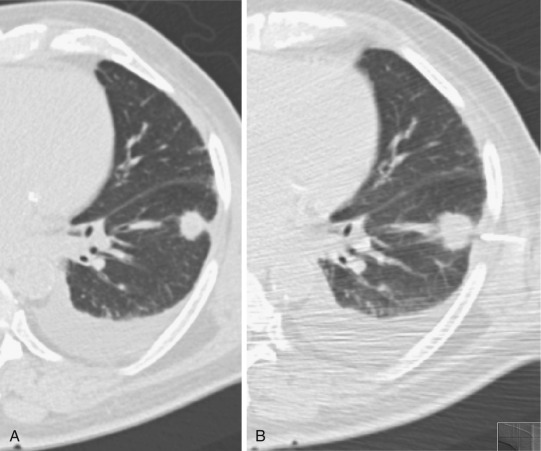
Minimizing the pathway of lung crossed ( Fig. 67-68 ) and using a pathway through nonaerated lung can minimize the incidence of pneumothorax. The significance of minimizing the needle pathway length was first evaluated by one of our colleagues, Locke (Locke J, Haaga JR: Personal communication, unpublished data), who studied a series of 235 cases from our center and looked at the incidence of pneumothorax compared with the distance of the lung traversed. The distances crossed and the corresponding incidence of symptomatic pneumothorax were 1 cm, 3.7%; 1 to 2 cm, 10.7%; 3 to 4 cm, 19%; and 5 to 6 cm, 44.4%. Because these measurements were taken from CT scans, they were accurate without errors in magnification; other authors who have not supported this relationship made their measurements from radiographs, which are more subject to error. In recent years, other authors have confirmed that lesion depth was the prime determinant of pneumothorax for CT procedures.
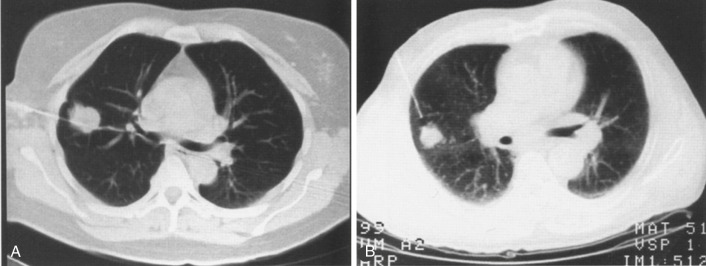
That traversing nonaerated lung, as we initially published in prior editions, does diminish pneumothorax has been documented. Haramati and Austin showed convincingly that if aerated lung was avoided, the pneumothorax rate decreased significantly. These investigators found that the pneumothorax incidence through aerated lung was 46% compared with 0% through nonaerated lung. Cox and associates reported 15% pneumothorax for nonaerated lung and 50% for aerated lung. Stated differently, if there is an area of infiltrate adjacent to a nodule, one should intentionally traverse the consolidated area ( Fig. 67-69 ).
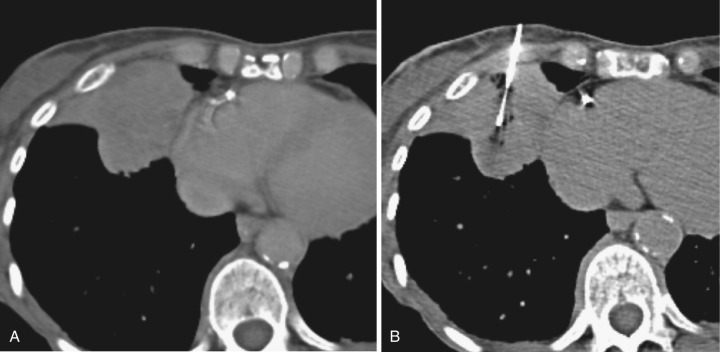
Status of the lung was evaluated by Fish and colleagues and Miller and associates. Topal and Ediz and Cox and colleagues showed a definite relationship of pneumothorax to lung disease. Fish and colleagues evaluated chest films and spirometry to determine the presence of COPD, and they found that patients without COPD had a pneumothorax rate lower than patients with COPD. With spirometry measurements, the ratio for pneumothorax was 45% for COPD patients compared with 25% for patients without COPD. Using the chest x-ray as the standard, the rate was 42% for COPD patients compared with 25% for patients without COPD (see earlier under “ Pneumothoraces—Factors Affecting Incidence ”). Cox and colleagues reported that patients with emphysema were three times more likely to have a pneumothorax. Avoiding cystic abnormalities reduces the chance of a pneumothorax (see Fig. 67-55B ).
Several authors have reported a blood patch technique to prevent pneumothorax. With this method, a coaxial needle method is used, and a blood clot is injected through the long cannula during its removal from the lung. The results of this method vary; Bourgouin and associates reported no difference in outcome when it was evaluated in a randomized prospective fashion. Lang and coworkers studied a group using a blood patch method; in patients with emphysema, pneumothorax occurred in 3 of the 20 patients (15%) who received autologous blood clot and 10 of the 14 (71%) patients who did not ( P < .001). In our opinion, the difference in results is probably based on the exact method of instilling the blood clot. If clot is simply deposited at the pleural margin, it is unlikely to seal the leak of air. If blood is injected throughout the pathway of the needle within the lung and the pleural margin, a seal is more likely to succeed.
Hemoptysis is expectoration of blood after biopsy; it does not refer to the imaging appearance of a small amount of bleeding, Commonly, minimal localized hemorrhage in the parenchyma may occur after a biopsy, but it is of no significance ( Fig. 67-70 ). The factors affecting hemoptysis are the needle caliber, depth of lesions, coagulation status, presence of congestive failure, and an improper trajectory that passes through a moderate-sized pulmonary vessel. Excessive damage to the lung parenchyma with a cutting needle also can occur if the needle is not positioned properly (see Fig. 67-39 ). These circumstances should be avoided if possible. Although this is an unsettling event for the patient and the physician, hemoptysis was common in the early days of fluoroscopic biopsy. Needle caliber directly affects hemoptysis; this was confirmed by Khouri and coworkers, who noted in their series that the hemoptysis rate was 21% with an 18-gauge needle but only 5% with a 20-gauge needle.
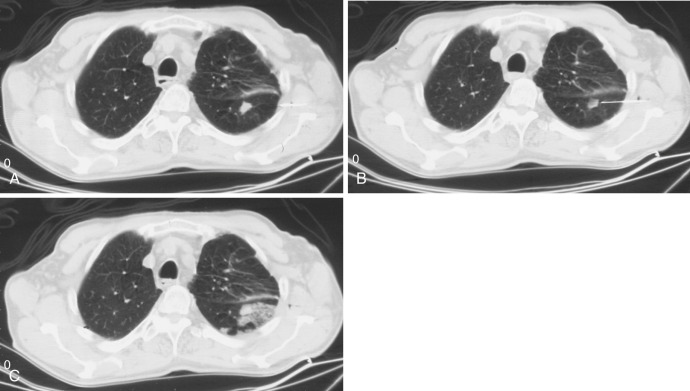
Deep lesions and hilar lesions are at greatest risk because of the long pathway and proximity of blood vessels. Yeow and colleagues reported depth and size of lesion as the most important factors for hemoptysis. The cases reported in the literature were associated with ill-defined masses adjacent to the hila. Also, one must remember the importance of bolus studies in selected patients (see Figs. 67-61 and 67-62 ). Vascular lesions, aneurysms, and AVMs are very vascular and may bleed. Bolus dynamic scan is crucial to avoid biopsy of such lesions.
Patients with coagulopathies, pulmonary hypertension, or congestive heart failure are at greatest risk for hemoptysis and intrabronchial bleeding (as noted later under “Intrabronchial Bleeding”) and should not undergo biopsy without correction of the basic problem. Biopsy in a patient with congestive heart failure should be avoided because the pulmonary vessels have elevated pressure, are edematous, and are more fragile, being predisposed to tearing.
Anticoagulated patients should never undergo biopsy, even if the anticoagulation consists only of aspirin. The lung parenchyma has a very low tissue pressure because of the alveoli, and there is no compressive effect to help retard bleeding.
We have located nine reported deaths in the literature from percutaneous lung biopsy, five from endobronchial bleeding and four from air embolism. Having read those reports, some valid observations can be made.
Air embolism is caused by introduction of air into the arterial system that results in occlusion of the blood supply to organs. Although most of the cases occurred with percutaneous biopsy, a case of fatal air embolism has been reported with bronchoscopic biopsy. In the early reported cases of air embolism to the head the patients died, but there have been three reported cases of patients who have survived, two with hyperbaric oxygen therapy and one spontaneously ; very few centers have hyperbaric facilities.
After reading the original reports on these cases and other research papers on the pressures in the tracheobronchial system, one can hypothesize the cause of air embolism and steps to use to avoid such catastrophes. In all of the cases, the clinical discussion is very similar. The authors related that unexpectedly the involved patients began an uncontrollable coughing episode, which could not be ameliorated by consoling the patient and supportive action. In each case, the needle was left in place during the episode. Each case notes that the patient stopped coughing suddenly and became unresponsive and died immediately. One more recent case was associated with positive-pressure ventilation.
Several authors hypothesized that air embolism is a result of the elevated intrabronchial pressure that occurs with coughing; the high-pressure air follows along the needle track into the blood vessels. The literature notes that during a cough when the epiglottis closes, the pressure can reach more than 100 pounds of pressure. We theorize that with the needle in place, the high-pressure air passes along the shaft of the needle into the pulmonary veins and subsequently into the arterial system.
We believe the way to prevent any such event is to withdraw the needle immediately whenever a patient starts coughing during a needle biopsy. If one is careful to avoid visible bronchi during the trajectory planning, coughing is a rare event, and this policy does not defer many patients. Patients with a propensity to cough should be treated with codeine before attempting a biopsy, but if coughing ensues the procedure should be canceled.
Intrabronchial bleeding is a very rare complication, reported only several times in the literature with percutaneous and transbronchial biopsy, with numerous deaths. Most instances of intrabronchial bleeding have occurred with cutting needles before guided methods, but anecdotal cases with guided aspiration and cutting biopsies have occurred. If one reads the original reports, the patients have the same general story. The patient experiences hemoptysis, and this continues until large amounts of blood are coughed up and the patient quickly dies. We have not seen such a case, but from the reports and images provided, it seems likely that the patients had ongoing congestive heart failure. We hypothesize that because the pulmonary vessels were edematous and friable, a tear occurred in a pulmonary vessel and the patients bled into the bronchial tree.
Hilar lesions are best sampled by bronchoscopy, and percutaneous biopsy should be employed only as a second choice. With percutaneous procedures, the length of the lung to be crossed and the proximity of vessels make the incidence of pneumothorax and hemoptysis more likely. The success rate for bronchoscopy is better and the complication rate lower than for percutaneous procedures. If a bronchoscopy has been attempted unsuccessfully, a percutaneous procedure is performed with the following guidelines.
Before the procedure, intense contrast enhancement of the vasculature should be performed to highlight the location of the anterior, lateral, or posterior approach to be taken. With such lesions, a coaxial short cannula method should be used. This method is especially helpful because, as noted earlier, before the biopsy needle is inserted, the guidance cannula predetermines the angle. With a long distance from the pleura to the hilum, a few degrees in error would result in a large localization error centrally.
Careful planning for apical lesions is important because of the unique anatomy of the upper chest. Anteriorly the brachiocephalic vessels, mediastinal vessels, clavicle, and axillary vessels make the approach more difficult. Posteriorly the scapula covers a substantial portion of the posterior chest. Avoidance is best accomplished by having the patient fully abduct the shoulder so the scapula moves laterally. Careful palpation usually reveals the margin of the scapula. Another anatomic factor making the approach more difficult is that the ribs become smaller as one progresses from the midchest cephalad to the apex. It is usually easier to plan the entrance site so that the angle also is slightly caudal, which makes penetration of the intercostal space easier (see Figs. 67-35, 67-53, and 67-54 ).
Several final points should be made about unusual masses in the apex. Neurogenic tumors and lateral meningocele may occur in the posterior mediastinum adjacent to the neural foramina ( Fig. 67-71 ). Neurogenic tumors are hard and painful in biopsy ; a diagnostic sample seldom can be obtained. Puncture of a lateral meningocele yields clear fluid consistent with spinal fluid.
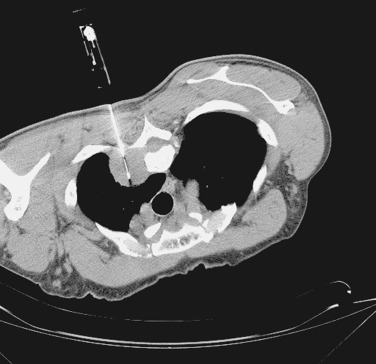
Pleural lesion biopsies are difficult to perform fluoroscopically because as the lesion is turned perpendicularly to the fluoroscope, it becomes en face and more difficult to see. With CT, sampling of such lesions is easy and provides considerable flexibility for needle selection. An aspiration needle can be used at any time; in cases in which it is indicated, a cutting needle can be used for a more adequate tissue sample. Goralnik and colleagues reported that these cutting needles could be used safely for pleural lesions. These investigators recommended their use when either lymphomas or unusual tumors such as mesotheliomas were suspected. An automated biopsy device also can be used if the lesion is large enough to accommodate the length of the needle action. Scott and coworkers noted that “by combining findings at biopsy and at CT (presence or absence of pleural thickness >1 cm, mediastinal-circumferential involvement, irregular contour), sensitivity and negative predictive values reached 100% and 1.0.” Maskell and associates reported that guided biopsy of the pleura is superior to unguided pleural biopsy. Adams and Gleeson reported on pleural biopsy of patients with suspected malignant effusions. In their series, accuracy was 91% overall and 93% for mesothelioma.
Several authors have reported on the use of long versus short pathways for biopsy of small subpleural nodules. For small subpleural nodules about 1 cm, Gupta and colleagues compared the usefulness of using a direct short pathway with a long pathway (entrance site and trajectory slightly away from the nodule). They reported better accuracy for a diagnostic result but a higher incidence of pneumothorax for the long pathway ( Fig. 67-72 ). The diagnostic yield in the short pathway group was 71% compared with 91% for the long pathway. Although the frequency of all pneumothoraces for both groups was the same, the chest tube rate was higher for the long pathway (38% vs. 17%). Ko and coworkers reported that a shallow angle of insertion was more likely to produce a pneumothorax.
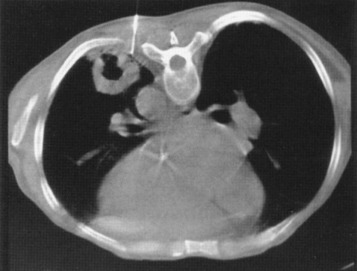
Cavitated nodules are slightly problematic because two major issues arise. To obtain viable diagnostic tissue, one must sample the wall carefully (see Fig. 67-72 ). If the needle enters the cavity, a pneumothorax is likely and there may be spillage of material into the pleural space; spillage of neoplastic or infectious material into the space should be avoided.
Before the use of CT, only a few authors ventured to perform biopsy of the mediastinum using fluoroscopic guidance. With the refinement of CT techniques, however, CT is now the modality of choice and is commonly used for this area.
Several limited studies by Lauby and colleagues, Jereb and Us-Krasovec, and Rosenberger and Adler showed the feasibility of mediastinal biopsies with fine needles guided by fluoroscopy. Weisbrod and colleagues and Westcott confirmed the benefits of fluoroscopic procedures but also noted some of the disadvantages and potential hazards. The most extensive series, consisting of 100 patients, was reported by Westcott. Although the results showed 96% accuracy, there were 10 patients with vascular aneurysms that created some difficulty. Five of the patients were excluded from a biopsy because of a difficulty in evaluating the mediastinum. In another five cases, inadvertent puncture of aortic aneurysms occurred; in one patient, a hemomediastinum developed.
Weisbrod and colleagues also reported several important observations. In their series they noted that although aspiration needles were satisfactory for metastatic disease, the needles were suboptimal for lymphomas. They also reported one case of cardiac tamponade that was successfully treated.
The mediastinum is an exciting area for the application of procedures. Before the advent of CT, when most biopsies were performed with fluoroscopy, this area was considered off limits because there was no reliable way to image the anatomy, either diagnostically or for intervention. With the evolution of CT imaging and its corresponding procedures, radiologists and clinicians have become confident of mediastinal anatomy and pathology.
The reliability of anatomic display and refinement of the interventional techniques are such that procedures of the mediastinum are now commonplace. These procedures require considerable skill, however, and should be performed only by the most skillful radiologists who are well versed in anatomy and procedures.
As one would expect, performing procedures in the mediastinum is contingent on comprehensive and complete knowledge of the mediastinal anatomy. One must be familiar with virtually all variations so that inadvertent puncture of a vascular structure does not occur. Aberrant subclavian vessels, left-sided vena cava, and prominent azygos veins are the most likely variations to occur. Appropriate use of bolus dynamic scanning is crucial to ensure that all vascular structures are well defined. Although it is seldom that tumors are vascular and represent a bleeding risk, it is common for vascular anomalies, aneurysms, or pseudoaneurysms to exist. Any rational interventionalist would use bolus dynamic scanning in the mediastinum to visualize normal anatomy and exclude a vascular anomaly ( Fig. 67-73 ); a more complete discussion of variant anatomy is provided in Chapter 38 .
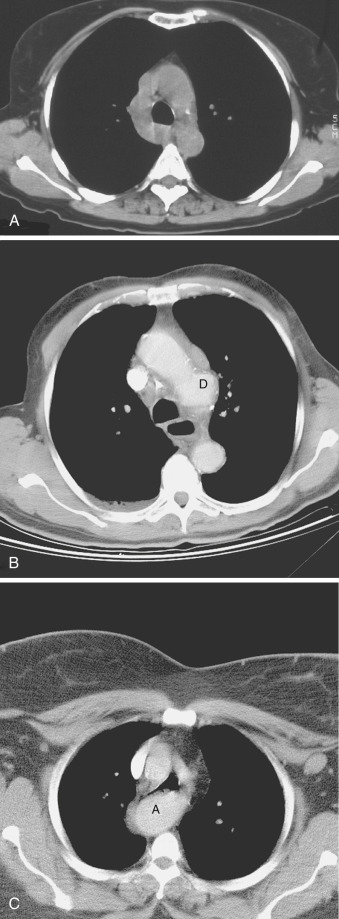
Procedures of the different portions of the mediastinum (superior, anterior, middle, or posterior) require uniquely different approaches. Successful and safe procedures in these areas require careful attention to the subtle techniques used to guide and manipulate instruments in these areas.
The superior mediastinum consists of the space above the aortic arch and contains the various brachiocephalic vessels (venous and arterial). This is the most common area for congenital variations because arteries emanating from the arch and venous variations are common.
This space requires an anterior insertion in virtually all cases and usually results in an approach through the suprasternal notch or the parasternal region ( Fig. 67-74 ). In all cases a good vascular study with bolus injection is crucial to clearly define the carotids, jugulars, and small vessels. In most cases the lower portion of the thyroid gland and the trachea must be dealt with to approach such masses. It is always crucial to clearly identify the lobes of the thyroid because it is common for substernal or low-lying thyroid to be mistaken for a mass in the upper mediastinum. If the ipsilateral lobe of the gland is not identified, one should always consider the possibility that the observed mass might be the lobe of the thyroid.
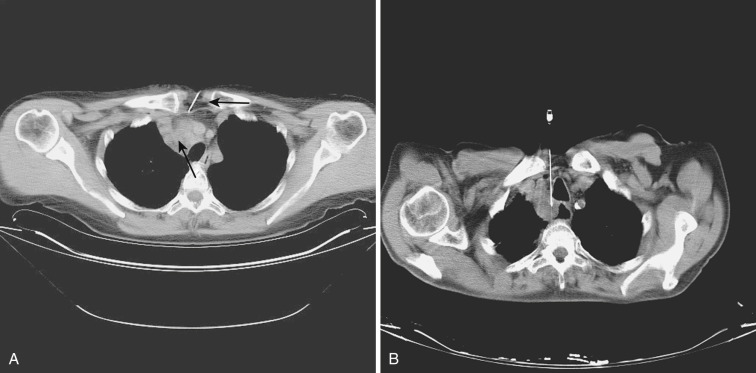
Methods for choosing the correct entrance site and pathway are essentially the same as in other areas. As the needle is inserted, the pathway and tip of the needle are monitored carefully with incremental adjustments. Use of the bevel to slide past the different structures is important to provide clearance around the vessels. As noted in the earlier technical section, the bevel is turned toward the structure to be avoided, and the point is rotated so that it is directed toward the intended target. Also as noted in earlier sections, successful maneuvering of the needle around a vessel or structure is best accomplished by pushing the instrument slowly, which facilitates the deflection of the needle.
Lesions in the anterior mediastinum are in the anterior space behind the sternum or anterior to the aortic arch. In most cases, one can access these lesions by using an insertion site just lateral to either side of the sternum. One must be cautious not to sample the internal mammary artery or vein. With these lesions, one can use either an aspiration or cutting needle as in other portions of the mediastinum. Careful localization of the needle tip or cutting needle gap is crucial in such cases ( Figs. 67-75 and 67-76 ) because cutting of the major vessels would be catastrophic. As noted in the earlier section, placing a patient in a lateral or oblique position can shift the anterior junction line to make such procedures simpler. One can inject saline into the mediastinum to increase the potential pathway for needle insertion and to avoid traversing the lung (see Fig. 67-51 ). Gupta and colleagues have proposed using a transsternal approach with a coaxial system; these authors advocate using a coaxial cannula to penetrate the sternum and use a needle through the cannula. We have not found the need for this approach and have preferred to use the methods discussed here.
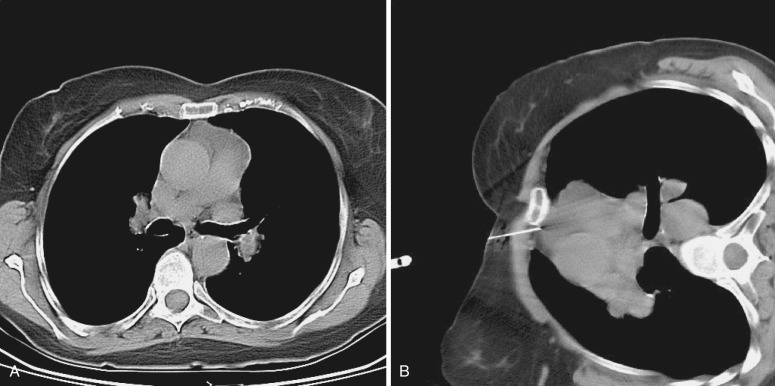
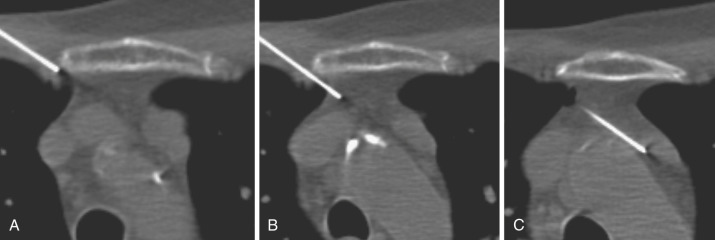
The middle mediastinum is a large space below the arch and encompasses the azygos node ( Fig. 67-77 ), peritracheal region ( Fig. 67-78 ), aorticopulmonary window ( Figs. 67-79 and 67-80 ), subcarinal region ( Fig. 67-81 ), and periesophageal region ( Fig. 67-82 ). The peritracheal regions and the aorticopulmonary windows are typically best approached anteriorly through the anterior junction line, avoiding the lung parenchyma and other structures. The internal mammary vessels should be identified before any procedure so that the entrance and pathway can be planned appropriately to avoid these structures.
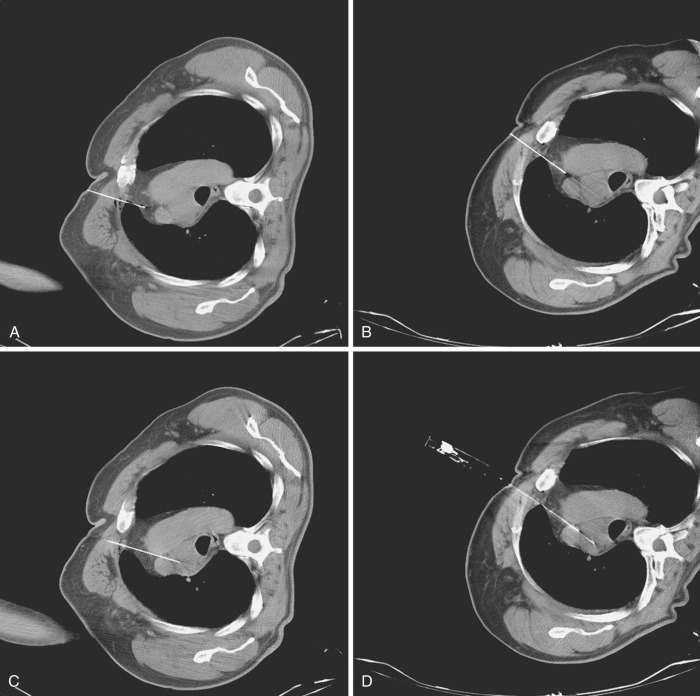

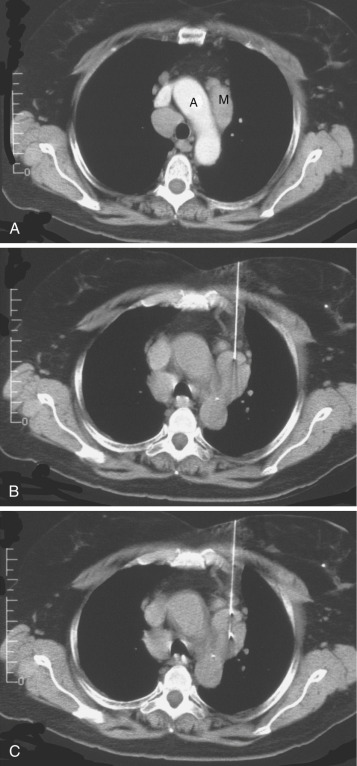
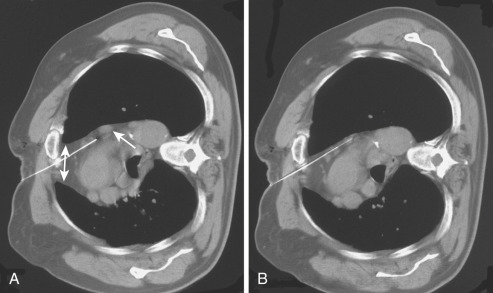
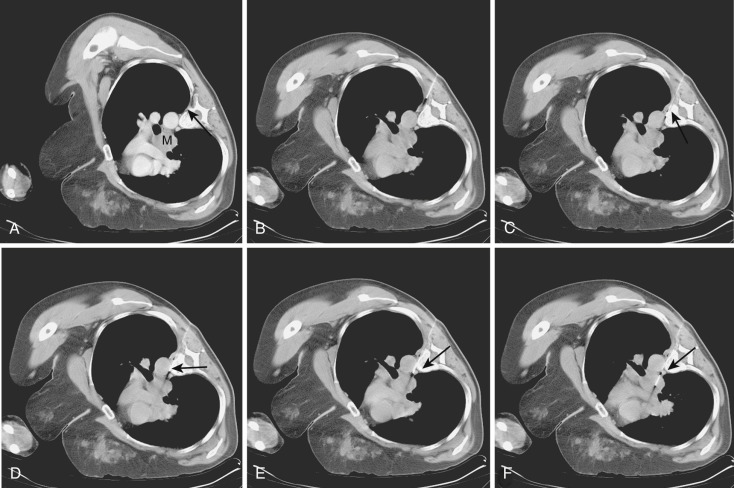
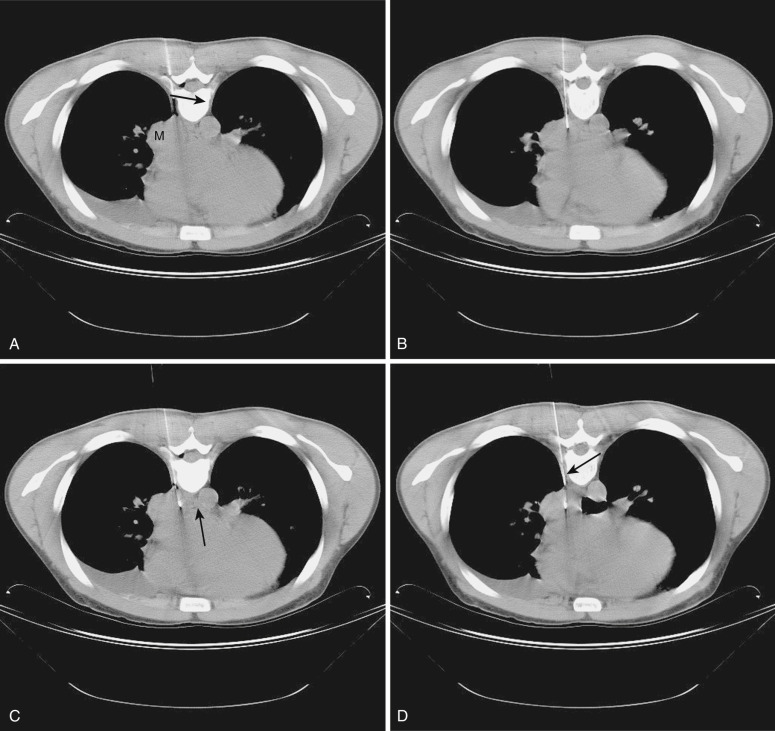
The anterior approach may be performed if the patient has a wide anterior junction region, but in many cases it is helpful to place the patient in a lateral position, either on the right or on the left side (see Fig. 67-76 ). By doing this, the anatomy may shift so that a clear pathway through the anterior fat space may be possible, preventing any possible pneumothorax that could occur if the lung were traversed (see Fig. 67-79 ). In such cases, injection of saline or gas may be helpful to enlarge slightly the potential pathway (see Fig. 67-51 ). Widening of the pathway is typically small because these materials disperse along the long axis of tissues and the cross-sectional areas, so the change in the anatomy is usually minimal. Maneuvering the instruments past corresponding vessels is a crucial part of the procedure.
Paratracheal or azygos lymph nodes can be approached by traversing the anterior mediastinum and the space between the superior vena cava and the ascending aorta. The level of the entrance is below the origins of the brachiocephalic vessels and the subclavian veins. When using this approach, it is crucial to choose the correct entrance site and trajectory to ensure uneventful passage of the needle past the vessels. Traversing the space between the vena cava and aorta is simpler if the process has slightly widened the space. In cases in which the vessels have not been separated in this fashion, successful placement can be accomplished by using a coaxial system as follows. With the newly designed devices, blunt or rounded stylets are available so that the walls can be pushed slightly and penetration can be avoided. In other cases, one might choose to use a small-caliber bevel needle to slide between the two structures, and the coaxial cannula can be advanced over the aspiration needle (see Fig. 67-77 ).
The subcarinal area is best approached through a posterior paraspinal approach from either the right or left side, depending on the location of the mass. The left approach between the aorta and the vertebral body is usually the best approach because there is more space compared with the paraspinal region on the right side (see Figs. 67-81 and 67-82 ). As one reviews the figures, the approach seems almost unbelievable, but the truth is that we have consistently performed this approach for 15 years with no complications. It would be gratifying to believe we were the only ones capable of doing this, but the facts are that the approach and methodology are valid, and most experienced and motivated interventional radiologists can learn to perform this procedure.
Choice of the correct pathway and entrance site is crucial to the success of the procedure. The most suitable trajectory from which an entrance site must be chosen is a pathway that includes the margin of the transverse process/rib junction, the margin of the vertebral body, and the mass itself. The trajectory path should not include any vessel. A small amount of lung parenchyma in the path is acceptable but not preferable. Selection of any other pathway more medial than this would be unsuccessful because the contiguous overlap of the transverse process and the rib articulation provides an almost impenetrable “shield” that is painful and traps the needle so that no angulation or adjustment is possible.
When this technique is executed, ample use of local anesthetic is important not only in the skin but also at the site of the transverse process and vertebral body. Unless adequately anesthetized, these two sites are painful because of the periosteum.
The steps of the procedure are as follows. The site is prepared and the needle is advanced just to the margin of the transverse process. At this level, local anesthesia is infiltrated on the periosteum. The needle is rotated so that the bevel is turned against the body, and the needle is pushed slowly. The tip of the needle is located close to the margin of the vertebral body, and local anesthesia is injected. The needle is adjusted if needed so that the bevel of the needle is against the edge of the vertebral body and pushed slowly several millimeters. The bevel is rotated so that it is toward the aorta and pushed forward 4 to 5 mm to pass the aorta. If the hemiazygos vein or esophagus is close, the bevel also may be adjusted to pass by those structures. When positioned in the mass, the sample is acquired as appropriate with either the aspiration or the cutting needle.
The sequence of events in this procedure typically proceeds predictably, but the procedure can be aborted any time at the judgment of the operator. As one begins to learn this technique, each succeeding attempt provides additional confidence that enhances eventual success and comfort with the procedure. One almost insurmountable difficulty is the presence of a large osteophyte that may occur at the edge of the vertebral body. When a large spur is present, one might not even choose to attempt the procedure. If the procedure is being performed and an obstruction occurs at the edge of the vertebral body, minor adjustments of the needle can be made to determine if passage is possible. Persisting beyond several attempts is seldom beneficial.
Sampling abnormalities in the posterior mediastinum is much easier than in either the anterior or middle mediastinum. The posterior mediastinum represents the space adjacent to the vertebral body and the pleural region. In most cases, there is clear access to the mass without crossing the lung parenchyma. In such circumstances, it is usually most expeditious to perform a quick sample with an aspiration needle and follow it with a cutting needle. Performing the aspiration first permits one to ascertain the effectiveness of the local anesthesia and the cooperation of the patient before using the cutting needle.
Recovery of samples for culture and identification of infectious processes has become more popular in recent years. The results have been variable for routine pyogenic infections, so we have seldom been asked to sample such problems. The opportunistic infections in immunocompromised patients have become a more significant diagnostic dilemma, and the occasion may arise in which sampling is more critical.
In our experience, the diagnosis of fungal infection with cavitation or fungus ball by needle aspiration is reliable and easy to perform. In such cases, the procedure is performed in a standard fashion except that the sample is sent for appropriate stains and culture. When a more difficult pathogen such as Pneumocystis jiroveci is suspected, simple aspiration may not suffice. Although some authors have implied that recovery of diagnostic tissue is easy, we have found that it is not. In many cases, one may require a small cutting sample that can provide more ample material for evaluation. When the infiltrate abuts the pleural membrane, we have employed a small cutting 20-gauge needle with considerable success and no morbidity. Our experience is limited, but we are optimistic for this technique.
The most frequent complication for chest procedures is pneumothorax, which can be treated easily with a small-caliber tube and a one-way valve. The decision to insert a chest tube depends on patient symptoms, patient attitude, attending service, and patient reliability. In ideal circumstances, the chest tube is inserted only if the patient is symptomatic. Even a 50% pneumothorax does not require treatment unless the patient is symptomatic. If there is any question of the patient's symptoms, reliability, or housing status, the chest tube should be inserted. If a patient is healthy, one can attempt to defer chest tube insertion by performing a simple aspiration of the air and observing for a recurrence of a pneumothorax over several hours.
Simple aspiration of air from a pneumothorax may prevent the necessity of chest tube insertion ( Fig. 67-83 ). Yamagami and associates reported the effectiveness of simple aspiration in two different groups of patients. In their report on CT-guided biopsies, 283 consecutive patients were treated with either simple aspiration or chest tubes. Of a group of 52 patients with pneumothoraces, manual aspiration of the air was performed immediately after the biopsy; 91% had total resolution of the pneumothorax. If the amount of air aspirated was more than 543 cc, a chest tube was required. In their second report, Yamagami's group used the technique on pneumothoraces after RFA. In 129 patients treated with RF, there was a pneumothorax rate of 29.5%. Fourteen of these cases were treated by manual aspiration, and 24 were simply observed.
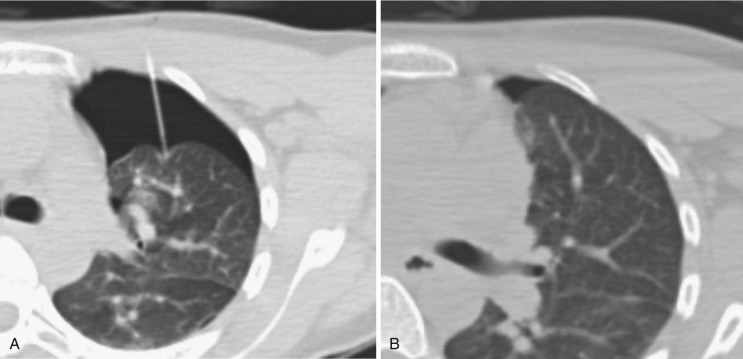
We use this approach in some patients when the pneumothorax is small and the patient has few symptoms. In such a case, if the repeat chest x-ray shows no recurrence, we discharge the patient without a chest tube as long as the patient is reasonably healthy, lives close to a healthcare facility, and does not live alone. Any recurrence or progression of the pneumothorax from the first chest x-ray (after air aspiration) to the second would prompt us to insert a chest tube.
Chest tube insertion is required if a patient becomes short of breath or the follow-up imaging shows a progressively enlarging pneumothorax, or both. It is best for an inexperienced operator to insert the chest tube under fluoroscopy, but when experience has been gained, it is important to be able to insert the tube quickly at the bedside. The placement of the chest tube is simple and can be accomplished in the following fashion. One should use an entrance site in the anterior second or third intercostal space on the side of the pneumothorax. After preparation of the site with antiseptic solution, one should thoroughly anesthetize the site down to and including the pleura. One can estimate the depth required for the tube insertion by using the anesthetic needle to aspirate air at the site.
After administration of the local anesthetic, a nick in the skin is made with a scalpel to provide ample space for the tube. As one pushes the tube through the chest wall, a “give” is noted; this indicates passage through the pleura. The tube is kept perpendicular relative to the axial plane until it passes into the pleural space. It is then angled slightly cephalad so that the tube lies in the apical lateral region ( Fig. 67-84 ). This location is optimal because in this position it would evacuate “rising” air when the patient is either lying down or standing up.
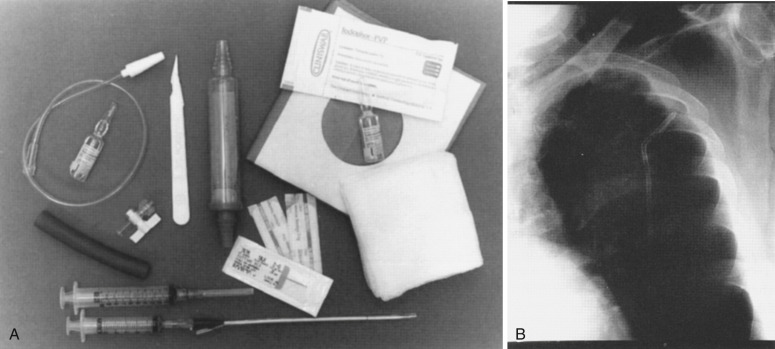
After placement of the tube, one should always reconfirm the proper location of the tube even if the placement was optimal. This can be done by checking the tube position with oblique or lateral films. Another method is to place the end of the valve close to one's ear and listen for the escape of air through the valve. After the placement of the tube, patients usually experience some pain as the lung reexpands against the tube. A single small dose of a narcotic agent relieves the discomfort, and it seldom recurs.
The tube is securely attached to the chest wall by suture and tape to prevent displacement. A complete explanation should be provided to the patient and nursing staff to prevent inappropriate or premature closure of the tube.
If the lung is reinflated for 10 to 12 hours, the tube can be removed as follows. The tube should be clamped for several hours and a repeat film taken. If the lung remains expanded, the tube can be removed. If not, the valve should be reopened for 24 hours and the procedure should be repeated later. If severe primary lung disease is present, expansion could take 2 to 3 days.
Coughing up a small amount of blood is of no great concern. In earlier times when only fluoroscopy was available and approaches were limited to direct anterior or posterior pathways, there was a higher incidence of hemoptysis. With that method, it was the accepted convention that a patient could cough up one third cup of blood without consequence.
Seeing this amount of bleeding is very disconcerting. The best management is to place the patient on oxygen and calmly reassure him or her. Repeat scans might be appropriate to ensure bleeding is not progressing. If bleeding persists, a resuscitation should be called for intubation and other supportive measures.
Treatment for intrabronchial bleeding is temporizing until a formal resuscitation can be performed with the anesthesia service. If a patient has severe hemoptysis, he or she should be placed in the ipsilateral-side-down position. This position lets blood pool in the impaired lung and protects the uninvolved lung, which is elevated. The patient should be given intranasal oxygen so that oxygenation is enhanced. An emergency page for anesthesia is appropriate so an endotracheal tube can be placed into the functioning lung. Support of the patient can be via ventilating the unimpaired lung.
Intrabronchial bleeding is a serious problem with potentially fatal consequences, so immediate action is required. The appropriate action for the radiologist is to place the patient on oxygen, prepare for cardiopulmonary resuscitation (CPR), and call an immediate resuscitation with anesthesia support. The anesthesia team should intubate the patient, placing the tube in the nonbleeding side to tamponade the bleeding in the affected side.
The complication of air embolism was uniformly fatal until more recently. Two cases reported by Lattin and colleagues and Ohashi and coworkers noted the recovery of patients who were treated with hyperbaric oxygen. Based on this limited experience, if air embolism occurs, one should administer 100% oxygen immediately and use hyperbaric oxygen if available.
Liver biopsy is a frequent procedure because the liver is commonly involved with malignant processes and because benign disorders mimic malignancy. Because specific differentiation of these various processes is impossible by imaging methods, definitive diagnosis by biopsy is necessary for planning proper patient management and avoiding unnecessary surgical procedures.
Although Lundquist showed the usefulness of blind skinny needle biopsies, guided biopsy of the liver with the skinny needle was infrequent until the introduction of real-time Doppler US and CT scanning. Rasmussen and colleagues performed the first US biopsy of the liver. Their study noted the increased diagnostic yield of US-guided skinny needle biopsy of liver masses compared with blind Menghini biopsy. The improved yield was secondary to the accurate targeting provided by US. This article is sometimes mistakenly quoted as showing the superiority of the US-guided skinny needle over the larger cutting needle guided by CT. However, this article does not even include CT-guided procedures, so any comparison or inference is not valid. Many other authors later confirmed the high accuracy of the skinny needle procedure of the liver and the US guidance.
Since the first CT biopsy of the liver by our group, a large body of experience with the skinny needle and larger cutting needles has accumulated. Haaga and colleagues, Ferrucci and associates, and Iselin and colleagues, among others, confirmed that CT-guided skinny needle procedures are effective for the diagnosis of many primary and metastatic malignancies. During direct comparisons of the skinny needles and cutting needles, Haaga and colleagues and Ha and coworkers confirmed the usefulness of the skinny needle and noted additional advantages with the larger cutting needles. Currently, US and CT are used for the performance of biopsies using large cutting needles. US guidance is adequate for easily visualized lesions, but for more difficult or complicated cases, CT is the modality of choice because of advantages associated with guidance and diagnostic scanning (see later).
Pagani investigated the significance of needle caliber on the diagnostic yield and complication rate of aspiration biopsy of liver masses. With CT techniques, he found that there was an increased diagnostic yield with the larger needle and no difference in complication rate (see “ Diagnostic Accuracy ,” later).
The topic of new cancer initiatives is discussed in this section because of the common occurrence of cancer in the liver and the feasibility of obtaining substantial core biopsies for tissue assay. In recent years with the development of new sophisticated treatments for cancer, a new approach for cancer drug development and treatment has evolved based on acquisition of biopsy tissue. The success of this new approach is contingent on obtaining sufficient tissue for assays. These initiatives have focused on the ability to measure molecules and microchemistries of tissue samples.
From the tissue samples, microassays are performed to determine the presence and effectiveness of the administered drug. Using these methods, remarkable findings have revolutionized the outcome of such studies. Probably the greatest testimony to this trend is the change in the vernacular for cancer therapy. Previously researchers would talk about the MTD (maximum tolerable dose), whereas they now talk about the OMD (optimal modulatory dose) of the chosen drug or modulating agent.
Because the success of these methods depends on acquisition of adequate tissue, we encourage physicians to become familiar with core biopsy needles of various sizes, including 18-gauge and 14-gauge needles. In the future, cancer patients are likely to undergo repetitive biopsies over the course of their treatment to assay drug, change drug therapy, and modulate treatment based on such samples. The approach would be similar to that of sampling and treatment of infectious agents that occur in abscesses or blood cultures. Although these methods are currently used only in study protocols, it is likely they will enter the general clinical community in coming years.
The indications are broad, considering the diagnostic and guidance accuracy of US and CT. Any patient with a focal hepatic mass or unusual anatomic configuration should have a guided rather than a blind procedure. Diffuse processes of the liver are probably best performed by US or a transjugular approach if the coagulation factors are abnormal. Most clinicians have abandoned the unguided bedside method.
Contraindications are few and consist of uncorrectable coagulopathy, numerous varices or collateral vessels obscuring the lesion, unusual anatomic location within the porta hepatis or adjacent to venae cavae, hypervascularity of the lesion, and inability of the patient to cooperate. Although hemostasis is now possible using the technique described previously, it is unlikely hemostasis would be effective if a large vessel were cut. Some masses are too vascular to biopsy safely and should be triaged for laparoscopic biopsy ( Fig. 67-85 ). Lesions that may be too vascular include focal nodular hyperplasia, hepatomas, hemangiomas, sarcomas, and metastases (see Chapter 44 ). The issue of poor cooperation can be remedied by deep or general anesthesia.
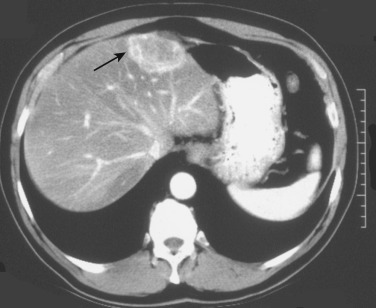
The presence of ascites is not a contraindication for biopsy. Murphy and colleagues reported a group of patients who had liver biopsies, some with ascites and others without. The complication rate in the patients who had ascites (32%) was less than that in the patients who did not have ascites (43%). This was not statistically significant, but the converse must be true; there were no increased complications associated with the presence of ascites ( Fig. 67-86 ).
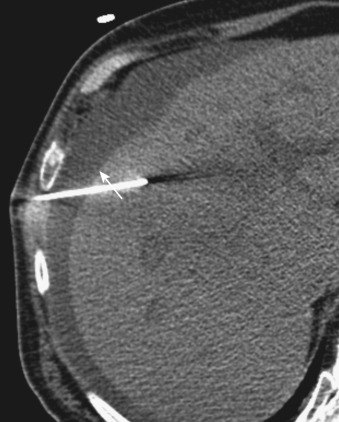
Patient history and diagnostic scans are reviewed and informed consent obtained as noted in the earlier general section. Review of patient history, including liver failure, bleeding issues, and current medications, is important. Laboratory studies should be assessed to evaluate for coagulopathy; if issues exist, they can be addressed as noted earlier under “Coagulopathic Treatment.” Abnormal liver function should alert the radiologist to be observant for any capsular varices or typical varices that might be subject to bleeding if inadvertently damaged. Laboratory values for CBC and coagulation factors should be suitable, as discussed earlier.
Most liver biopsies can be performed as an outpatient procedure, assuming inpatient facilities are available as needed. After studying a series of 1000 patients, Perrault and coworkers advocated that virtually all liver biopsies can be performed as outpatient procedures if there are no complicating factors. Appropriate consent should be obtained and documented.
Review of prior scans helps preplan the procedure relative to possible approaches and patient positions. It saves time to pre-position the patient if a position other than supine is to be used. Any enhanced CT scan may show vascularity and other anatomic features that are important.
PET scan can show metabolically active areas ( Fig. 67-87A and B ) or necrotic areas for target planning, but prior surgery or ablation may produce findings suggesting neoplasm. Metastatic lesions are typically positive, but hepatocellular carcinoma may have a high false-positive rate. In some unusual cases, tumors may alter their metabolism so as not to consume glucose and may be PET negative (see Fig. 67-87C through E ) even if the biopsy is positive; any rapidly growing mass should be biopsied (see Fig. 67-87F ).
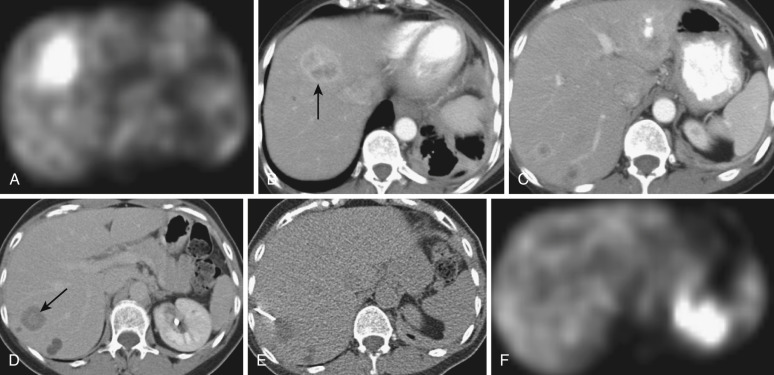
Hepatocellular carcinoma is less amenable to evaluation by PET using FDG. Many authors report an accuracy of detection ranging from 50% to 75%, and others have reported that FDG uptake correlates well with poorly differentiated tumors and tumors with fibrosis. In postoperative patients with increasing α-fetoprotein (AFP), Chen and associates found that 71% could be detected with FDG PET. In addition to FDG tracers for PET, other authors have reported the use of acetate and choline derivatives with good results. Additional studies are indicated before the role of these new agents can be defined.
Choice of modality between US, MRI, or CT must be made by the individual physician, but CT generally is still considered the gold standard. Difficult anatomic location, poor visualization under US, or concern about increased vascularity is a clear indication for CT guidance.
With increasing expertise, modern US refinements, and increased demand on CT scanning time, routine mass biopsies most often should be performed with US guidance. Cases that are difficult to visualize and access because of location or large body size are well suited to CT. Lesions in precarious locations, such as adjacent to the portal vein, gallbladder, diaphragm, or other site, may be triaged for CT guidance. Biopsy of patients with abnormal coagulopathy should be performed with CT or combined with fluoroscopy so that a hemostatic method can be used should bleeding occur. The changes produced by bleeding and coil insertion make US less useful for performance of the hemostatic coaxial/coil/thrombin technique.
During the procedure, vital signs, neurologic status, and pulse oximetry should be monitored. Analgesics and sedative medications can be administered as needed (see earlier under “ Patient Cooperation and Sedation ”).
A diagnostic series of scans is taken in anticipation of the procedure. From the current scans, the mass referred for biopsy is reevaluated. If the lesion is stable or larger, the procedure should proceed. If the lesion is significantly smaller, one should consider deferring the procedure until a later date after follow-up scans are performed. Triage to MRI or US likely should be performed if the mass cannot be well visualized on CT.
One selects the tentative target for biopsy and the appropriate pathway for the trajectory. If the mass is large, one selects a portion of the mass that is not necrotic and attempts to target a site at the interface of the tumor and normal tissue. In many cases, especially with primary liver tumors, the transitional area may provide more diagnostic information to differentiate the various cirrhotic nodules associated with transition from dysplastic tissue to neoplasm ( Fig. 67-88 ).
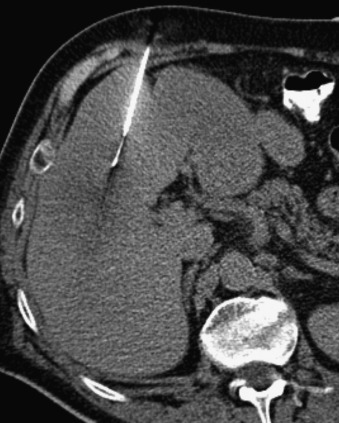
The trajectory pathway should be planned as follows. If the lesion appears mobile, which is common close to the diaphragm, the patient can be positioned with the ipsilateral side down, which may lessen motion of the diaphragm. The pathway should provide a small cuff of normal tissue (which tamponades any possible bleeding and prevents tumor seeding in needle track) and yet minimize the pathway through the liver.
Capsular lesions should not be approached directly but have an angled approach, including a cuff of normal liver (see Fig. 67-88 ); this has been shown to prevent tumor seeding and reduce the probability of bleeding (see “ Complications and Factors Affecting Incidence ,” later). The diaphragm and pleural space should be avoided if possible; it is best never to have a pathway more posterior than the midaxillary line or to use patient position to better display the pleural space ( Fig. 67-89 ). Although some operators have used the transdiaphragmatic approach, we do not recommend it.
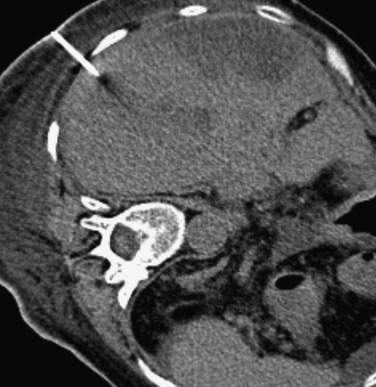
Bolus dynamic contrast scan over the chosen target site should be performed to visualize and avoid any significant-sized vessels ( Figs. 67-90 and 67-91 ) and exclude excessive vascularity, as noted in the contraindications section. Lesions such as hemangiomas ( Fig. 67-92 ) can be detected and the procedure terminated. Intensely vascular lesions may bleed even with FNA ( Fig. 67-93 ) and cause complications.
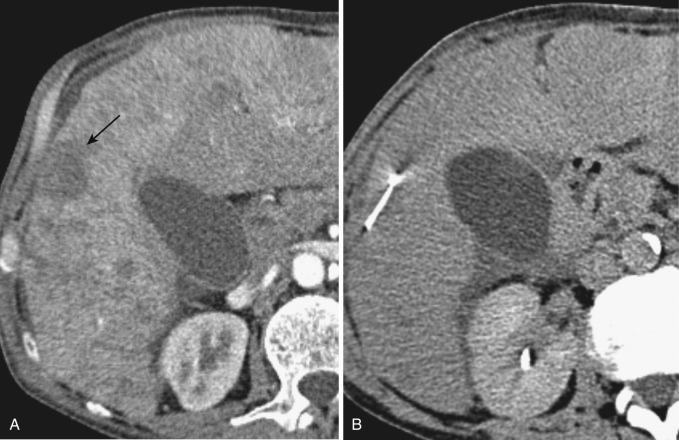
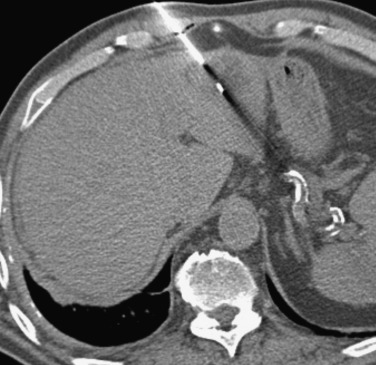
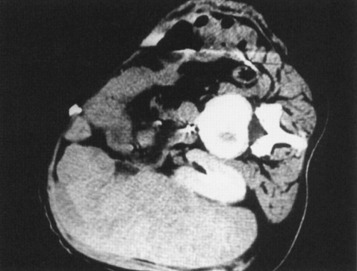
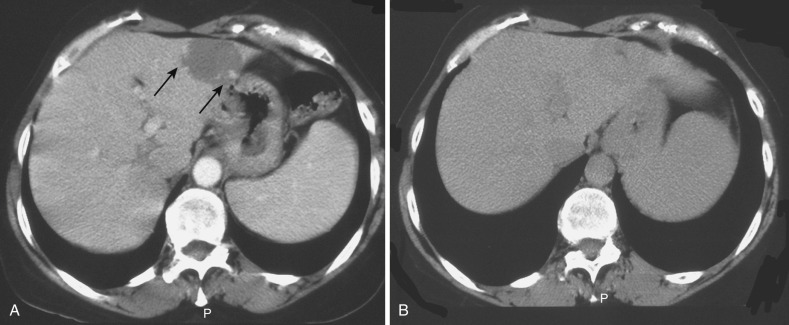
The choice of needles is based on the clinical history of malignancy, accessibility of the lesion, vascularity of the lesion, and type of tissue sample required. The choices are as noted in the earlier section on FNA for cytology or a cutting needle for larger amounts of tissue (accuracy of tissue recovery and steps to improve outcome are discussed later).
If the patient has had a proven malignancy and there is need only for confirmation of recurrence, FNA is adequate. If lesions are hypervascular, FNA is preferred over cutting needles, but even then issues may arise (see earlier). If the patient has an undiagnosed tumor or additional tissue is being obtained for further characterization and analysis to select chemotherapy or other course of treatment, a cutting needle is appropriate. The caliber of the cutting needle can be chosen according to the amount of tissue needed for analysis, experience of the interventionalist, and concern for complications. The relative amount of tissue acquired and the associated bleeding are presented in Tables 67-3 and 67-4 .
| Comparison | Blood Loss (g) | Blood Loss (g) with Amount of DNA per Sample (µg) | Blood Loss (g) with Needle Chamber Volume (mm 3 ) | Blood Loss (g) with Amount of DNA per Sample (µg) and with Needle Chamber Volume (mm 3 ) |
|---|---|---|---|---|
| 14 vs. 18 gauge | .025 * | .24 | .14 | .002 † |
| 18 vs. 20 gauge | .059 | .76 | .42 | .025 * |
| 14 vs. 20 gauge | <.001 † | .47 | .07 | .007 † |
| Factor | Hemorrhagic Complication Rate (%) * | Increased Risk of Hemorrhagic Complications | P Value † |
|---|---|---|---|
| Hemodialysis | |||
| No | 5.9 (13/220) | — | <.025 |
| Yes | 24 (5/21) | ×4.1 | |
| Patient sex | |||
| Male | 4.5 (7/156) | — | <.01 |
| Female | 13 (11/85) | ×2.9 | |
| Side of biopsy | |||
| Right | 5.2 (8/155) | — | <.01 |
| Left | 14 (12/86) | ×2.7 | |
| Pretreatment with desmopressin acetate | |||
| No | 6.4 (15/236) | — | <.001 |
| Yes | 60 (3/5) | ×9.4 |
* Numbers in parentheses are actual number of patients with hemorrhagic complications per total number of patients in each subgroup.
† P values indicate the significance of the difference in complication rates for each set of paired values.
Of the needle techniques described earlier, the coaxial system should be used regardless of the needle type chosen. As noted earlier, with greater dissemination of liver lesions, numerous cases of tumor seeding have been reported. The choice of a cuff of normal liver and the coaxial method have been shown to prevent tumor seeding (see “ Complications and Factors Affecting Incidence ,” later).
When the tentative trajectory and entrance site are chosen, a marker is placed on the skin and a repeat scan is performed to see the marker relative to the pathway. The marker may be a purchased device or a hypodermic needle in the package.
After one has selected a tentative entrance point and before needle insertion, one should carefully inspect the chest at the entrance site for several problems. If the patient has cirrhosis, one should inspect the site for any collateral veins, which may form secondary to portal systemic collaterals, such as a caput medusae.
The ribs should be palpated to find the intercostal space, and the entrance site should be moved if necessary to avoid ribs. One should not attempt to anesthetize a site that is not over an intercostal space. First, pricking the periosteum of the rib is very painful to the patient, and his or her confidence in the radiologist and personal cooperation may be lost by this painful experience. Second, if one does not move the site, a successful procedure is unlikely because attempts to “angle” around a rib or leverage against it seldom work well, and the procedure would be prolonged and likely unsuccessful.
Careful antiseptic preparation of the skin is important. Proper administration of lidocaine to produce a “painless” procedure, as noted earlier in the general section, is important. When the area is anesthetized, it is important to infiltrate anesthetic through the subcutaneous tissues and down to and including the capsule of the liver. Adequate anesthesia of the capsule makes the procedure virtually pain free and permits insertion of the needle without the patient's moving because of pain. If a rib is inadvertently hit during the initial anesthetic administration, we give a small bolus of lidocaine on the rib; this prevents any recurrence of pain if that area is struck again during the procedure.
The appropriate needle, either FNA or a cutting needle, is selected using the factors discussed earlier. The needle is inserted with incremental steps and adjusted until placement of the needle in the target site is accomplished. The patient is asked to hold his or her breath during each movement of the needle. If the lesion and needle are in the same axis, the procedure is usually straightforward, but if not, the angled methods noted earlier are appropriate.
With the aspiration needle, localization of the tip precisely in the chosen site is important if adequate cellular material is to be obtained. If a cutting needle is being used, one should adjust the position of the needle and stylet so the chosen area is included in the gap (see Fig. 67-88 ). If the stylet is not properly positioned, one can try the maneuvers noted in the early section to position the stylet better; intentional deflection, coaxial manipulation, or rotation of the needle may be performed (see Figs. 67-44 through 67-47 ). During needle insertion and sample acquisition, whenever the needle is moved, the patient should be asked to suspend respiration. Not doing so may cause shearing of the capsule and cause a complication.
The sample should be acquired as noted previously in the general section technique. We routinely take only a single needle pass unless there has been an error in the technique or a poor sample obtained on visual inspection. If a proper sample is not obtained with FNA, we move up to a 20-gauge cutting needle at the same session. If a special sample has been requested for flow cytometry, DNA analysis, or microchemistries, larger needles such as 15 gauge or 14 gauge may be used and as many samples taken as needed (see Tables 67-3 and 67-4 ).
The coaxial system is left in place until the multiple samples are obtained. If the site seems to be bleeding, we suggest using the coaxial/coil/thrombin hemostatic method described earlier (see Fig. 67-32 ). If local injection of blood products is being used, another aliquot of FFP or platelets should be injected into the site as the coaxial system is withdrawn (see Fig. 67-31 ). The coaxial cannula is withdrawn and a repeat scan is performed to assess for bleeding.
Before removing the patient from the table, we take a repeat scan to evaluate for postprocedure problems. If any hematoma is noted, the clinical team is contacted and a type and crossmatch of blood products may be ordered if there is a concern that the bleeding is significant.
The postprocedure care of these patients is simple and consists of observing them for abdominal discomfort and monitoring vital signs for possible bleeding. The patient is kept on bed rest for 4 hours. Vital signs are checked every 15 minutes for 1 hour, every 30 minutes for 1 hour, and every hour for the next 2 hours. After 4 hours, if no issues arise, the outpatient can be discharged home with appropriate instructions. Patients should be instructed to rest quietly at home for 1 day with no strenuous activity. If any pain or other symptoms develop, the patient should seek medical attention.
The success of percutaneous liver biopsy by CT guidance depends on the various important factors noted earlier. In our experience, the success rate for malignancy and benign disease has varied according to the type of needle used and the abnormality being sought. Looking at the literature, the average success rate for sampling all malignant disease with aspiration needles is 77.6%, and for cutting needles it is 90.2%. The success rate for benign disease is 39.4% with aspiration needles and 88.5% with cutting needles. With individual techniques and as experience has been gained, the diagnostic accuracy has increased.
Historically, guided biopsy procedures are superior to blind or unguided biopsy procedures. According to Conn and Yesner, blind biopsy positivity depended on the large amount of disease present, so such a random biopsy had a greater probability of being positive if extensive disease was present. Lundquist did his first biopsies without guidance by palpating the masses through the skin surface for localization.
Rasmussen and colleagues reported the first series on US biopsy using a 22-gauge needle with multiple passes. They recovered positive tissue in 70% of cases with US guidance compared with an anticipated rate of 23% for blind biopsies (extrapolating Conn's classification of his cases as described in the report). Subsequent reports showed similar results, with success rates ranging from 66% and 94%. All of the comparison articles concerning diagnostic yield from aspiration and cutting needles (single passes) have shown that cutting needles are superior to aspiration needles. The two comparison articles using a single pass were reported by our group. Martino and associates showed that the diagnostic yield of Menghini and Tru-Cut biopsy needles was 88.1% compared with 60.9% for 22-gauge aspiration needles. Our more recent experience reported by Ha and colleagues showed the 14-gauge Tru-Cut needle to be superior to the 20-gauge aspiration needle, with yields of 90.2% compared with 77.6%. A comparison article by Jacobsen and coworkers showed a slightly greater accuracy with a skinny needle ; however, their comparison was flawed by the fact that they took three passes with the skinny needle and only one with the cutting needle.
For benign disease, all reporting authors have shown a clear advantage for the cutting types of needles relative to determining specific disease processes. In our more recent experience reported by Ha and colleagues, the cutting needles provided a specific diagnosis in 88.5%, compared with 39.4% for aspiration needles; nonspecific diagnosis was provided in 11.5% by the cutting needle and 48.8% by the aspiration needle.
The combination of slide smears and histology can provide an added increment of positivity for the results. Numerous authors, including ourselves, attest to the benefit of combining aspirate samples with cell block histology. In the study by Ha and colleagues, the addition of cell block histology increased diagnostic yield from 54.8% to 77.4%.
Many factors affect the diagnostic results from liver biopsies. In our own experience with FNA needles, we limit our needle passes to two in virtually all cases. The expected yield should be about 75% to 85%. These factors include (1) extent of disease in liver and size of lesions, (2) type and size of needle used, (3) proper technique, (4) number of needle passes, (5) experience of the interventionalist, and (6) choice of modality.
The extent of disease has a great impact on biopsy results. If mass lesions are large, numerous, and accessible, the chances of a positive biopsy are greater. Conn and Yesner studied this factor with a series of blind biopsies performed on cadaver livers at autopsy. They graded the degree of involvement of the liver by the number of lesions and found the following recovery accuracy: grade I, 1 to 3 lesions, had a 16% success rate; grade II, 4 to 25 lesions, had a 27% success rate; grade III, 25 to 50 lesions, had a 45% success rate; and grade IV, with greater than 50% involvement by weight, had a 86% success rate. This finding is important to consider whenever a new method, technique, or type of needle is first being reported in the literature.
Proper technique includes accurate placement of the needle's sampling portion within the lesion, application of vacuum if needed, use of the appropriate needle device, and proper recovery of the tissue sample (see earlier under “ General Procedure Steps ”). There are some variations of different aspects, and technique can and should be modified according to the preferences of the operator, but a consistent technique is crucial.
The type of needle affects outcome, with cutting needles providing greater diagnostic tissue than cytologic samples. All authors reporting the use of cutting needles reported improved diagnostic accuracy and more specific information based on sophisticated histopathologic evaluation or assays.
Automated cutting needles are better than manual types for most interventionalists. Before their introduction, cutting needles were seldom used for biopsies because only a few radiologists had the dexterity to use the standard manual devices, such as the Tru-Cut. In a survey, more than 90% of radiologists performing liver biopsies used the automated devices. Hopper and associates, in the evaluation of numerous automated devices, noted that the gold standard device with which all devices should be compared and the one as yet unsurpassed is the 14-gauge manual Tru-Cut device ; such manual devices have a long learning curve, so automated devices are preferred.
Meticulous placement of the needle is critical regardless of the guidance modality used. With a standard aspiration needle, the needle end must be in the lesion and not adjacent to it. With a side cutting needle, the tissue receptacle of the stylet should be positioned at the interface of the focal lesion, with only a small portion traversing the normal rim of tissue. Better quality pathologic interpretation is likely if an interface between normal tissue and neoplastic tissue is provided for review and staining. Also, areas of definite necrosis, more noticeable with contrast material, should be avoided.
Larger-caliber needles provide more ample tissue, enhancing pathologic interpretation. Larger samples permit recutting of samples so that different modern biomarkers can be assessed. Such biomarkers are crucial for modern oncologic treatment, which targets specific enzymes, peptides, or membrane markers. The effect of needle size on diagnostic success has been well documented for aspiration needles in in vitro and in vivo studies. Andriole and colleagues studied the yield in liver biopsy of various aspiration needles and found that in vitro there was a definite increase in the diagnostic material with the larger caliber needles. In a series of liver biopsies, Pagani reported the results of a small clinical group using 22-gauge and 18-gauge needles. Pagani found a significant improved diagnostic accuracy, 85% versus 98%, without any difference in the complication rate. In our own institution, the diagnostic yield and complication rates of various aspiration needles have been determined and compared with cutting needles; these rates were reported by Martino and associates and Ha and colleagues. With a single pass with aspiration needles and providing samples for slide smears and cell block material, the diagnostic yield for malignant disease with a 22-gauge needle was 60.9% compared with 77.6% with a 20-gauge needle. Pagani's data were based on the performance of multiple passes, and our data involved single passes, which explains their higher yields.
A laboratory study by Plecha and coworkers compared the amount of diagnostic tissue obtained with the amount of local bleeding with various calibers of Tru-Cut needles (see Tables 67-2 and 67-3 ). They found that per unit of tissue, there was slightly more bleeding with the larger 14-gauge needle than with the 20-gauge needle. The data showed further, however, that if one looks at the relative tissue yield (reflected by the quantity of DNA) compared with the blood loss, there is relatively no difference among the various needle calibers (20 gauge, 18 gauge, and 14 gauge). Theoretically if one was required to obtain a finite amount of tissue, the efficiency and risk of using a 14-gauge needle may be less. As noted earlier, the amount of bleeding per unit of diagnostic tissue is no different among the needles. Also, significant bleeding is usually the result of inadvertently striking a small artery. This is essentially a random event, so that if multiple passes with a small-caliber needle are required, there is a statistically greater chance of bleeding. Three or four passes with a 20-gauge needle may be less safe than one pass of a 14-gauge needle.
It has not been clinically determined whether multiple small-caliber Tru-Cut needles are safer to use than a single pass with a large needle. In our practice, we have had a major complication with the use of a 20-gauge Tru-Cut, which resulted in a major hemorrhage and required a surgical procedure.
Multiple needle passes increases accuracy. From these data and the data of Ferrucci and colleagues, it is clear that the more needle passes taken, the higher the diagnostic accuracy. In their series, Ferrucci's group selected 20 cases that were positive and looked at the diagnostic yield for each needle pass. The yield was 75% with one pass and 90% with two passes. (One can never expect 100% yield even with five passes, because the data were selective; in the same article, Ferrucci's overall yield was 82%.) Even with blind biopsies, the diagnostic yield increases appreciably with multiple passes.
Experience of the operator directly affects the outcome of interventional procedures. Poon and colleagues reported on procedures of the liver, including biopsy and treatment, and found lower complication rate occurs with experience.
Become a Clinical Tree membership for Full access and enjoy Unlimited articles
If you are a member. Log in here